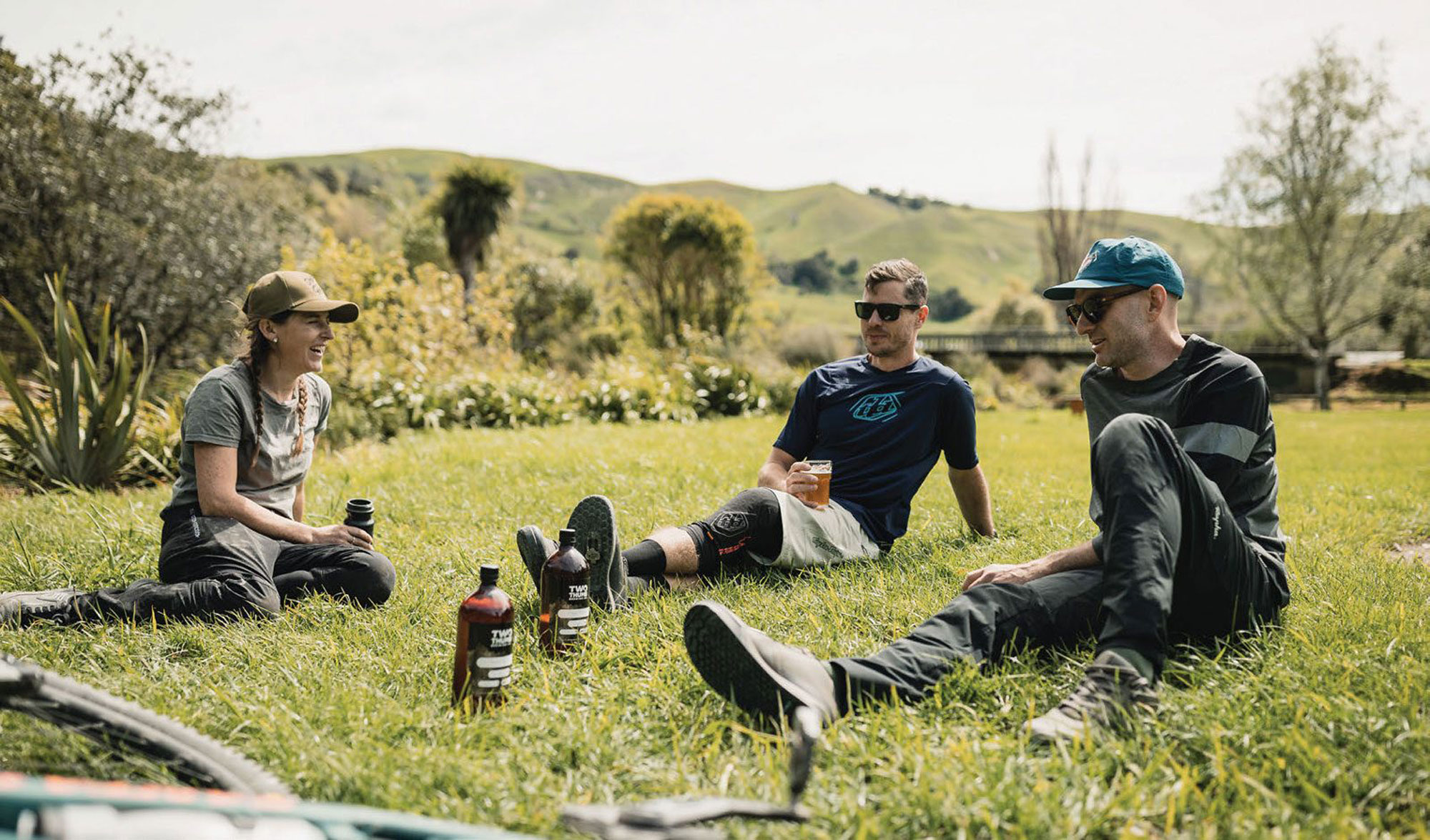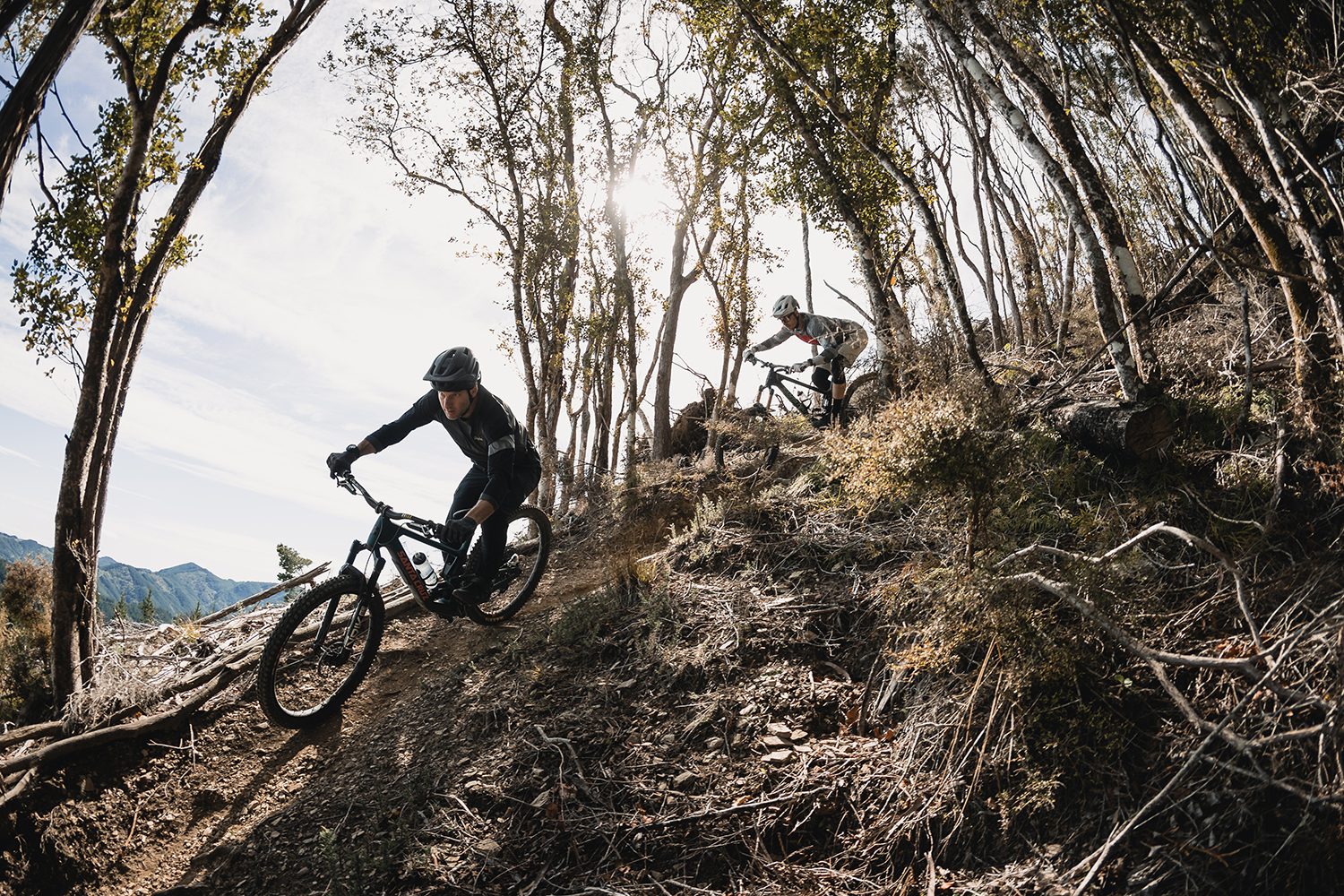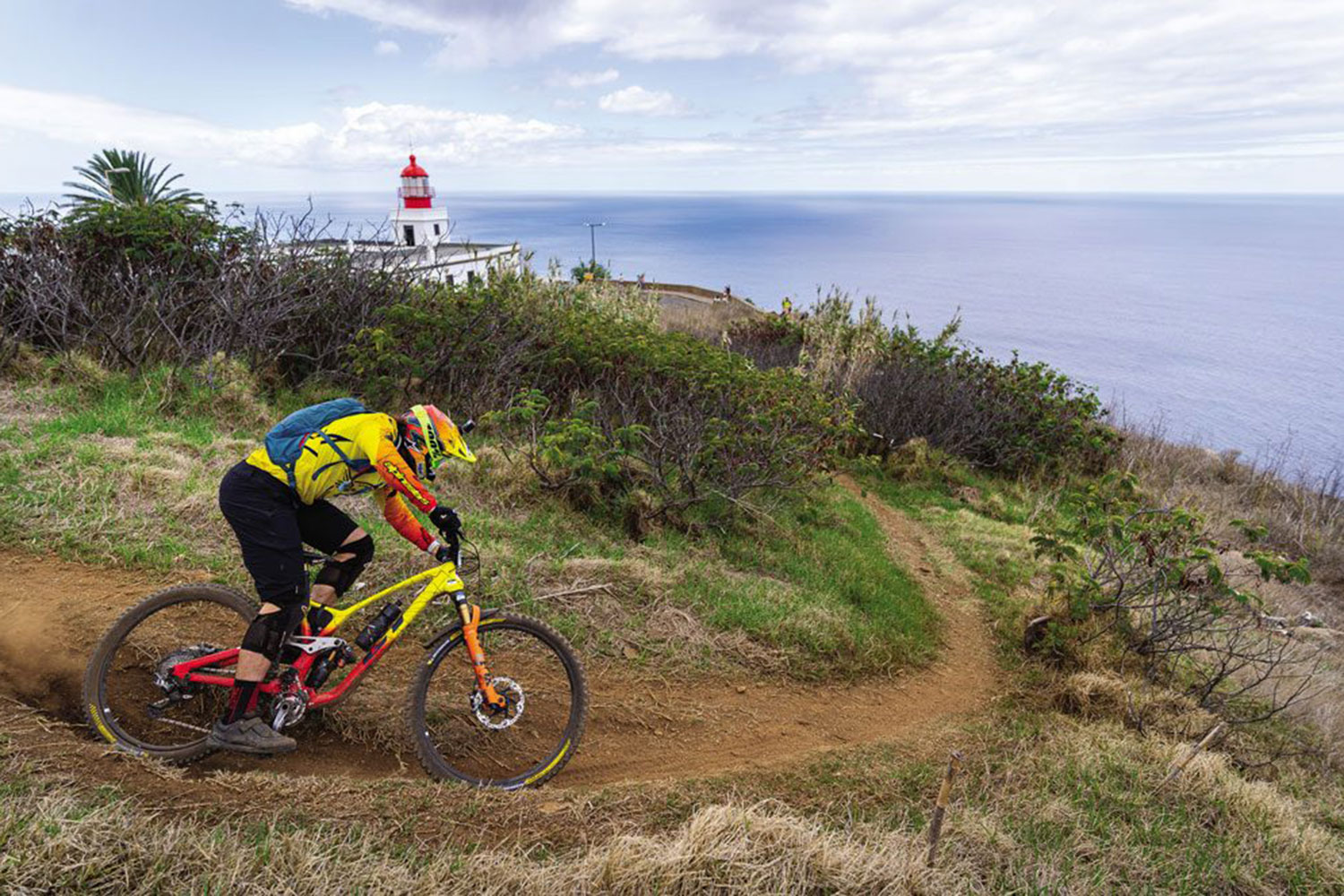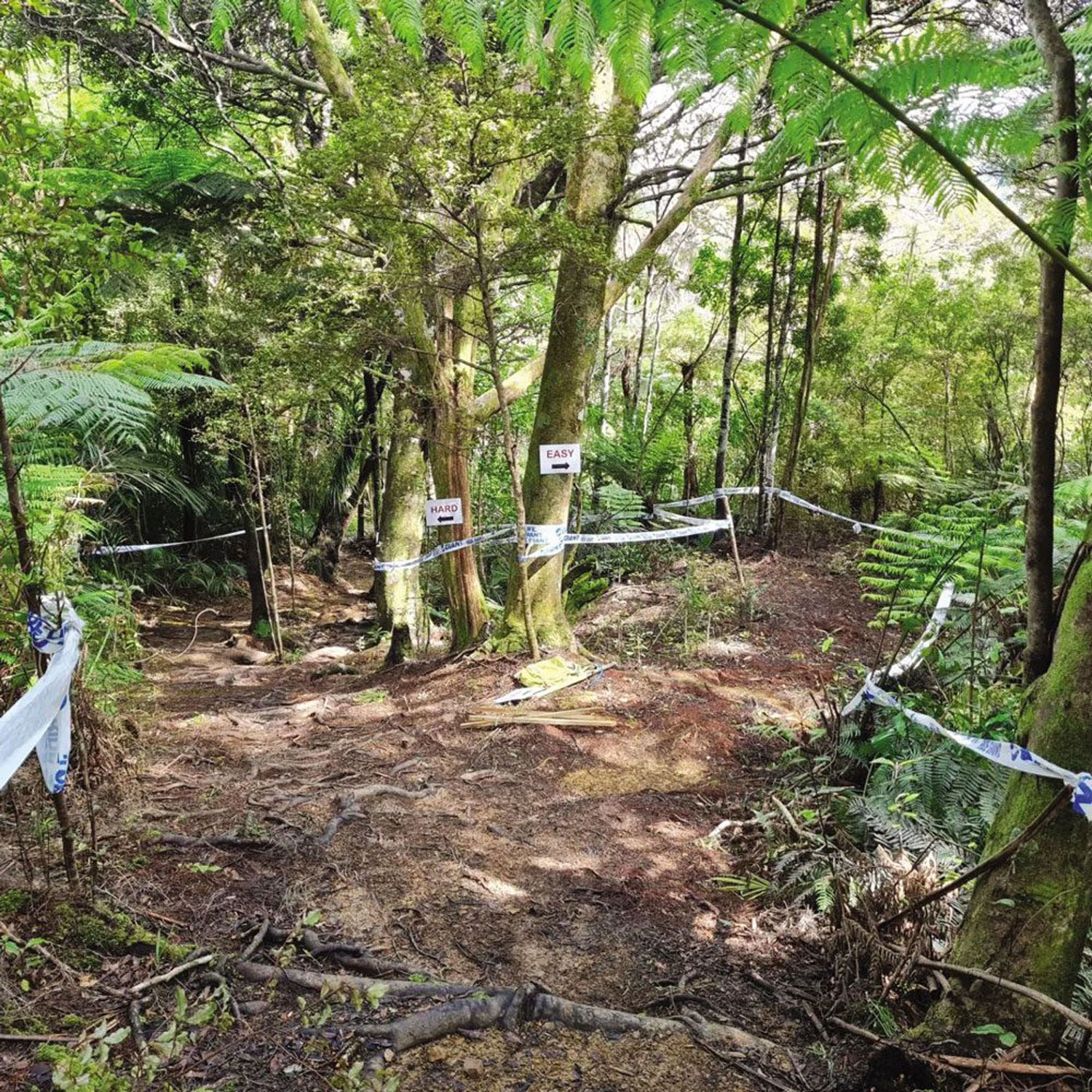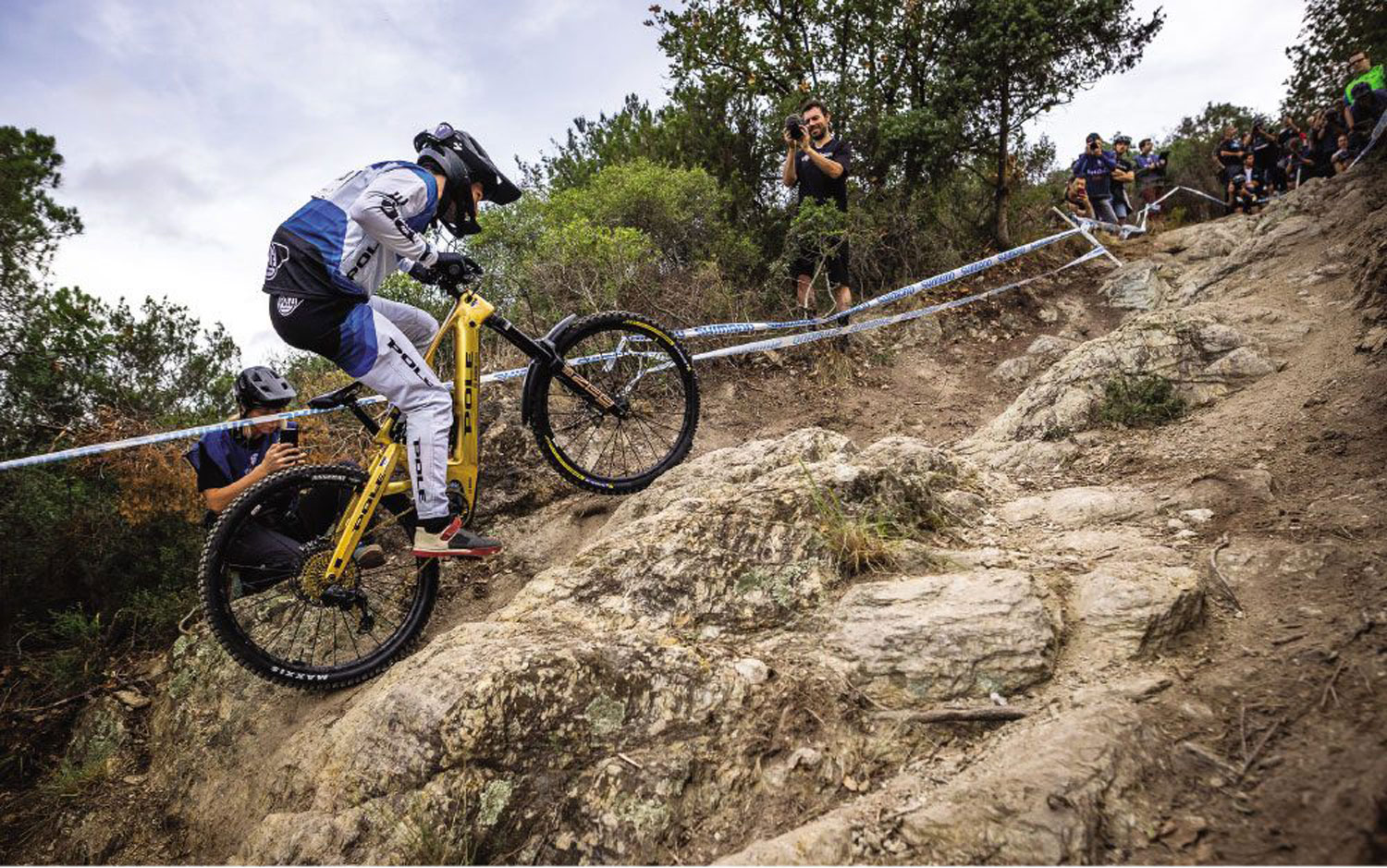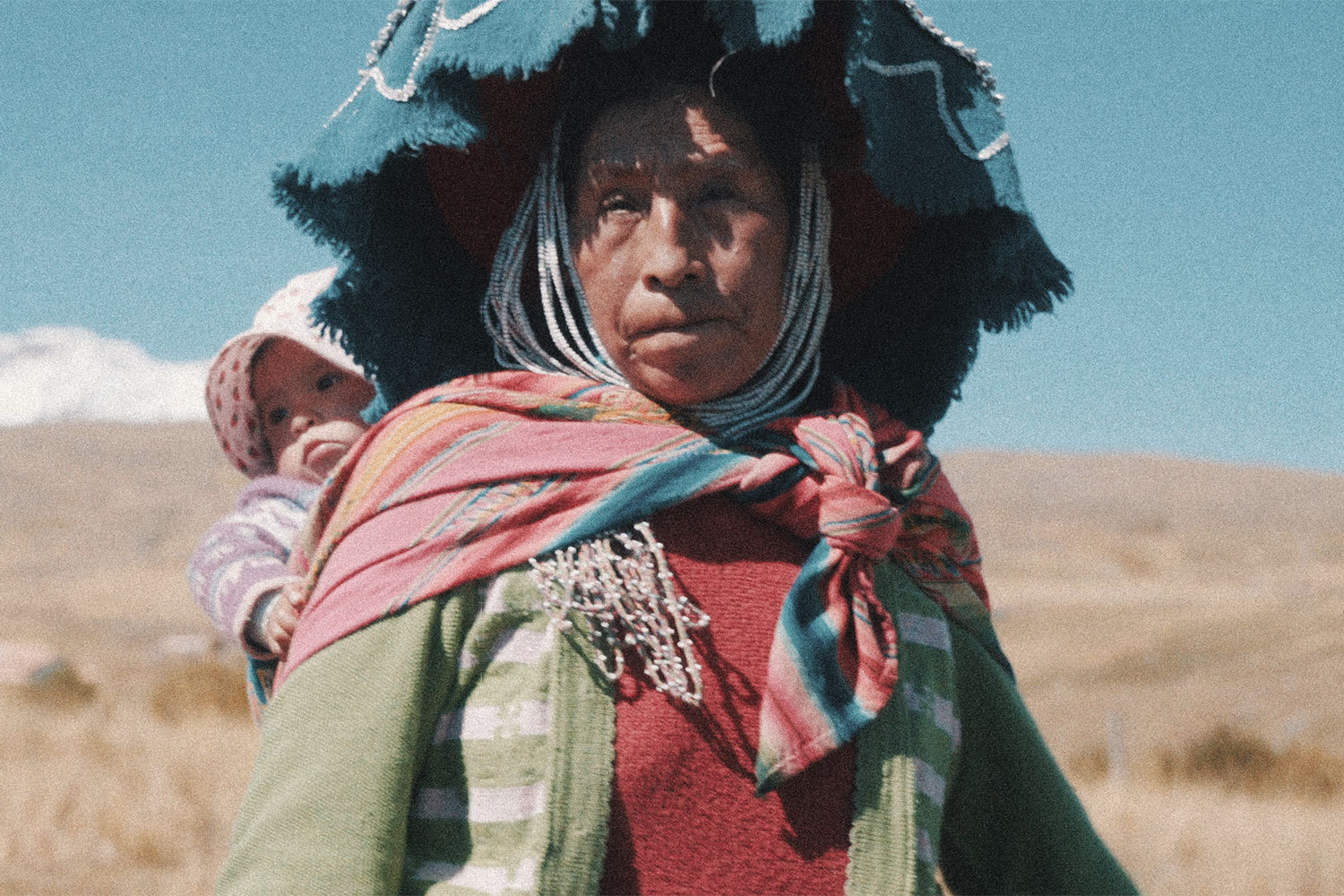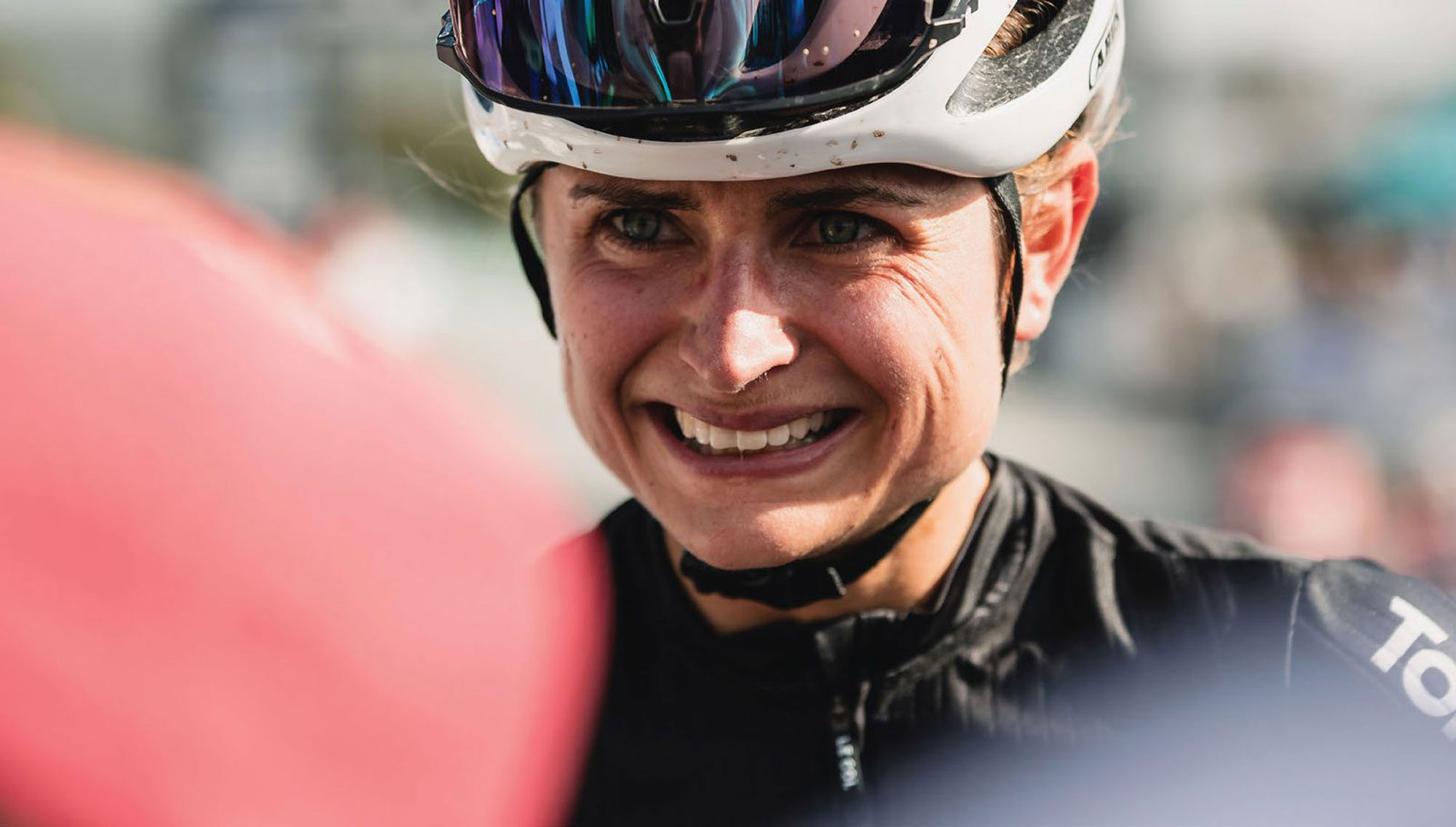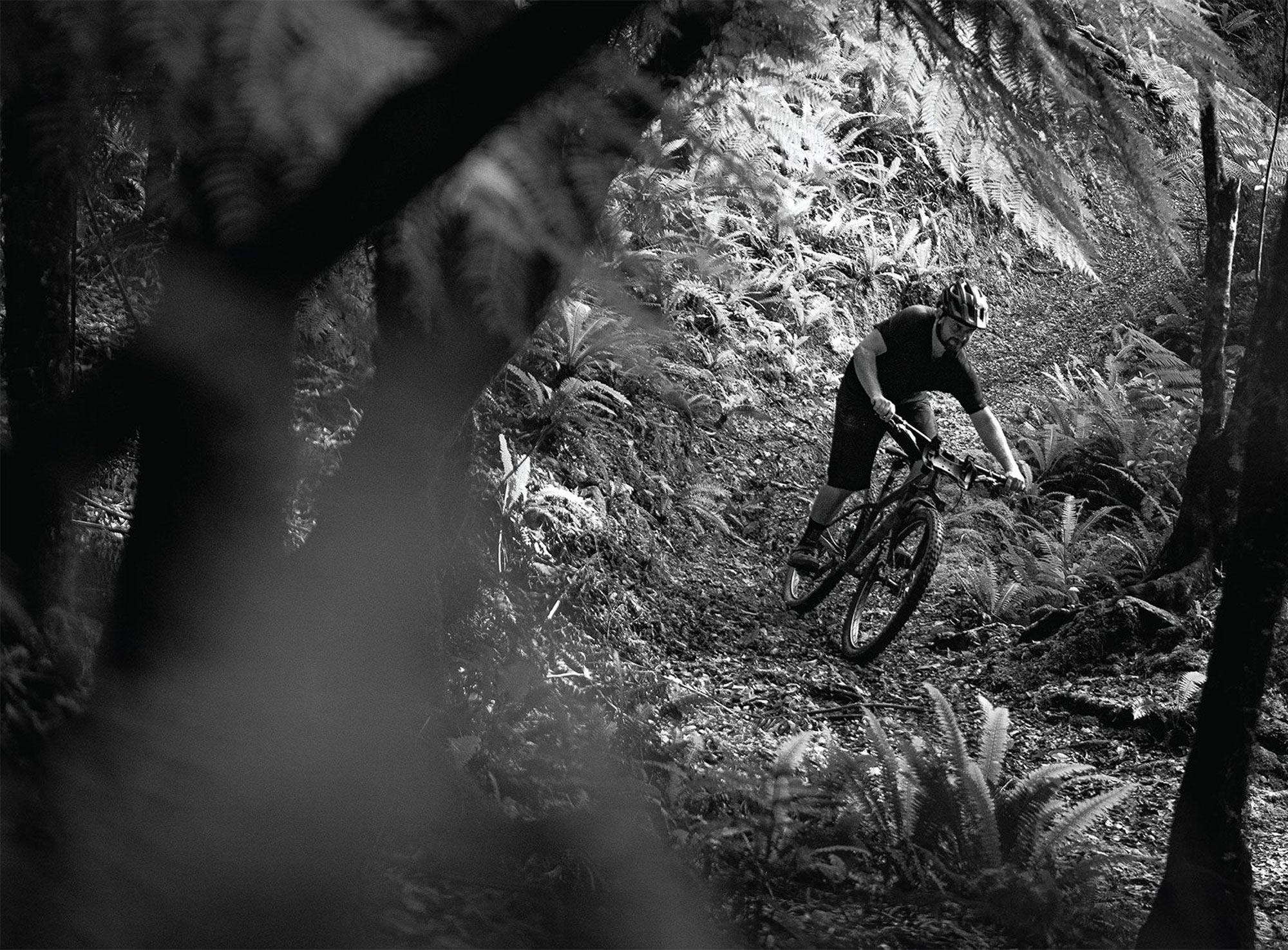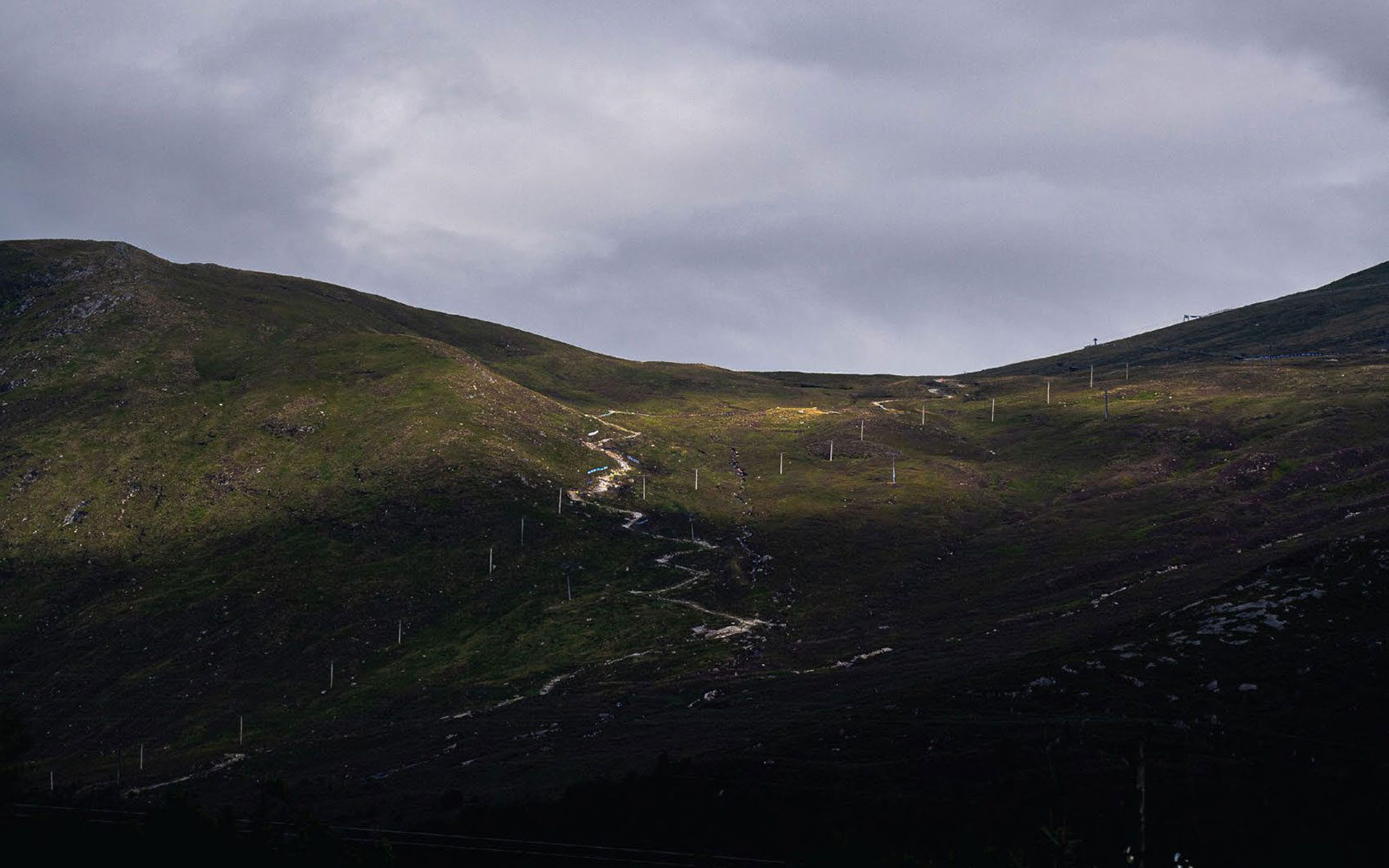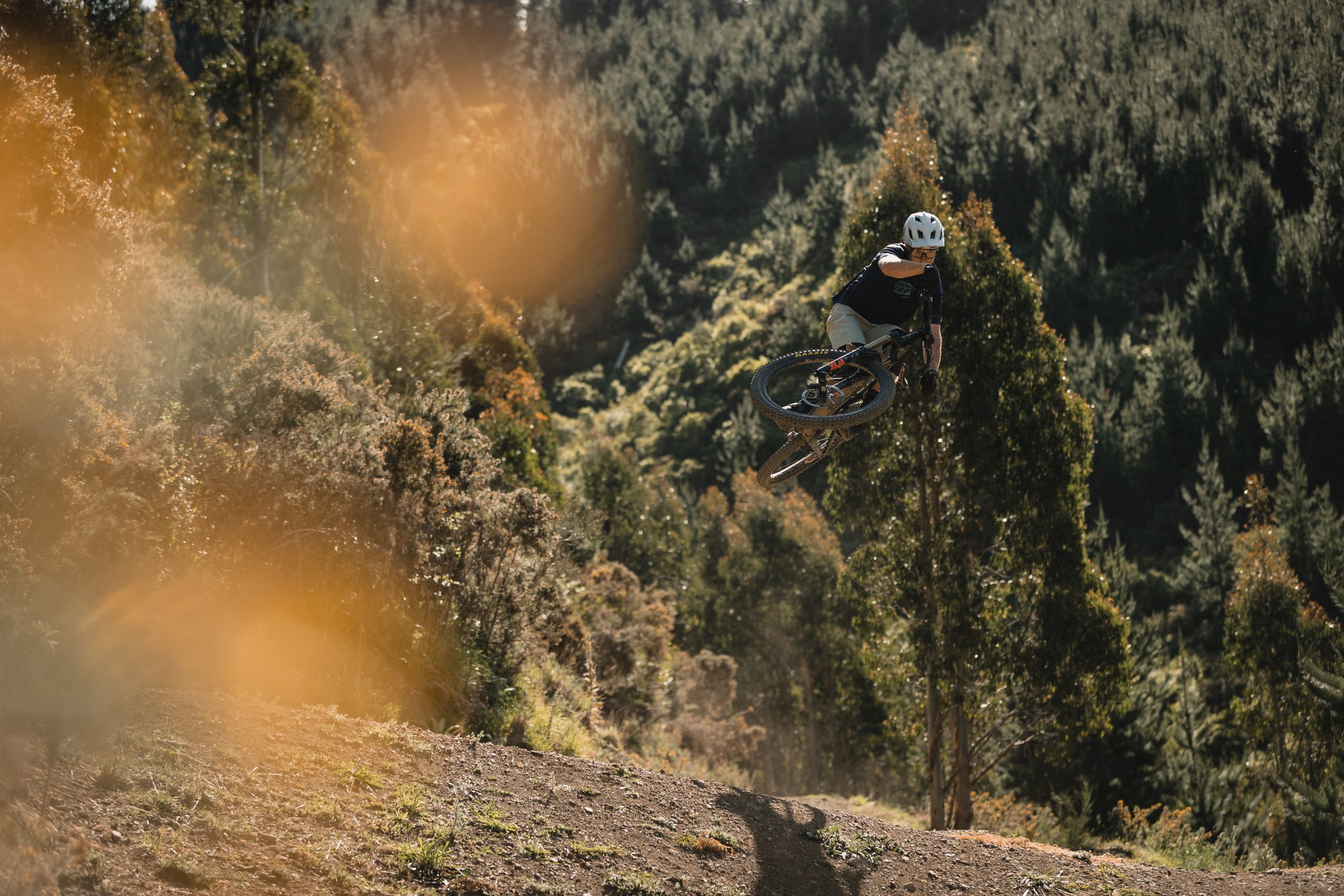Mammoth Enduro Pre-Race Guide
Words Lester Perry
Images Cameron Mackenzie
Nelson’s Mammoth Enduro is now on the horizon and having visited Nelson in our last issue to check out some of the trails, now we’re diving into some specifics around the event and how you can get the most out of it.
Thanks to intel from the Nelson MTB Club events team, we now know we’ll be presented with a 60km route – 38km of this will be pedalled, the remainder shuttled. Six stages are accessed by roughly 1700m vertical of pedalled climbing combined with two shuttles, giving riders a total descent of over 2500 vertical metres of forearm-destroying race stages. The longest stage comes with a 723m descent over its 3.3km length. This will be gravity enduro at its finest.
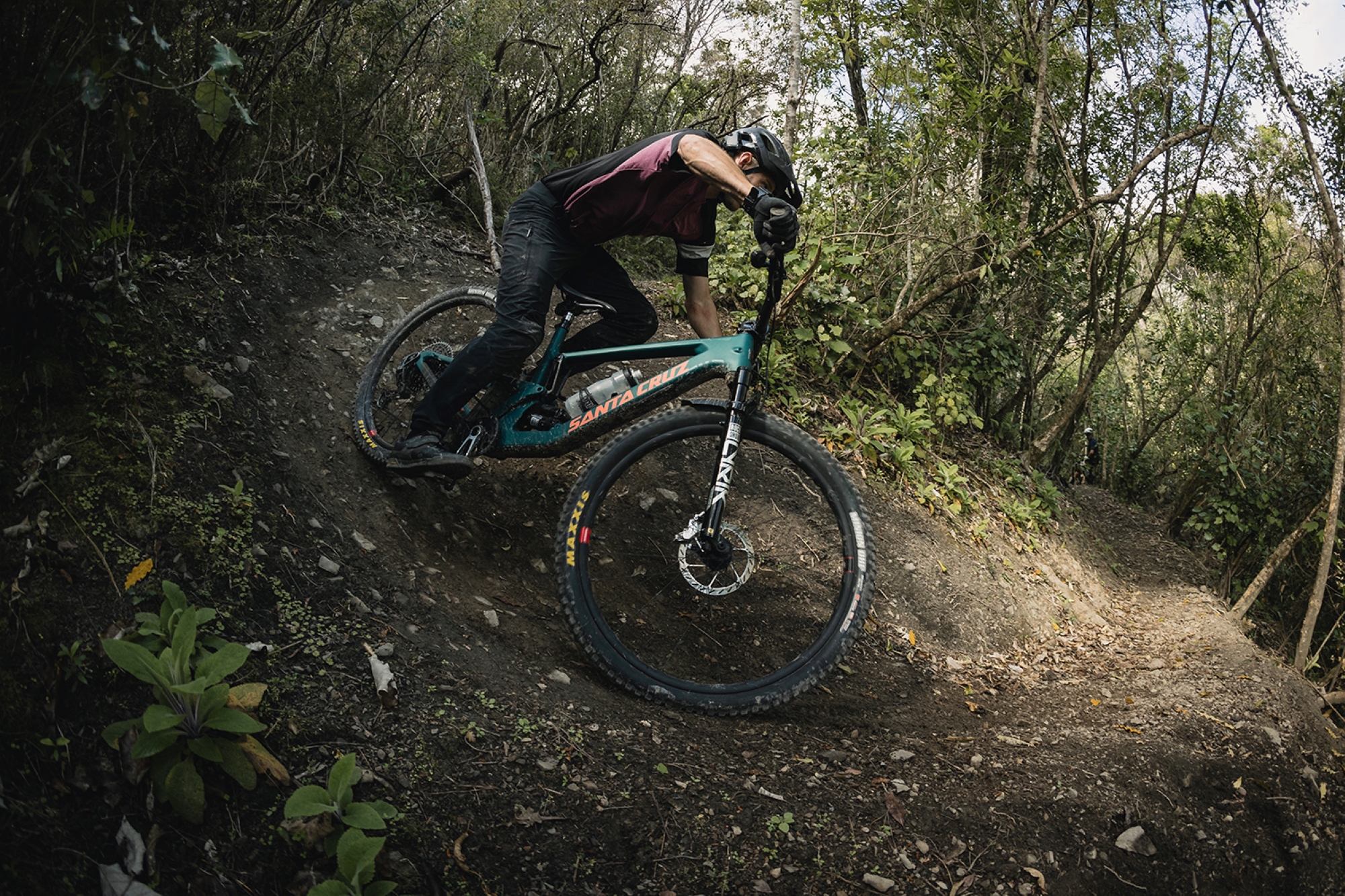
Here’s how the race will shape up:
Monday 18 March 2024
Course released on Monday 18th March and trails open to ride.
Friday 22 March 2024
The course is open to practice. An ‘optional shuttle’ will be available to practice stage 1 only.
Saturday 23 March 2024
Shuttled Practice 8 am – 3 pm (2x shuttles)
Race Stage 1
Sunday 24 March 2024
Race Stages 2-6
2 x feed stations on the course
Two shuttles per rider and pedal between stages
Race Village is situated at the Maitai Hub and Golf Club rooms. Set times for lunch and shuttles. There will not be any time penalties for liaisons.
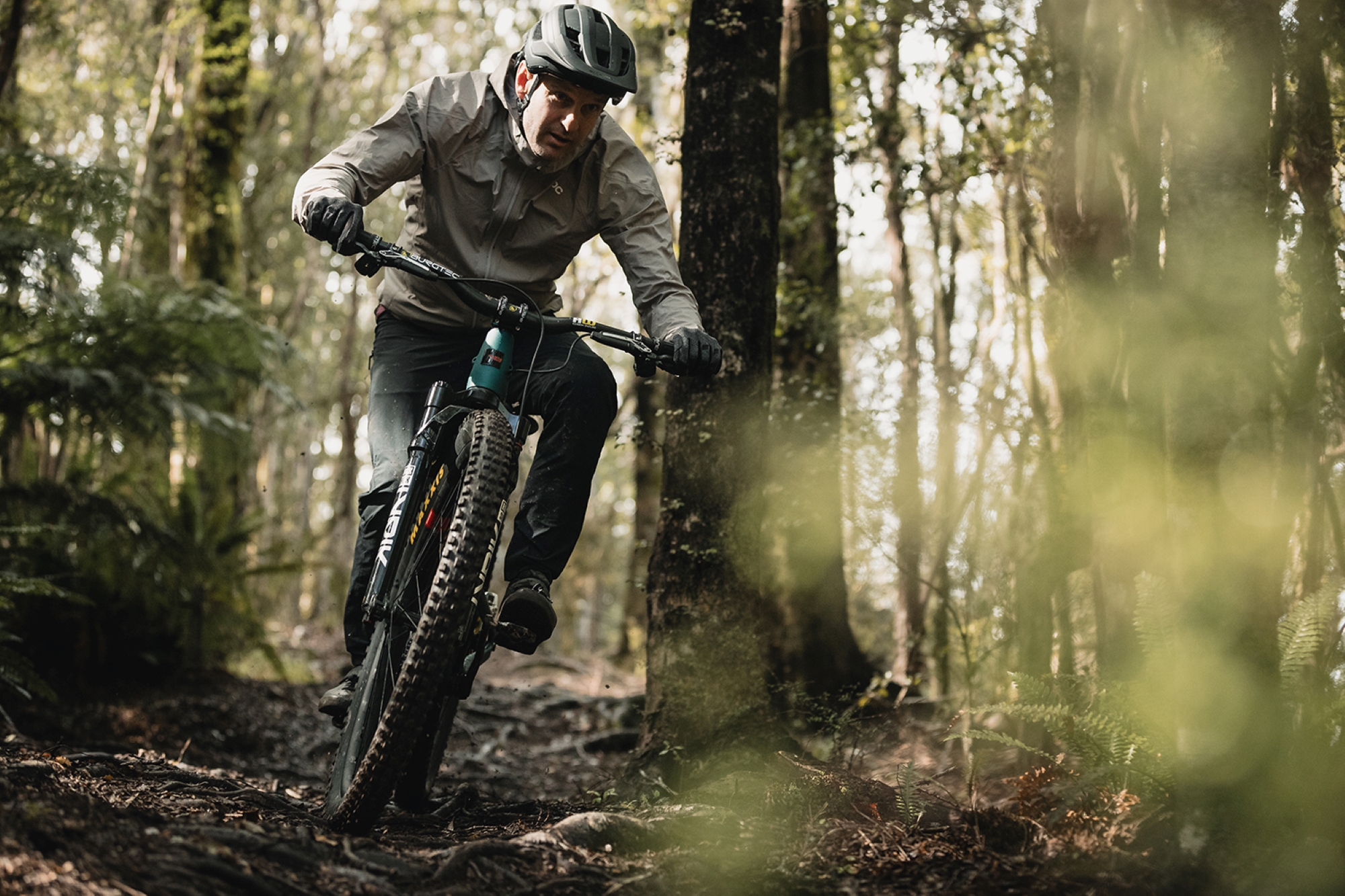
Nelson Trails don’t suffer fools. If your body or bike isn’t up to the task, the Mammoth will chew you up and spit you out onto one of its rock and root-strewn trails. Fortunately, there are a few low-key steps that can be taken to ensure you’re prepared for race day. Although Nelson’s toughest tracks can be tackled on a hardtail if the rider and bike are up to the task, the optimal bike for an event like the Mammoth is one with big travel and big brakes. You’ll likely have to run whatever is currently in the shed, so options may be limited, but given the choice, the ideal bike would have more than 150mm of travel front and rear, and grunty 4-piston brakes with fresh pads and large rotors to match.
Tyre setup is a constant topic of conversation leading into any enduro race. Width, tread pattern, casing thickness and rubber compound; there’s nothing like some good pre-race tyre chat. A big day like the Mammoth isn’t the time to be testing a new setup or rolling the dice by going for lightweight or rolling speed over durability. A common setup that will be up to par on Nelson’s gnarliest is large volume tyres, something around 2.4-2.5 inches with a dual-ply sidewall and, depending on how hard-charging you are, possibly fitted with tyre liners of some sort, either at both ends or just the rear. Punctures still happen, although a heavy-duty setup like this should drastically reduce the possibility of one. Put your mind at ease by getting your tyres sorted early.
Nelson riding is generally about controlling your speed rather than trying to generate it, so decent brakes are a must. Be sure to check your pads still have ample meat in them, and pack a spare set, in case of wet weather or a technical issue. Remember to check brake rotors, ensuring they’re at their ideal thickness to provide optimal stopping power. Regardless of how dialled your bike is, if you aren’t physically prepared, you won’t be able to make the most of your big day out. In the weeks leading into the event, it’s worth putting some focus on ensuring your body is up to the task. There’s a world of information online on how to prepare best, but at an elementary level; ensure you’ve done some long rides with lots of climbing on the bike you’ll race, adding in a couple of strength and core sessions a week will help you out (even bodyweight exercises are better than nothing) and closer to the event, a couple of interval sprint sessions a week should put the cherry on the top of your prep. Remember, doing something is better than doing nothing, and perfection isn’t what you’re chasing: “you can only do what you can do”. Your best bet is to do some research online to help determine what level of volume and specificity will suit you best. Worst case, just throw in some sets of push-ups while you’re out riding.
Fail to prepare, prepare to fail. Your body and bike can be well prepared but if you’re not ready for a mechanical issue, your day could be over as quick as it begins. Make sure you’ve got the essentials to repair your bike and get you home should you need to. At a minimum, we’d recommend carrying some tyre plugs, spare tubes, tyre levers, Allen keys, chain tool and spare chain link. For a more comprehensive kit, we’d add in some zip ties, a tubeless valve, a pair of brake pads, a second tube, a pocket knife with pliers, a $5 note or a piece of thin plastic to use as a tyre boot if you slash a tyre, as well as some gummy bears to bribe your fellow riders for the use of things you don’t have!
With the gradient and trail conditions that Mammoth riders will be tackling, when crashes inevitably happen, you’ll want to be somewhat self-sufficient to patch yourself up, rather than relying on the first aid team to be there when you need them. If you’re carrying a basic first aid kit, a minor flesh wound can be quickly blasted with saline, wrapped with a bandage, and on you go to the next stage.
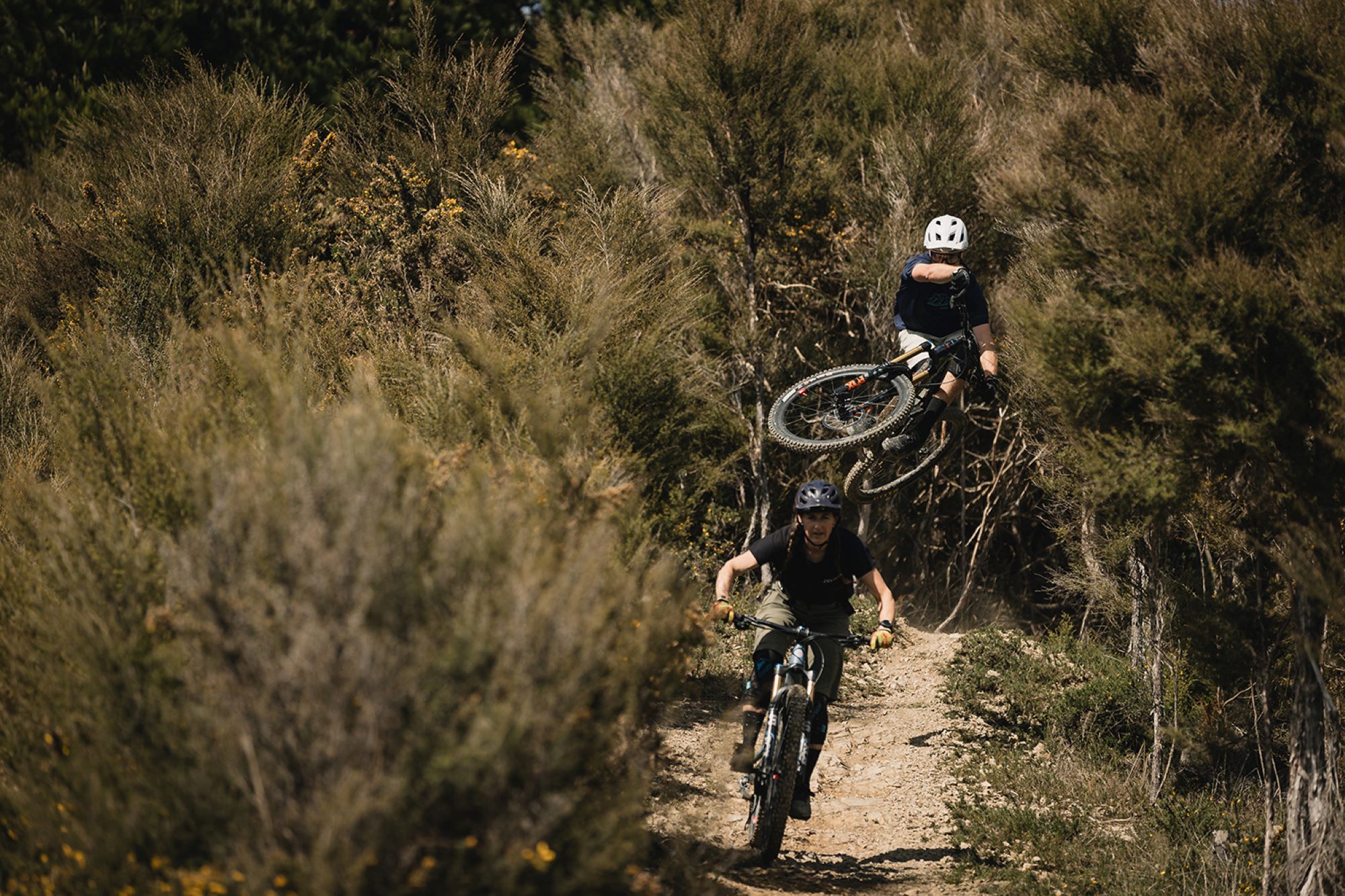
We caught up with some previous winners and riders to see what makes a successful day for them when racing the Mammoth:
Kieran Bennett
The Mammoth has always been a big, tough event so there are a couple of points for me to make it successful.-
Preparation: It seems like a no-brainer but I’m not just talking about training. Researching the course and stages; understanding what your nutrition and hydration needs will be; making sure your equipment is dialled; and having necessary spares with you – along with a whole host of other stuff. Fail to prepare, prepare to fail.
Consistency during the race stages: The Mammoth is almost like a marathon rather than a sprint, trying to find a second or two on a sketchy line isn’t worth it if you’re risking a potential crash that could lose you 10-20 seconds. When you have 30+ minutes of race stages, consistency is king.
Amanda Pearce
For me, the Mammoth Enduro is arriving at the race village early in the morning, with the dew still fresh on the ground, struggling to hold down my breakfast with nerves of excitement and fear of what lies ahead. Things get real once you strap on your race plate and get loaded up for the shuttle to the start of stage 1. After some pre-race chat, it’s time for the first run of the day. Dropping in, it doesn’t take long for the anxiety to dissipate and race mode takes over. The day is finished off with an ice-cold beer and yarns with mates about what was – and the one that got away.
A successful day for me is more about the social side than the race side of things, and if I’ve had a good, fun day out with my friends, the result will be what it is.
Louise Kelly
The Mammoth Enduro is probably my favourite race. I always look forward to it, I don’t know if it’s the aspect of racing at home or knowing that it’s going to be a big day out on some of the best trails in NZ, but it is always a good time.
Mammoth was my first proper race when I started enduro racing in 2018. I had no idea of what I was in for, but it sent me down the full enduro racing path. Having a Mammoth win to my name is a cool achievement for me, every time the race rolls around again, I stop and reflect on where I started and how far I have come.
To be successful at the Mammoth Enduro, both you and your bike need to make it through without any mechanicals or crashes, stay well-fed and hydrated and come prepared for the toughest race day ever!
Kurt Lancaster
The best thing you can probably do to prepare for Mammoth is move to Nelson and practice all the tracks! If you’re coming from the North Island, the biggest thing to work on is probably bike set-up. You want your bike set-up as comfortable as possible because you’ve got these long, rough, rooty, backcountry beech forest descents. They’re not all like that but, generally, there will be two or three long beech forest stages.
Consider slightly less tyre pressure than if you’re used to riding hard-pack stuff. You want as much grip as possible. Cushcore (or similar) is key. I don’t run a cushcore on the front tyre, but one in the rear. I used to run downhill tyres; I run double-down casings now, but nothing less than that. In the dry, it’s pretty grippy but, especially in the wet, you could probably drop a few psi in your tyre pressure and even soften up your suspension more. There aren’t any bike-park-style jumps or anything, so you don’t need a super stiff setup.
With only one day’s practice, there’s no way in hell you’re going to learn all the trails, so I wouldn’t get too hung up on trying to remember every root or corner. You’re probably better off learning to read the terrain and the trail speed; don’t worry about the small details, just ride your bike, there are too many tracks and the hills are too big, the stages are simply too long to learn everything.
Relax, don’t “try” and ride. It’s a big day. Relax and concentrate on riding smart. You don’t want to crash on the first stage and be riding the whole day nursing an injury. Just ease into it.
Figure out what gear you’re going to take on the day before you arrive in Nelson. If you don’t like riding with a CamelBak, what are you going to use to carry hydration or gear? As far as nutrition goes, you’re going to have to carry a bit of food. You want to keep the food intake up so consider how you’ll carry this too.
Arm and hand strength is key, especially if you’re from the North Island – you’ll be in for a shock. The descents are a lot longer down here so figure out a way to train your arms and get used to riding fatigued.
There we have it, some tips and suggestions from those in the know for how to maximise a big day at the Mammoth Enduro – or any big day in the mountains.
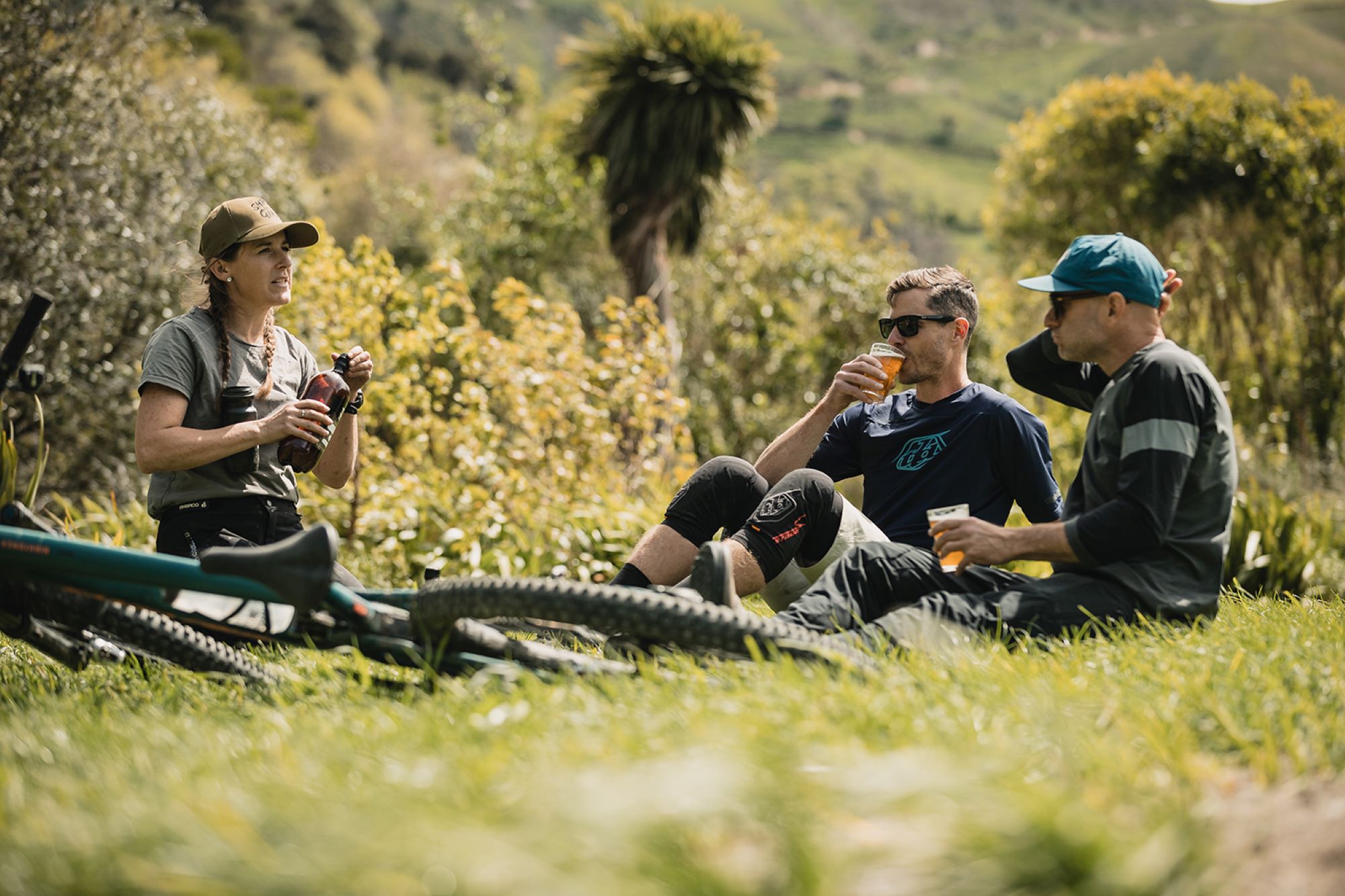
While the Mammoth has a reputation as one of the most demanding enduro races in the nation, with some preparation it’s more than achievable. The controlled environment of a structured race is a great way to test yourself, learn new things and push yourself out of your comfort zone in a relatively safe environment. Haven’t done a big enduro before? Just remember: you’re capable of more than you think. Give it a nudge!
Head to Mammoth Enduro for more info.
Tales from the Trails: Wyn’s Race Tales
Words: Wyn Masters
Photography: John Fernandes
“I checked flights and made the decision to head to Madeira for a week of racing...”
So my road to Madeira for the Trans Madeira race — a race that wasn’t even on my radar for 2022 — wasn’t such a clear one. I had managed to contract the dreaded Covid, and tested positive for the second time in 2022, at the final World Cup downhill of the year, in Val di Sol, Italy. This meant an extended stay in Italy to recover and then finally fly home. Not really the end to the ‘22 season I was after.
Then, the following week, back at my current home in the UK, I met up with Phil Atwill who was home for a bit to visit family as he now lives in Greece. He mentioned to me he was heading to Madeira on the following Monday for the Trans Madeira event. Not even knowing it was on, I quickly checked flights and made the decision that morning to head to Madeira for a week of racing, which would at least end my season on a better note. I was on an EasyJet flight the following Monday afternoon, direct to Madeira and arriving at 6PM.
Arriving in Madeira, I met Phil at the airport. He had taken a flight with a connection in Lisbon, and the airline had managed to lose his bike. Apparently, ‘22 was the year for losing luggage — I had it happen a few times myself. Luckily, with my direct flight, I had no such issue. We were picked up by a driver who took us to the base camp, which was set up on a beach, with 100 odd tents for all the riders and a big tent which served as the dining hall. We arrived as the sun was setting, so I got to work throwing my bike together and getting it ready as the race was set to start at 8 o’ clock the next morning.
To anyone planning on doing so, I would suggest not arriving the night before a race. Setting everything up — including the tent and so on — in the dark kinda sucks but, somehow, myself and Phil managed, and a local kid even agreed for Phil to use his 2016 Propain, as that’s the brand he rides for. All in all we managed pretty well considering.
The next morning, we were up early and in the shuttle on the windy long road to the top of the mountain for the 8am start. This became the daily routine for the next five days. Madeira’s mountains are in the centre of the island and stand up to around 1800m. This means that, often, the weather at the beach can be hot and sunny and, up the top, it can be a lot cooler and more damp. This really makes this event, as we cover a large amount of the trails on the island and get such a wide range of conditions and soil types.
Anyway, I kicked off Stage One for the week, following Phil on his borrowed/rental bike. Surprisingly, that didn’t last long, as 100 metres in he was on the side of the trail trying to pull the derailleur out of the wheel, not the best start to Stage One of a 30 stage (yes, 30 stage) blind Enduro race. For me, racing ‘blind’ — or without practice — is the truest form of Enduro racing, and probably the most fun too as you really have to be ready for anything and have a mental state of alertness. Pushing hard and going fast without knowing what’s coming up is quite a cool feeling.
The first stage went off without a hitch. It was quite physical and, as the day went on, it got better and better. Stage Two was quite wet and super techy with a lot of roots. I actually had one of my only crashes for the week at the bottom, when one of the photographers was cheering so I sent this blind jump and proceeded to miss the catch section after. Lesson learnt for the week: don’t let the “Kodak courage” take over. Keep it smooth! Stage Three was one of my favourites and also one we did in the EWS race back in 2018.

“The trail down was what the locals referred to as the ‘Madeiran Massage’, as it consisted of 10,000 stairs, and rattled whatever wasn’t already loose on the bike, loose!”
Dusty and flowing with heaps of drifty corners. We rolled back down to sea level before beginning the climb to Stage 4. It was super hot, maybe 35 odd degrees, and there was nowhere to hide from the sun. Still, we made it up to Stage Four which was super rocky — I nearly killed a family of three goats that were walking on the trail as I came around a corner. Definitely made for a bit of excitement!
From there, it was a shuttle followed by long pedal along the Levadas — the ancient waterways that make up the island’s irrigation system. They channel all over the island and are pretty impressive to see. By the end of the week you truly realise how many of them there are — we spent a lot of time riding along them that week, that’s for sure. I think there is over 1000km of them on the island, with 40km of tunnels too. Anyway, day one turned out to be pretty big with 65km on the bike and quite a bit of climbing too, even with all the shuttles. There were plenty of tired and hungry riders arriving back at the camp area afterwards — luckily, the food the event puts on every day is pretty good. You also get a beer each day on arrival, which is nice. This was where I was surprised, as this event isn’t so much aimed at the pro riders but more the full range of riders, offering them a chance to see the majority of the riding in Madeira in a week. Physically, it wasn’t much less than an EWS day and we still had four more days of it to go. At the same time, I was stoked too, as more racing and bigger days is something I enjoy and something I think the EWS has lost a bit in past years.
Since I don’t quite have time to outline every single day of the week, I will run over my highlights. Day two was another big one, with such a range of different trails and conditions.
We finished off with 50 odd switchback berms which made for an epic way to end the day — especially with Phil chasing me down, still on the rental bike as his never arrived! Then, day three was the one the event staff had been telling us about all week: the big hike-a-bike day. Due to the longer day, we had to be up for breakfast at 5.30am. At this point, we were definitely starting to feel the previous couple of days and, after a one hour bus ride to the top of the mountain, we were greeted with thick clouds and rain. I can say for sure no one was super keen to get out of the bus in a hurry but, luckily, after about 25 minutes of pedalling and pushing we arrived to see the clouds burning off to some of the most epic views all week at the start of the stage. It was definitely bucket list stuff. We then had two open and fast stages through some rocky and loamy stuff followed by a 40 minute climb on a road to reach a trail taking us to the first feed zone of the day. The trail down was what the locals referred to as the ‘Madeiran Massage’, as it consisted of probably 10,000 stairs, and rattled whatever wasn’t already loose on the bike, loose!
Then came the long hike. Phil and I had been pushing our bikes for about 40 minutes when we got to a sign telling us we had 11km to go to the next feed zone. It definitely didn’t excite us but, once up on the ridge, it was much better going with some amazing views of the valley around. It was also a relief to finally arrive at the feed zone and have some food — that was probably the hungriest I’d been all week. From there, we rode and pushed along a Levada and through some long, dark tunnels for a while. We were told, on the event information sheet, to bring a head torch — and now we knew why. After the two long and narrow tunnels, we arrived to a trail that two local kids at the start had told us is the best on the island. I can say they definitely weren’t wrong — it looked slippery to begin with, that kind of wet, volcanic dirt, but after two corners I realised how much grip there was and got into it. It was probably the most flowy trail all week, with all the corners banked in. It had so much grip. After that, we’d definitely forgotten the big hike to get there and I don’t think I saw anyone not smiling after that! We headed to a cool campsite below a big rock face on the coast for some much needed dinner.
The final two days kind of flew by as, after four days, the routine starts to set in, and you get used to the early starts. The nights in the tent also get easier. On day four we had a sweet campsite on a small beach; and by day five, the final day, everyone was pretty smoked. We were also stoked to make it to the end of the race and, after another solid day’s racing, we got to ditch the tents for the night and were put up in a five star hotel with a big buffet dinner and prizegiving for all the riders, which was a bloody good time. I managed to take the win over ex WC DH rider, Marcelo Gutierrez, from Colombia — not that it really mattered, it was more about the experiences we’d had along the way.
This is an event that I wouldn’t even so much label as a race, but more as an experience. I would definitely recommend it to anyone who has yet to go to Madeira, as it will show you more than you ever could see on the island without a guide, plus you get to ride/race with 100 other people all having a great time too. For me, it definitely was the best event I did in 2022 and my favourite week of riding too. It was the end to the season that I didn’t know I was looking for, but one of the best ways to finish off the year. So yeah, if you haven’t already, I would recommend adding it to the bucket list! One of the best parts is that a lot of the profits from the event are reinvested back into funding more trail building and maintenance on the island, too.
Cheers to the whole crew at Trans Madeira for an epic week!
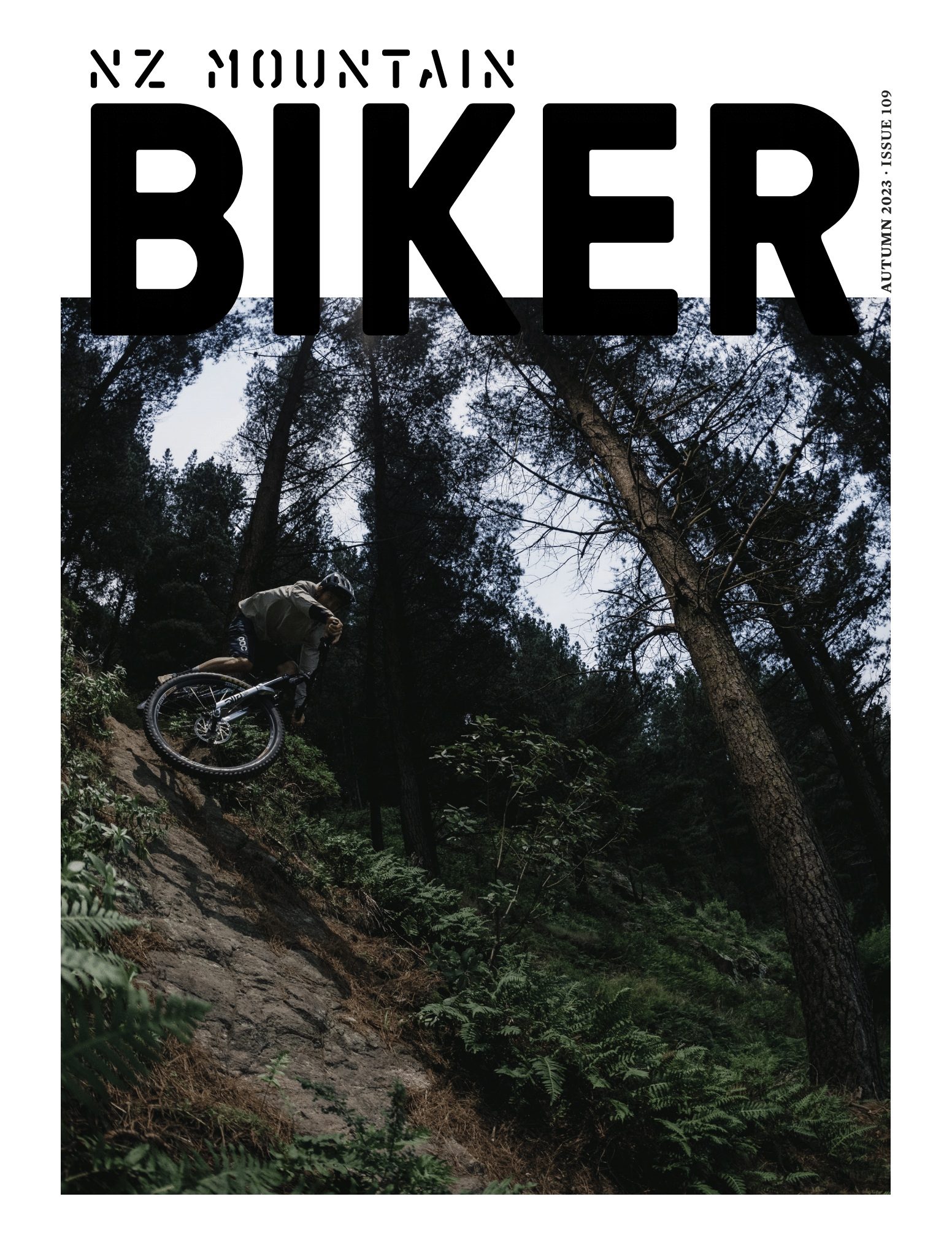
Trail Builder: Support Stretches North to South
Words: Meagan Robertson.
Photographs: Peter Stoneham and Andy MacDonald.
The latest round of Trail Fund grants – supported by generous donations from Specialized – helps build new trail networks from Northland to Southland. Thanks to an incredible $17,850 donation from Specialized New Zealand, Trail Fund’s spring funding round was bigger than ever this time around, with four grants of $4,000 up for grabs! The increased number of grants on offer saw the biggest number of applicants in years, with 26 trail building groups vying for the funding.
“This was a really tough round for funding decisions as there were so many quality applicants,” said Advisory Board member, Peter Mora. “After much consideration, we chose our top four, but we want to acknowledge the incredible amount of good work being put in by volunteers up and down the country, and the quality of the applications we received.”
The funding is already being put to work by four deserving trail building groups around the country: Ruapehu MTB Club; Waikaia Trails Trust; Cromwell MTB Club; and Kerikeri MTB Club.
Riding in Ruapehu – Ruapehu MTB Club
For those who have spent non-ski days riding everything they thought the Ruapehu region had to offer – Old Coach Road, 42nd Traverse, Fisher’s Track, Tree Trunk Gorge – it turns out there’s more!
Opened late in 2018, Uenuku Pines was the first mountain biking park in the Ruapehu region, set in Waikune Forest, on the edge of National Park Village.
The opening of the park saw a series of ‘unofficial’ trails – built and maintained by local volunteers –finally made ‘official’, thanks to the co-operation of forestry managers. With 15km of trails, ranging from Grades 2 to 5, the park grew quickly in popularity – as did Ruapehu MTB Club membership.
In 2021, a large section of the park needed to be felled, which stemmed the growth the club had worked hard for. However, the numbers have started to increase again with the redevelopment of the trail network – this time, working in tandem with the forestry company and Crown to avoid future felling impacting the trails.
Building momentum should speed up this summer, thanks to Trail Fund’s $4,000 donation to the purely volunteer-run club. “We’re really excited about the rebuild and reigniting the passion that was building in the area with working bees, weekly social rides, kid’s programs and a women’s riding group,” said club president, Greg Prouse. “The funding help will expedite the construction of new tracks and usage in some difficult terrain, bringing us closer to our goal of once again providing a regional riding facility for riders and their families.”
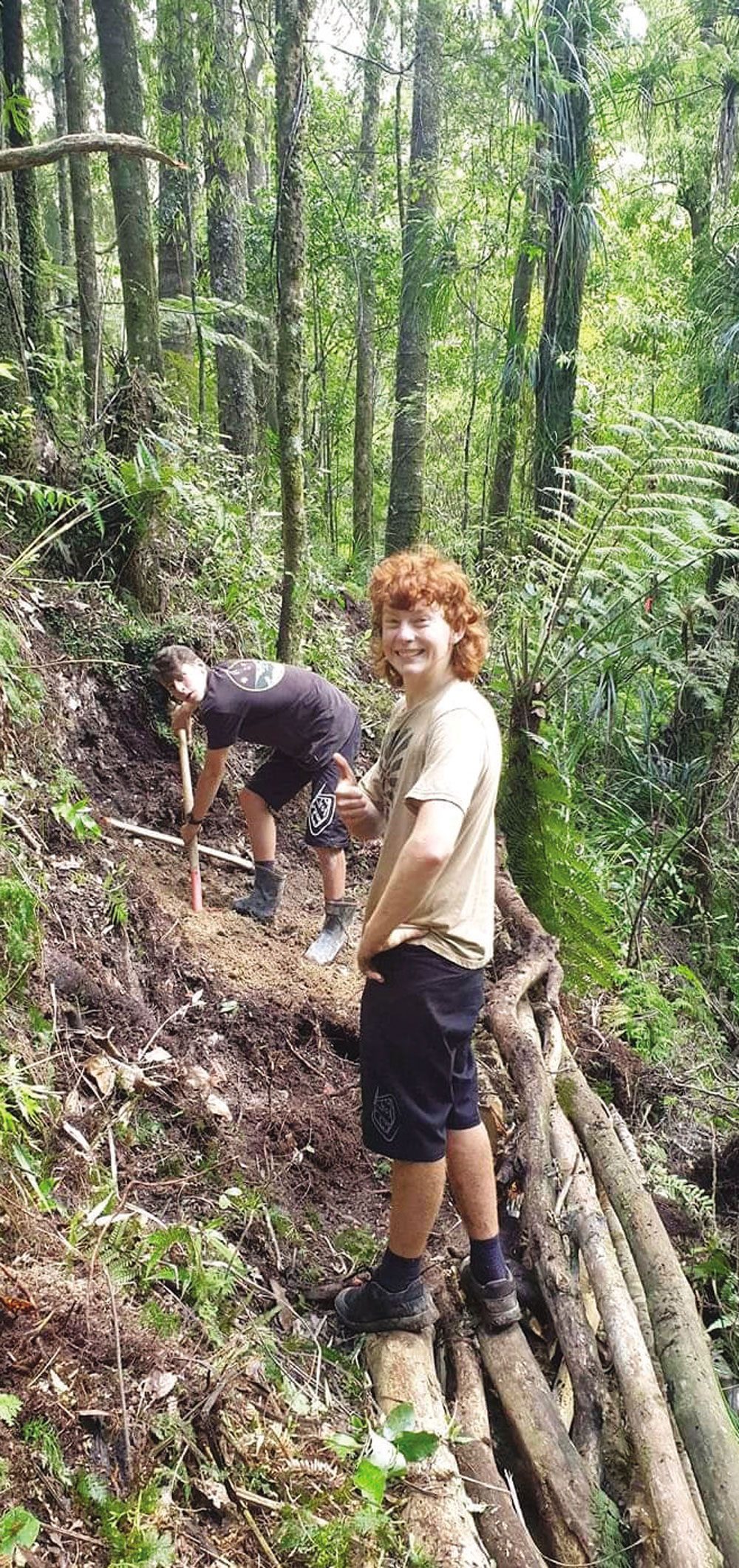
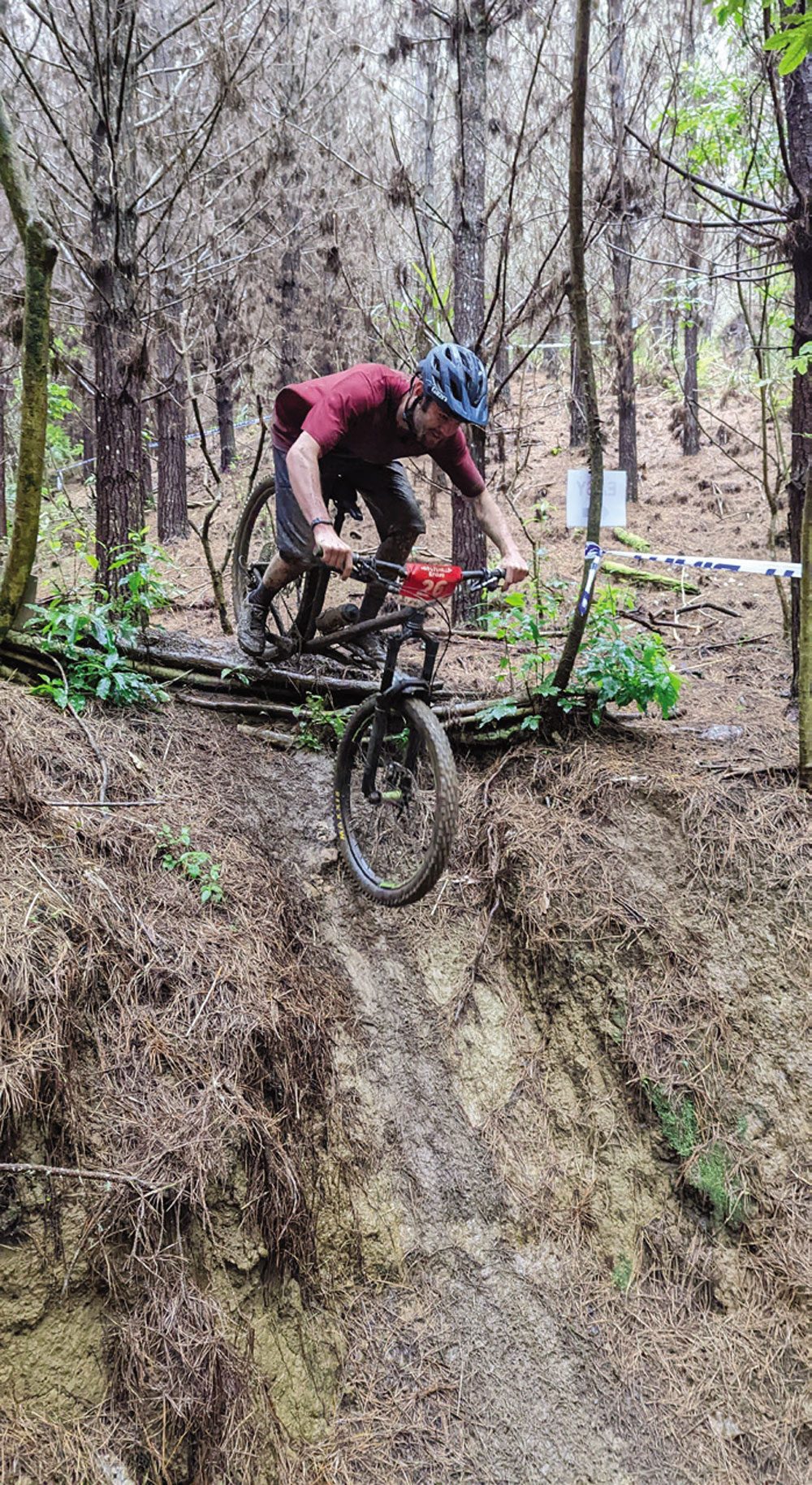
Why Waikaia? Pure passion – Waikaia Trails Trust
As Margaret Mead so aptly put it: “Never doubt that a small group of thoughtful, committed citizens can change the world; indeed, it’s the only thing that ever has.”
And while the Waikaia Trails Trust might not be looking to change the world, this small town of 150 people is looking to add another string – and a good one – to Southland’s growing mountain biking scene.
As with most good changes, it didn’t happen quickly. An opportunity to develop mountain bike trails in Waikaia Forest, located immediately to the west of Waikaia in the north of Southland, was identified by the mountain bike community, in 2020. The site, which is a 700-hectare forest with approximately 110m of elevation, is owned by Southland District Council (SDC) and there was no public access at this time.
Not to be dissuaded, the instigators had the Ardlussa Community Board (ACB) lead the first stage of investigation, starting with receiving 100% support and permission from the Council to use the forestry block for this project.
“Once permission was granted to investigate, we commissioned a concept plan, including a feasibility study, then a master plan, then set up the Waikaia Trails Trust to lead the project in collaboration with SDC, Ardlussa Community Board and Southland Mountain Bike Club,” explains trust chairperson, Hilary Kelso.
From there, the Trust worked to finalise a Memorandum of Understanding, Access Agreement and License to Occupy with the Southland District Council. This included securing insurance, including $20m liability, and completing a Health and Safety Plan and Overlapping Duties document between the Trust, SDC and IFS (Invercargill Forestry Services). All parties involved have the up-to-date harvesting plan to ensure best use of the area for trail sustainability.
“It’s taken significant effort to get to this point, but we are thrilled to be ready to begin,” says Kelso.
“Our aim is to create an excellent trail experience based on quality, which complements and enhances mountain biking in Southland and caters for all riders, with an emphasis on introduction to, and progression within, the sport.”
Development of the proposed 25km network is divided into stages, and the Trail Fund grant will go towards the development of the park entrance and two initial trails – one beginner and one intermediate. While the Trust is focused on catering to its own residents and neighbours, it also sees the park as an opportunity to add recreational tourism to a town known largely for its railway and mining history.
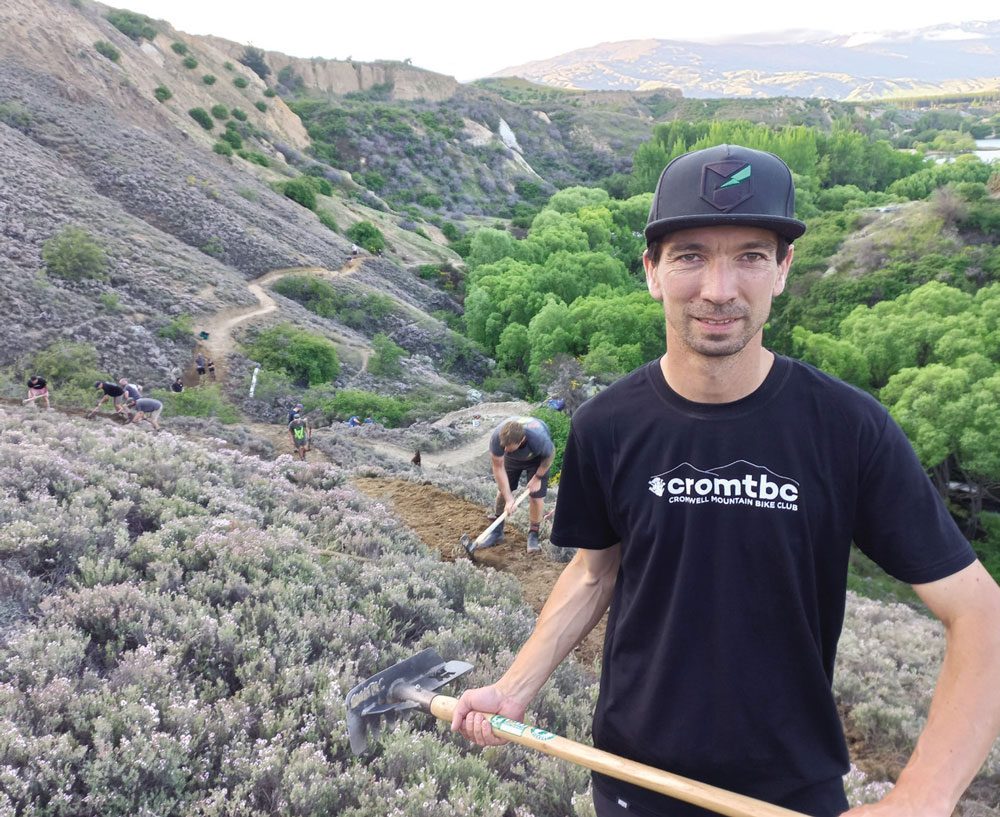
Cromwell MTB Club working on a new trail in Bannockburn.
Caught in the middle – Cromwell MTB Club
Nestled between a trio of top mountain bike destinations, one might think Cromwell mountain bikers were spoilt for choice. However, as epic as their neighbouring destinations may be, until recently they had no local mountain bike specific trails, and no suitable land to build them on.
That all changed early in 2022, when the Cromwell MTB Club – a newly formed club committed to building free, permanent trails around Cromwell – were granted access to suitable land in Bannockburn, where work on their first trail started soon after.
“We’ve actually been a committee for just more than four years but, until now, the club had been a ‘committee only’ entity because we didn’t want to seek paying members until there was a solid project to be involved in.
Now we have that, and trail work well underway in Bannockburn, where trails will be built purely by club members and other volunteers,” says Cromwell Mountain Bike Club president, Alex Bartrum.
He was thrilled to receive the funding for tool sand irrigation pipes from Trail Fund, and is confident Cromwell residents and visitors will reap the benefits.
“The funding will go a long way to help a fledgling club turn an area that currently has no trails, into a biking hotspot,” Bartrum says. “We are very much an inclusive, community focused club. Our first trails will be accessible to riders of all levels and, once those are built, we will look to build more technical and difficult trails.”
The club is also very close to building more trails at a second location, Shannon Farm, which would pave the way for world class, mountain bike-specific trails within riding distance of Cromwell town, according to Bartrum.
“We are just waiting for final approval from the council and are currently in the process of seeking funding as the first trail here will be professionally built. We are so thrilled to finally be able to put our shovels in the dirt!”
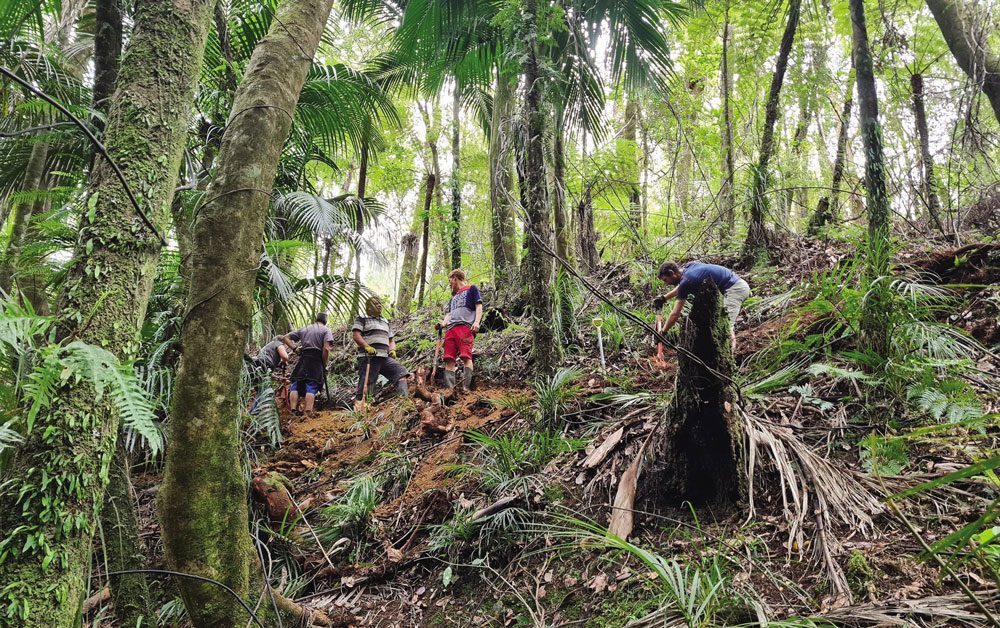
Whitehills Forest, located 8km north of Waipapa, offers a diverse range of terrain.
More than pedal power needed – Kerikeri MTB Club
A long-established Bay of Islands based club, the Kerikeri MTB Club has taken on many projects over the years and has a keen following in the area.
“We have excellent knowledge of local mountain biking opportunities, and our members help to build a vibrant MTB community in the Bay of Islands,” says club president, Richard Pilling. “We foster skills development, with encouragement and challenge in a social environment.
We build and maintain a network of hand-crafted tracks in local forests, and host weekly group rides, events and activities.”
The current focus for the club is Whitehills Forest, located 8km north of Waipapa, which offers a diverse range of terrain, including plantation forest, native bush, gentle rolling areas and steep gullies – with more than 200m of descent to play with.
“Thanks to outstanding support from Summit Forests, the club has been developing the riding area for the past two years,” says club secretary, Odette Yates.
“Volunteer effort and local sponsorship has enabled us to build more than 16 interconnecting tracks covering a range of terrain, which have been embraced enthusiastically by local mountain bike riders.”
With a combination of hand-crafted and machine-built tracks suited for intermediate to expert riders, Kerikeri MTB Club says its goal is to offer the best riding experience north of Rotorua
According to Odette, this is now the only mountain bike area of its kind in Northland, as the existing club tracks in the Waitangi Forest – which had been built over the past 10 years – have largely been destroyed by ongoing forest harvest.
With the project well underway, Kerikeri MTB Club knew what it wanted from its Trail Fund application – a power barrow of its own!
“We have found moving materials, dirt, gravel and timber around on the steep terrain so challenging that we’ve hired and borrowed power barrows on several occasions, and we recently gained permission to extend into another area of the forest, which is further from the main road,” explained Odette in the club application.
“Borrowing and hiring power barrows has made us aware of how much more efficiently we could work if we had access to this kind of machinery on a permanent basis.”
With a power barrow now on hand, Trail Fund looks forward to seeing what will be accomplished by the committed club members for years to come!

New video guide Sheds light on the iconic Old Ghost Road
Words: NZ Safety Council
Photography: Quite Nice Films & Cameron Mackenzie
Its vision of ‘safer places, safer activities, safer people’ is supported by years of in-depth insights. This means NZ Mountain Safety Council (MSC) knows where, how and why people get into trouble, and how to prevent these incidents.
The organisation has been encouraging safe participation in all land-based outdoor recreation for almost 60 years. That’s anything from hiking to backcountry skiing and climbing, to mountain biking and trail running. These insights clearly show that preventable incidents are occurring across Aotearoa.
By analysing these insights, MSC realised that the best way to encourage outdoor enthusiasts to change their behaviour was to make planning and preparation as easy and robust as possible. This preparation is a vital part of a fun and safe adventure, whether it’s a short walk in a regional park, a multi-day tramp in the Southern Alps, or a backcountry mountain bike ride. This saw the shift in messaging tactics from highlighting what not to do before an excursion, to positive messaging on how to plan correctly.
Over recent years, MSC has created a suite of videos covering safety tips and how-to style content. Its latest, and first mountain biking video, is a new ride-through safety guide on the Old Ghost Road trail, and has been added to the suite of Tramping Safety video series. From the Milford Track to Canterbury’s Mt Somers Track, up to the Coromandel’s Kauaeranga Kauri Trail Pinnacles Walk, the series covers the country’s most popular tracks, where data revealed preventable safety incidents which could be reduced by a target video.
These videos highlight each track’s common risks and hazards, outlines key decision-making points, and offers guidance on walking times, essential clothing and gear items, important weather factors and other track-specific advice.
In 2021, the research behind this ongoing series won the ‘Insights Communication’ award at the 2021 Research Associations Effectiveness Awards. According to the research findings, 76% of people who watched the video said they would make changes to their plans because of it, and 90% of those people did. Furthermore, 95% said they learned something new, with 82% saying their knowledge of hazards along the track had improved; 85% said their overall understanding of the track had increased.
The Old Ghost Road video aims to help mountain bikers prepare for the epic West Coast backcountry trail. One of the esteemed Great Rides of New Zealand, the 85km-long Old Ghost Road is Aotearoa’s longest single-track backcountry trail, and one of the most incredible multi-day backcountry experiences in the country. The adventure takes riders and trampers back in time along a shared-use and long-forgotten goldminer’s road.
This impressive trail weaves through ancient forests and diverse, rugged alpine environments. The infamous West Coast weather – frequent heavy rain, strong winds, snow, and freezing temperatures, even in the height of summer – means the Old Ghost Road is a true adventure.
The video highlights the varied conditions mountain bikers can expect, covering important tips including how to pack a balanced bike, a suggested packing list, the common risks and hazards, and key decision-making points and pit stops.
MSC Chief Executive, Mike Daisley, said the new mountain biking video was the first of what MSC planned to deliver as part of a growing library of backcountry mountain biking video resources. To deliver the stunning cinematography and capture the essence of the trail required a new filming approach and very careful planning and preparation, he said.
“We’re incredibly excited to launch this video and support riders as they tackle what is a truly spectacular, but hazardous, backcountry adventure.” Mokihinui-Lyell Backcountry Trust chair, Phil Rossiter, said the new video significantly extends the tools and resources available to help users plan for their trip. The Trust was set up in 2008 by volunteers who wanted to bring the Old Ghost Road to life and now, having done just that, it acts as the entity that operates and maintains the trail. The Old Ghost Road, a Ngā Haerenga NZ Cycle Trail Great Ride, is a destination trail with many unique elements that draw in an average of more than 6500 riders and 5000 trampers each year. There is one key underlying theme that draws mountain bikers and trampers to the trail, Rossiter said. “It’s the rejuvenation of the soul and mind that comes with time immersed in nature and stunning landscapes, away from distractions and the noise of everyday life, and made all the better by the physical exertion required and the company the experience is shared with.”
“Video is a more powerful way of communicating information than just written text. The ability to combine important safety and preparation details with actual imagery from on the trail is a very helpful step forward. Combined with the professionalism and quality of the safety videos that the MSC produces, it wasn’t a difficult decision to get on board,” he said. Plan My Walk by MSC can help those planning to tackle the Old Ghost Road by providing weather forecasts, alerts, a gear list and then create a trip plan to share with a trusted contact. •
• The video can be found on NZ Mountain Safety Council YouTube and Plan My Walk. The video, other useful resources and hut booking info can be found at oldghostroad.org.nz

The new fast: eMTB racing is powering up
Words: Alex Stevens
Photography: Seb Schiek
The latest breakthrough is once again led by Bosch, who unleashed their new drive unit for the last race of the Enduro World Series (EWS-E) in Finale Ligure, Italy, in September. The results speak for themselves. The entire women’s podium of Florencia Espineira (Orbea Fox Enduro Team), Harriet Harnden (Trek Factory Racing), and Tracy Moseley (Trek), along with the winner of the men’s category, Adrien Dailly (Lapierre Zipp Collective), and half of the men’s top 10, were powered by the Bosch Performance Line CX Race Limited Edition.
Fair to say, Bosch are experienced players in the sport of eMTB racing. Bosch-powered bikes claimed more than 60 podium finishes in eMTB races around the world this season alone. In the EWS-E overall team competition, Orbea Fox Enduro Team took the win, with Miranda Factory Team in second and Pole Enduro Race Team in third, all running Bosch systems.
The future of eMTB racing is looking fast. Not only is the sport experiencing a rapid uptake, but the technology behind it is also finding more speed, giving professional riders the competitive edge they need when podium spots are decided by fractions of a second.
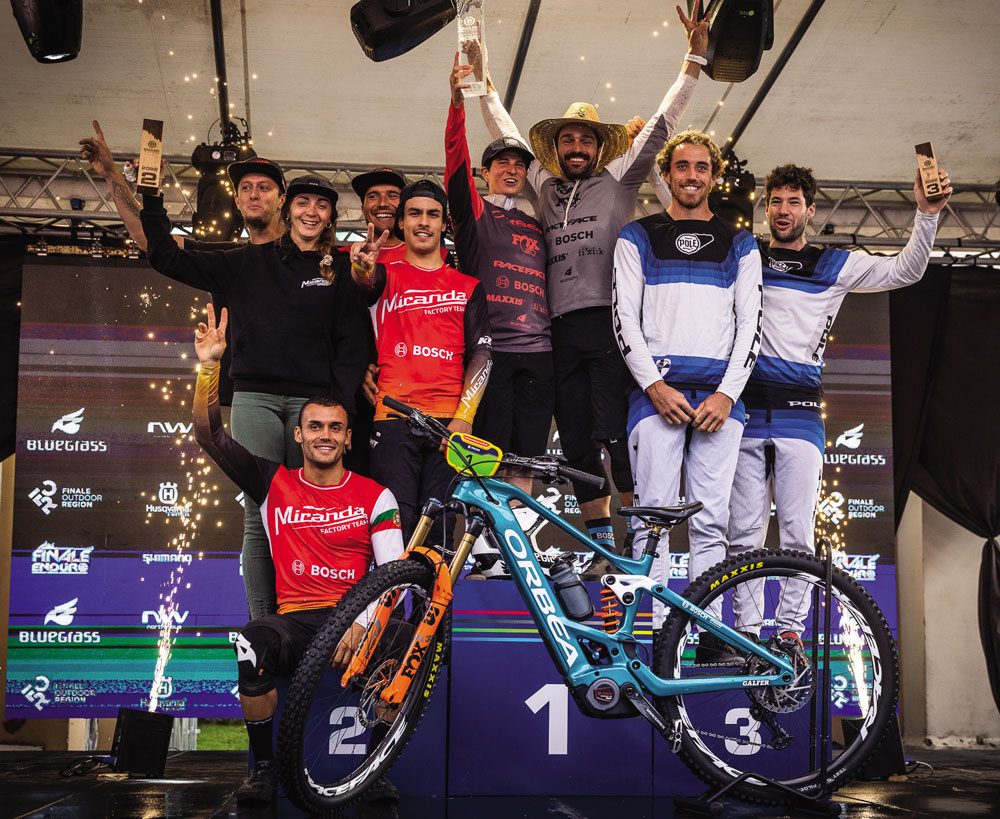
Bosch have been leading the field for over a decade, ever since one of the first eMTBs was equipped with their drive system, back in 2010. Since then, the company has consistently developed more products for eMTB riders. The Performance Line, CX, was the first eBike drive specifically designed for eMTB in 2014, and the 2018 eMTB mode continues to set the standard today.
So, what does the new CX Race Limited Edition bring to the table? The specially developed Race mode, uncompromised support and low weight are the key ingredients when it comes to setting new record times.
The Performance Line CX Race Limited Edition is an exclusive evolution of the Performance Line CX. The new Race mode offers direct support, with up to 400% of the rider’s own pedal power, compared to 340% in Turbo mode with the Performance Line CX motor. This means riders reach top speed faster, and can stay there for longer.
The Extended Boost of the eMTB mode has also had an upgrade, giving it even more grunt in Race mode and making it easier to tackle large boulders, roots or steps. Race mode can be adjusted in the eBike Flow app, where you can tweak the strength of support, dynamics, maximum speed and maximum torque.

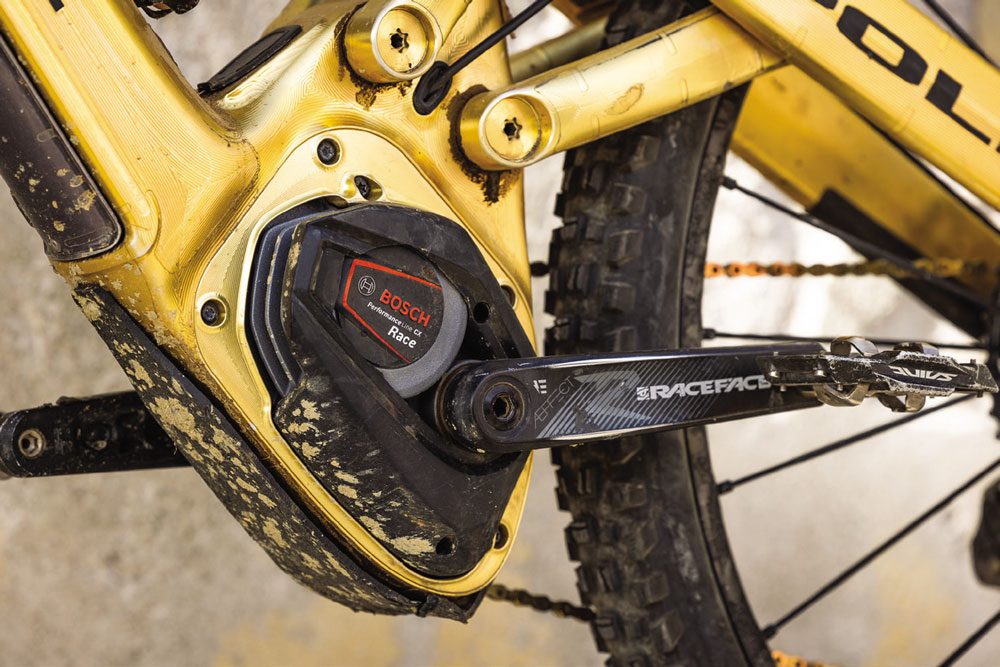
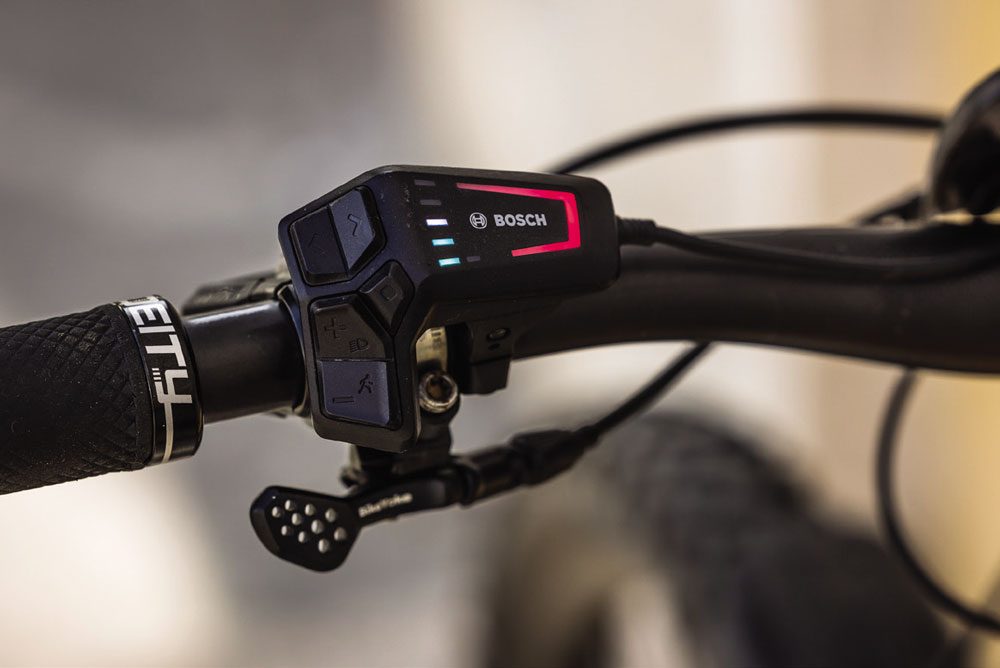
At 2.75 kg, the new drive unit is the lightest drive in the entire Bosch portfolio. This reduces the weight of the bikes equipped with it and optimises the handling on demanding trails. But, with 85 Newton meters of torque, it still offers maximum power for acceleration out of tight corners, which can be a decisive competitive advantage. Even at cadences over 120 rpm, the powerful motor provides explosive support so aggressive that riding over long stages and fast sprints are possible.
The CX-R is designed for tough, technical routes, steep uphills and gnarly descents, which is exactly what the course looked like at the EWS-E in Finale Ligure. NZ’s Joe Nation, riding for Pole, got to experience it first-hand.
“It was great to be on the CX-R in Finale,” says Joe. “The first power stage was a steep uphill with some monster boulders which the extended power boost made light work of. As weight is a pretty big deal – in both bike and body – for eBike racing, saving over 100 grams is a big gain too.”
Joe, who made the switch to EWS-E just this season, finished 22nd in Finale and 12th in the overall season standings. Not a bad result considering he only got hold of his eBike three weeks out from the first race of the season and had a massive learning curve mastering the nuances of racing eBikes. He’s back in New Zealand for the summer and plans on returning to Europe next season, fitter and more competitive than ever. It’ll be exciting to see what he can do after a full off-season spent training with the CX-R.
The new Race mode offers direct support, with up to 400% of the rider’s own pedal power, compared to 340% in Turbo mode with the Performance Line CX motor. This means riders reach top speed faster, and can stay there for longer.
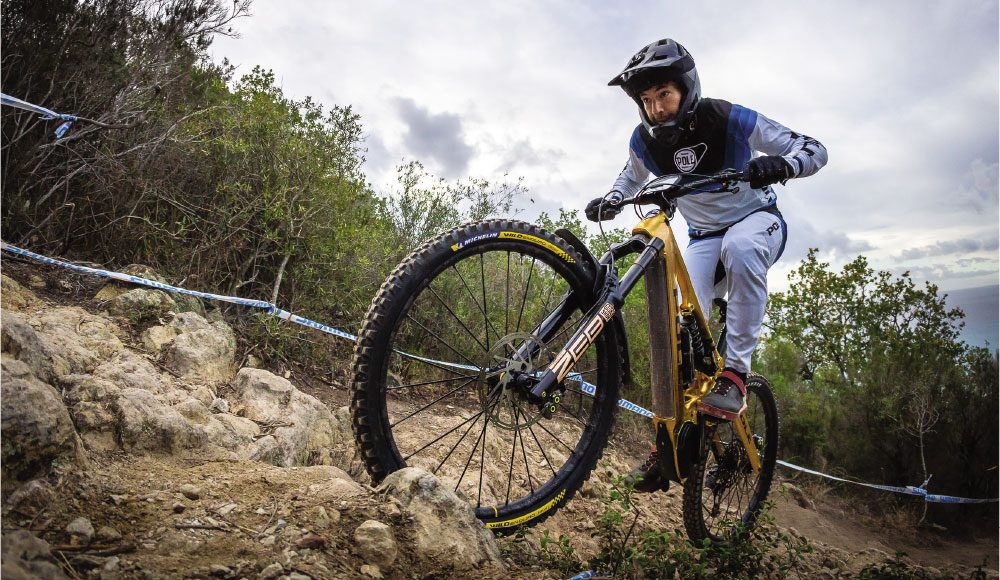
“A lot of the competitors who weren’t using a Bosch motor were definitely curious about the update, especially as the current CX motor is already top of the line,” he says. The new drive unit requires some pretty precise skills to control the direct response and power of the Race mode. In Tracy Moseley’s words; “It is like taming a bit of a wild horse at times, but it’s just learning its characteristics, learning how to ride it, pre-empting some of it, making sure you’re in a good body position, making sure you’re riding aggressively, and then it’s awesome. If you’re a bit, sort of, resting on your laurels, out for a cruise, it can definitely take you for a ride.”
The Bosch Performance Line CX Race is currently only available to professional riders on Bosch powered brands, and as a limited edition on some eMTB models. Some CXR equipped bikes may well make it to our shores for a lucky few. So, while most of us won’t get to experience this game changing tech for ourselves (for a while) it’s going to be fascinating to see what it brings to the race scene and how riders like Tracy Moseley and Joe Nation use it to its potential in the future. This could change the nature of eMTB racing, from the trails ridden to the approach taken by riders.
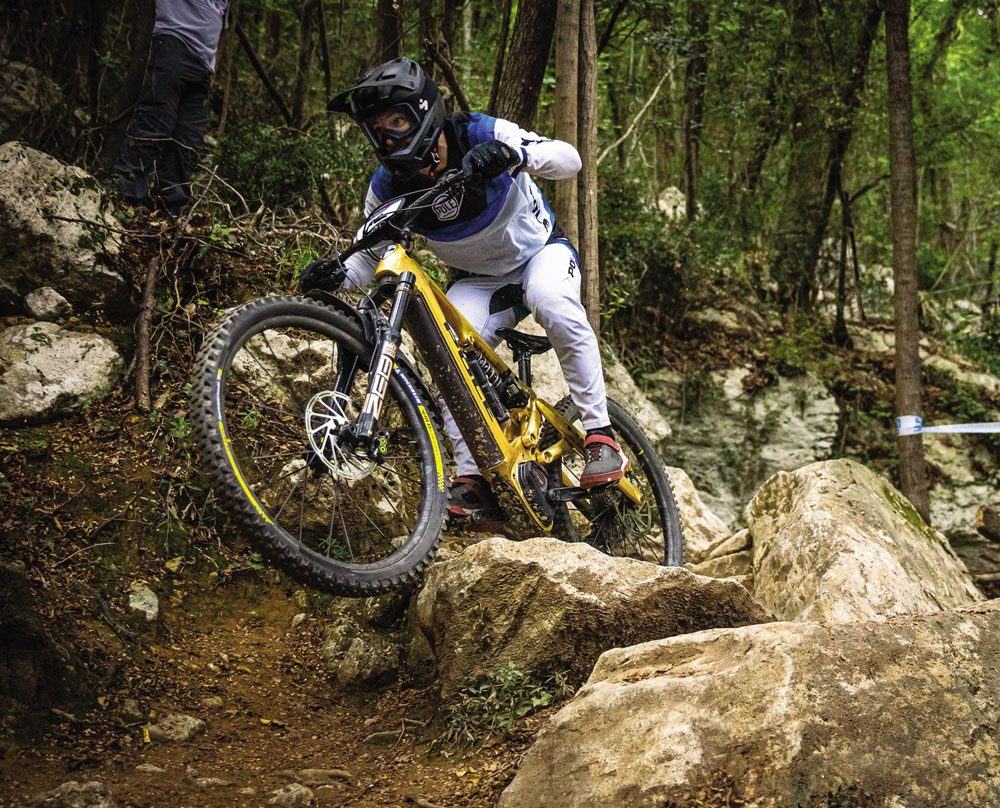

Las Cholitas
Words: Jess Dickinson
Photography: Keenan DesPlanques
We picked a line and dodged our way down to our day one camp and a hot meal from Rocky, our gold-toothed cook. An altitude-induced throbbing head and uneasy stomach had come with me to camp, so I took myself away to sleep off the little voice inside that said I shouldn’t be up there.
The Little Idea
It ended with four women, one baby, a dog and a dead alpaca. Not exactly what we’d pictured as Claire and I piled ourselves, nervously laughing, onto a plane in New Zealand. Our plan was pretty simple: ride the best singletracks in South America; make friends; drink beer. A good plan. What we found was an ever-strong group of women, three days of backcountry free riding under the shadow of Mount Ausangate, in the Peruvian Andes, and a wee reminder that from little ideas, big things can grow. Mt Ausangate lured us in from day one. Wherever we went, there she was, our backdrop to Cusco, beguiling us into looking beyond our simple plan of just riding some trails. Whispers of the amazing scree fields, wild views and wonderfully lonely ridges were described. We had been messaging Nicole and her buddy Emily. Nicole runs Haku Expeditions, a bike tour company out of Cusco, specialising in taking people down fatigue-inducing, arm pumping singletracks for a living. Cusco singletracks are distinguished by their twenty- five kilometre stretches of uninterrupted downhill, occasionally broken by ancient Inca staircases or a few alpacas to dodge. This is where Nicole guides every day. The Ausangate fire was lit. Like a weird biking version of Tinder, we made plans to meet up for a ‘test ride’ to see if we all got along. In Peru, women who are of the mountains are called la cholitas. It was evident after our first ride together that our little idea had grown into us venturing up there and following the local cholitas who had walked before us. Nicole described our trip as a hike-a-bike without air. At a maximum of 4800m, pedalling in any direction was going to be hard. And this trip would have a lot of climbing. We had Emily, America’s collegial cross country, ST and omnium champion, to rally at the front; Claire, the ever- enthusiastic Scotswoman, to keep us in high spirits; and Nicole’s baby, Joachim, with his own nanny Iris who, as a local to the area was a mountain woman in her own right. We were also bringing Simon, a trail dog and, as we later discovered, an overly enthusiastic alpaca herder. Add a few pack horses and our mish mash of a team was formed.
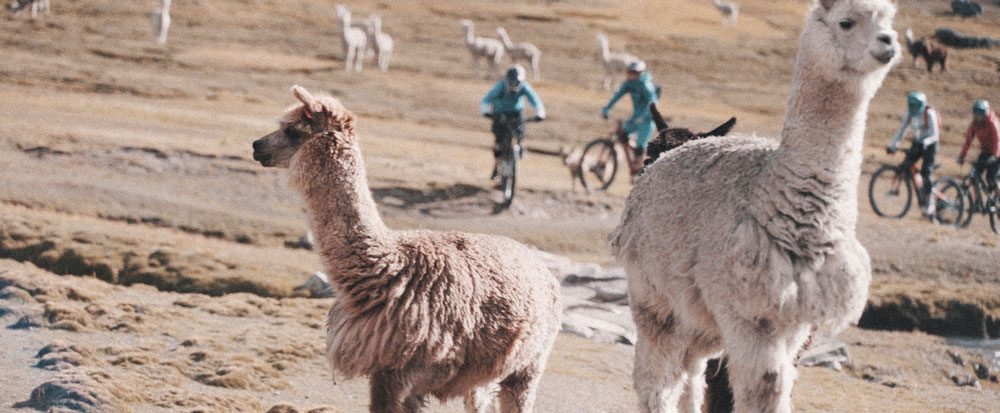
AFTER PHOTOS WERE TAKEN, HUGS WERE GIVEN AND MOMENTS OF AWE WERE EXPERIENCED, WE FOCUSED ON RIDING THE RIDGELINE. RIDING THE RIDGE WAS A GREAT IDEA. BUT THE MOUNTAIN HAD PILED ITSELF WITH BOULDERS.
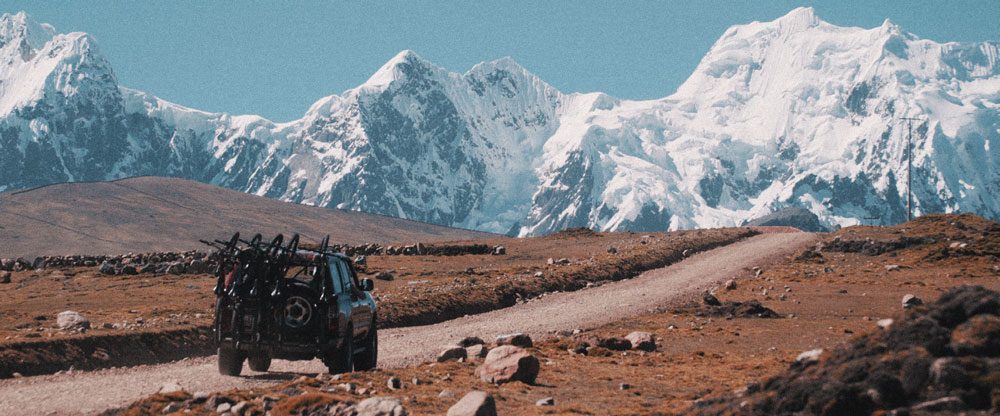
The Big Traverse.
It was a 3am start from Cusco to our starting point, where we’d rendezvous with the horsemen and helpers we’d hired to help lug bikes. Late morning saw us starting along a rocky walking path, bouncing around rocks and alongside creeks, before the only path we would see for two days ended and the inevitable uphill loomed. Soon the rocks were too thick to ride through. We were already at 4200m when we started the climb. Our helpers, long-time friends of the mountain, grabbed our bikes and took off ahead. We took turns pushing Emily’s bike up, taking five minute turns. But, as we went up in altitude, it turned into counting out ten steps before the next person took over. Soon I was having trouble catching my breath and was reassigned the responsibility of carrying the camp soccer ball. Altitude requires patience. Patience to go slow and patience to breathe. Each pedal up tested that. Pulling up on the ridgeline on day one to see the valley unfold below us will be one of those completely happy moments I will cherish forever, mixed with undertones of queasy high-altitude breathlessness. We were so pleased to be living in that moment in time, despite the spattering of sleet. Our trail off the ridge was absent. It was straight down, pick-a-line freeriding through a boulder park. It plunged us into high alpine scree fields, needle sharp grass, steep descents and icy blue creeks, dotted with the occasional farmer’s hut. Day two began easily enough, riding a meandering alpaca path through a valley. Our route was set to a fairly easy pass up ahead. This was until Claire hatched the great idea that the ridge framing us to the left would make for great riding. So we climbed, first to the false horizon, and be one of those completely happy moments I will cherish forever, mixed with undertones of queasy high-altitude breathlessness. We were so pleased to be living in that moment in time, despite the spattering of sleet. Our trail off the ridge was absent. It was straight down, pick-a-line freeriding through a boulder park. It plunged us into high alpine scree fields, needle sharp grass, steep descents and icy blue creeks, dotted with the occasional farmer’s hut. Day two began easily enough, riding a meandering alpaca path through a valley. Our route was set to a fairly easy pass up ahead. This was until Claire hatched the great idea that the ridge framing us to the left would make for great riding. So we climbed, first to the false horizon, and finally reaching the highest point of 4800m. Claire was in her element. Emily bounced around taking product shots for various sponsors. I, however, lay behind a boulder trying to find my breath. From behind my boulder I remembered this had all evolved from a little idea about riding some bikes, yet here I was standing (or, at that point, lying) higher than I’d ever been, on an unbelievable mountain mission, with an amazing bunch of women. After photos were taken, hugs were given and moments of awe were experienced, we focused on riding the ridgeline. Riding the ridge was a great idea. But the mountain had piled itself with boulders. So, instead, we carried bikes along the ridge towards the pass. It was hard riding for the next few hours. With no trail to follow and boulders thick on the ground, a lapse in concentration ended in pedals colliding with rocks or a dead stop. Hours of rock hopping lead us down to the lip of a giant bowl, with rough tracks peeling off left and right to the lake and camp below. It was steep, technical, off camber and exposed. I was mildly terrified as I dropped over the lip. At the bottom of each steep section was a ridiculous switchback framed with cactus on one side and a cliff on the other. Ill-timed braking sent my back tyre sliding towards a drop off and I tensed knowing things were going to hurt. By some miracle I pushed out of it only to crash, amid cheers, on the next switchback. When we reached the end of the rock garden, we were welcomed with wide, steep, grassy fields to gleefully freeride down to camp, with Simon leading the way. This is where Simon, our trail dog, took centre stage. He was our fearless leader. Our mascot. Our guardian from all things hairy. But Simon had taken to chasing alpacas. Despite continuous scolding, Simon could not help himself and chased a group of less-than-timid alpacas. All twenty of them chased him back. Simon became somewhat less fearless and hid behind Nicole and her bike as the group of rather angry alpaca surrounded them both. The standoff lasted twenty minutes or so, with Simon whimpering behind Nicole. The rest of us watched from the ridge above, consoling Nicole on the radio but assuring her that nope, we were not coming down to help. Twenty minutes later, the alpacas, in synchrony, turned and walked away. We were almost at camp, incident free. But Simon again charged off into a group of alpacas that were grazing just away from camp. He chased one young alpaca into the rocks and the alpaca broke its leg. After a little discussion between the head herder and Nicole, an exchange of money and a large apology, the alpaca ended up on our dinner plates. A pachamanca, a tepee shaped BBQ furnace, was prepared by Rocky and a few of our horsemen. The whole camp was fed and, I’m sorry to say, alpaca is delicious. There is something so joyful about the simple act of riding a bike. Day three was that day. It was one of those sunshiney days that make you happy to put your smelly bike socks on for the third day in a row. Or maybe we were just giddy from breathing oxygenated air again. The ride out was framed by the lake we had camped along the night before and led us to a river crossing. Claire and I opted for the shoes off, cold but drama free, wading approach. Nicole and Emily, however, decided to use the bridge up ahead. A three-rickety-pipes-tied- together-to-make-a-bridge-above-a-rather-large-and- rocky-drop later and everyone was across and on the final stretch for the homecoming downhill flow. The trail guided us through farms that rested on the side of the valley and wound its way back to our pickup point.
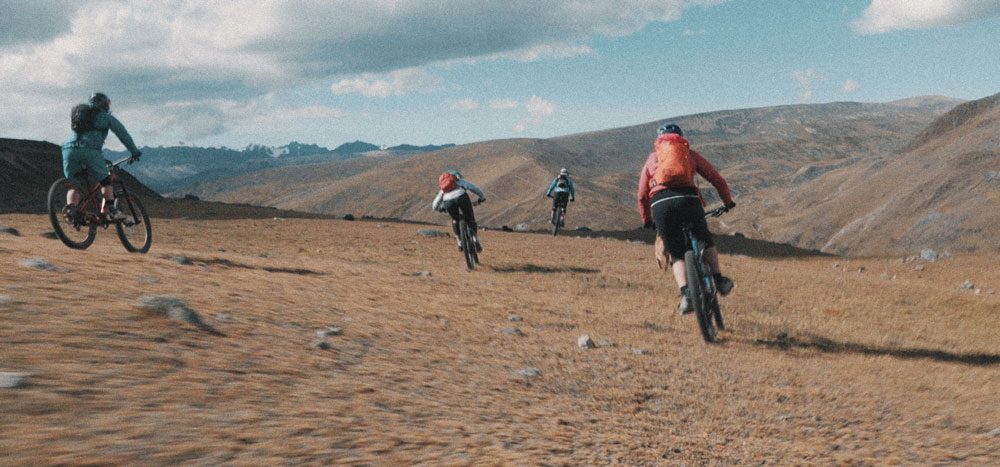
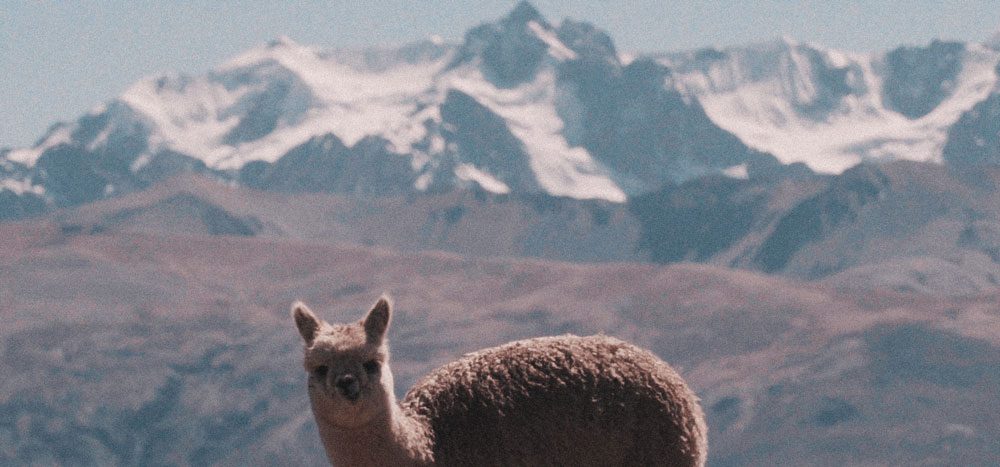
THAT LITTLE IDEA TO RIDE BIKES IN SOUTH AMERICA SEEMED SO FAR FROM WHERE WE’D ENDED UP. MAYBE IT WAS THE UNENDING ENTHUSIASM AND DESIRE TO PUSH OURSELVES THAT DROVE US UP THE MOUNTAIN. OR MAYBE IT WAS A SIMPLE FALLING INTO PLACE WITH THE RIGHT PEOPLE.
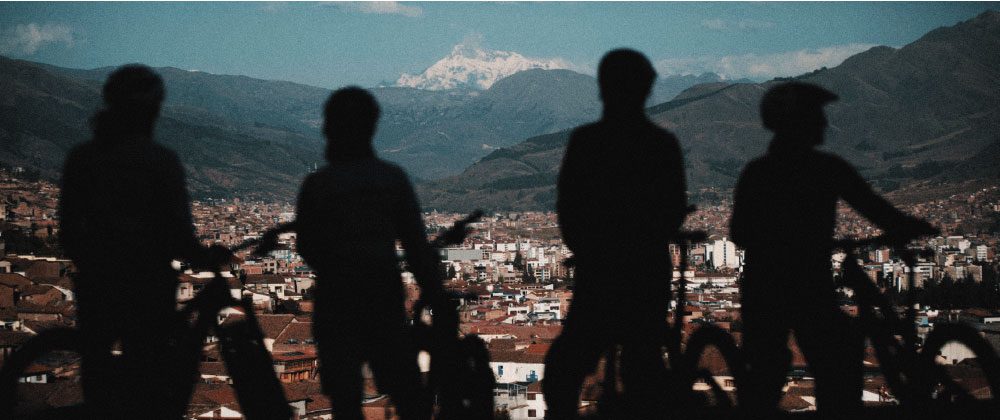
Journey’s End.
In Inca lore, Mt Ausangate is an Apu, the mother mountain spirit; the source of all good things and a caretaker to her land. She looked after us. That night, we reminisced back in Cusco over beers and burgers. That little idea to ride bikes in South America seemed so far from where we’d ended up. Maybe it was the unending enthusiasm and desire to push ourselves that drove us up the mountain. Or maybe it was a simple falling into place with the right people. The mountain let us make our little ideas evolve into something more; that we could grow a team that pushed each other when we needed, supported when necessary and cheered each personal accomplishment with wild abandon. It allowed us to connect with women who identified as moms, pro bikers and wilful wanderers. Our mish mash group of girls had taken a little idea and grown it into our own mountain adventure. As simply as we had come together, we were about to disband. I talked about a wee rest on a nice low-altitude beach somewhere. That was until Nicole let it drop that Haku Expeditions had organised a riding trip with Brett Tippie the next week…. But, that’s another story.

Sammie Maxwell - Destined for greatness U23 UCI World Champion
Words Lester Perry
Images Cameron Mackenzie
Some would say XC is dead (they’re wrong) and others would say we’re seeing a worldwide XC Racing Resurgence. Word on the street is that livestream viewing figures for XC far surpass those of the downhill, and those tuning in are treated to action-packed racing across all categories at each round of the XC World Cup.
It’s been a long time since we’ve seen a Kiwi XC racer hit the World Cup scene with the impact of Sammie Maxwell. She first appeared on most casual fans’ radars at the beginning of the 2023 season, and they’ve seen her climb the ranks, race after race, to become the World Under 23 champion for 2023, and finish the World Cup Series in 3rd.
Anyone who has been immersed in the sport for the last few years, particularly here at home in NZ will know Sammie didn’t just burst onto the scene in 2023 but has been on this path for a few years. What has brought her to where she is now -a World Champion and a strong contender for an overall World Cup title? We were fortunate enough to dig a bit deeper into what makes this fun-loving, small-town girl with a huge grin tick!
Although not from a particularly sporty family, living in Taupo – just minutes from the lake – an active lifestyle is more or less a prerequisite. Although studious and high-achieving at school, early life was so much more than study and learning. The freedom and flexibility Sammie’s environment offered meant that netball, trampolining, running, Pilates, triathlon, football, swimming, cycling, rock climbing, horse riding and more, were regulars on her to-do list, although she was equally happy to lie in a hammock and read a book. Anything that required energy or had an aspect of competition and Sammie was sure to be front and centre!
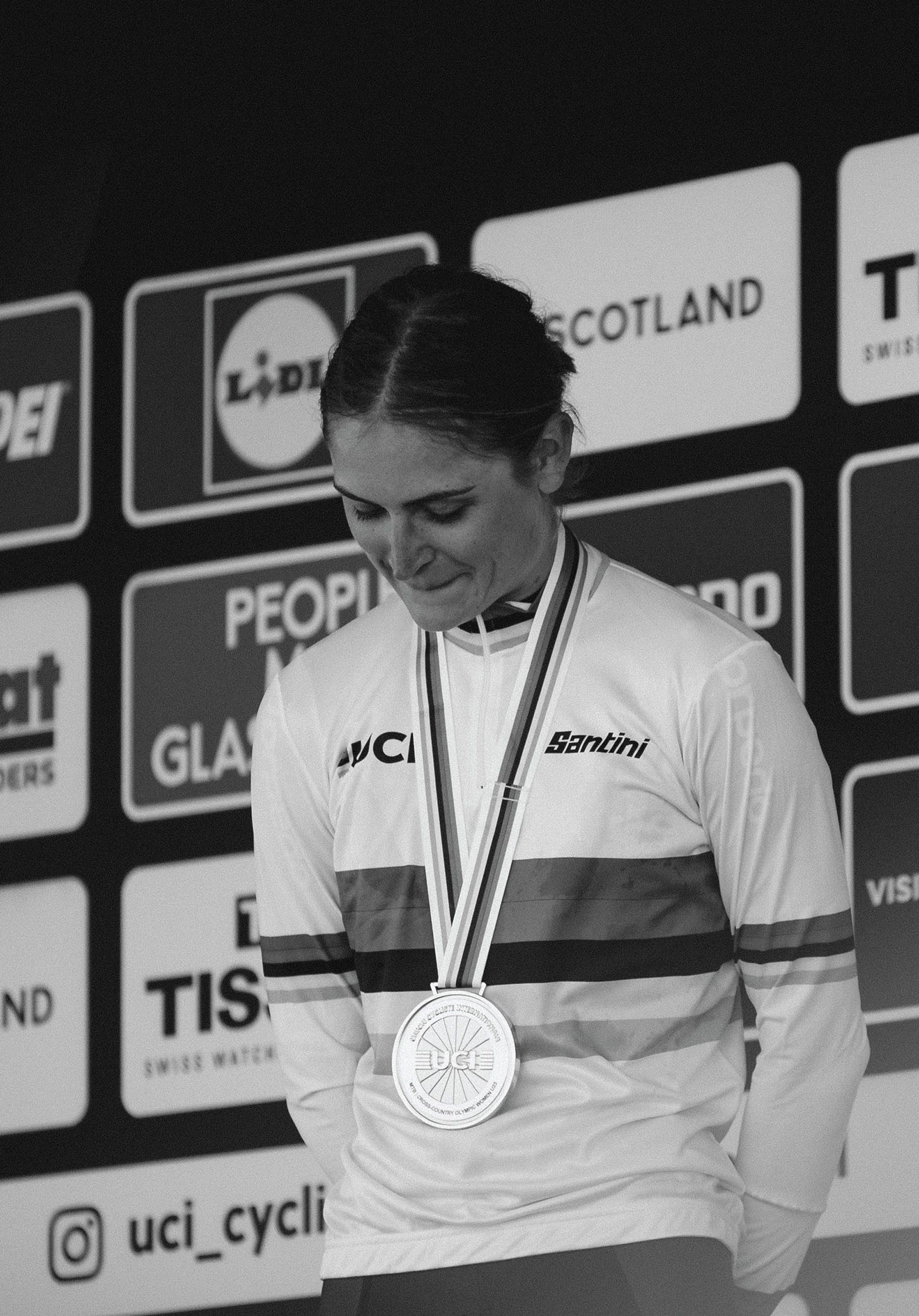
“I stayed in Taupo throughout all my schooling and certainly consider myself a ‘small town’ girl. I would enjoy the odd trip to the Mount with my grandparents where we would go to malls, etc but after a few days, the traffic and the shops would all lose their ‘exciting’ factor, and I’d much rather have the quiet Taupo streets!”
It’s commonplace for high-performing female athletes to excel in most areas of their lives, and Sammie is no different, slotting right into this stereotype. Throughout the early years, her inquisitive mind and passion for learning were continually stimulated by her parents; both high performers in their fields -her father an engineer, and her mother a laboratory phlebotomist. For years, Christmas gifts included books about biology and physics. A consistent top performer in her academic group throughout college, Sammie was awarded DUX in her final year. “In year nine, when our biology teacher gave us an assignment on a disease, we could pick whichever we wanted, and just research about it. I chose chickenpox because I had recently had Shingles (both caused by the varicella-zoster virus -Ed.). Being my typical curious self, instead of just reading a few lines of Wikipedia and calling it a day, when I got home from school that afternoon, I went straight to our massive bookshelf and got the five biggest medical textbooks mum had used while doing her study. I read everything I could about the virus, the immune system, the physiology of the disease and treatments. I became obsessed with the amazing ability of the immune system and knew from that moment on that I wanted to work with biomedical science.
“It’s fair to say that my teacher also agreed when the feedback for my report read something like: “Sammie, I asked for a college assignment, not something that looks like an abstract out of a university thesis”.
Sammie’s competitive nature spurred her toward mountain biking. “My brother and dad would go riding and I guess I wanted to be like them and join their adventures. I loved being ‘tough’ with the boys. When I was young, I would always be throwing myself into things my brother was doing – to try to impress him I guess. My dad would always buy us a McDonald’s ice cream after riding, and who was going to turn down a bribe like that!”
Alongside MTB rides with her family, Sammie picked up triathlon, meaning time spent road cycling. But she knew MTB was really where her heart was, even in those early years. “I love both types of riding and the road and MTB community in Taupo is so amazing, I really am lucky to have been involved in both; however, I always knew that when it came to racing, MTB was what I was best at and what I wanted to do.”
Sammie’s enthusiasm for all things biomedical science, and keenness for mathematics, led her to study a Bachelor of Biomedical Science, moving to Wellington to study at Victoria University. She graduated in 2022 with a Bachelor of Biomedical Science Majoring in Molecular Pathology.
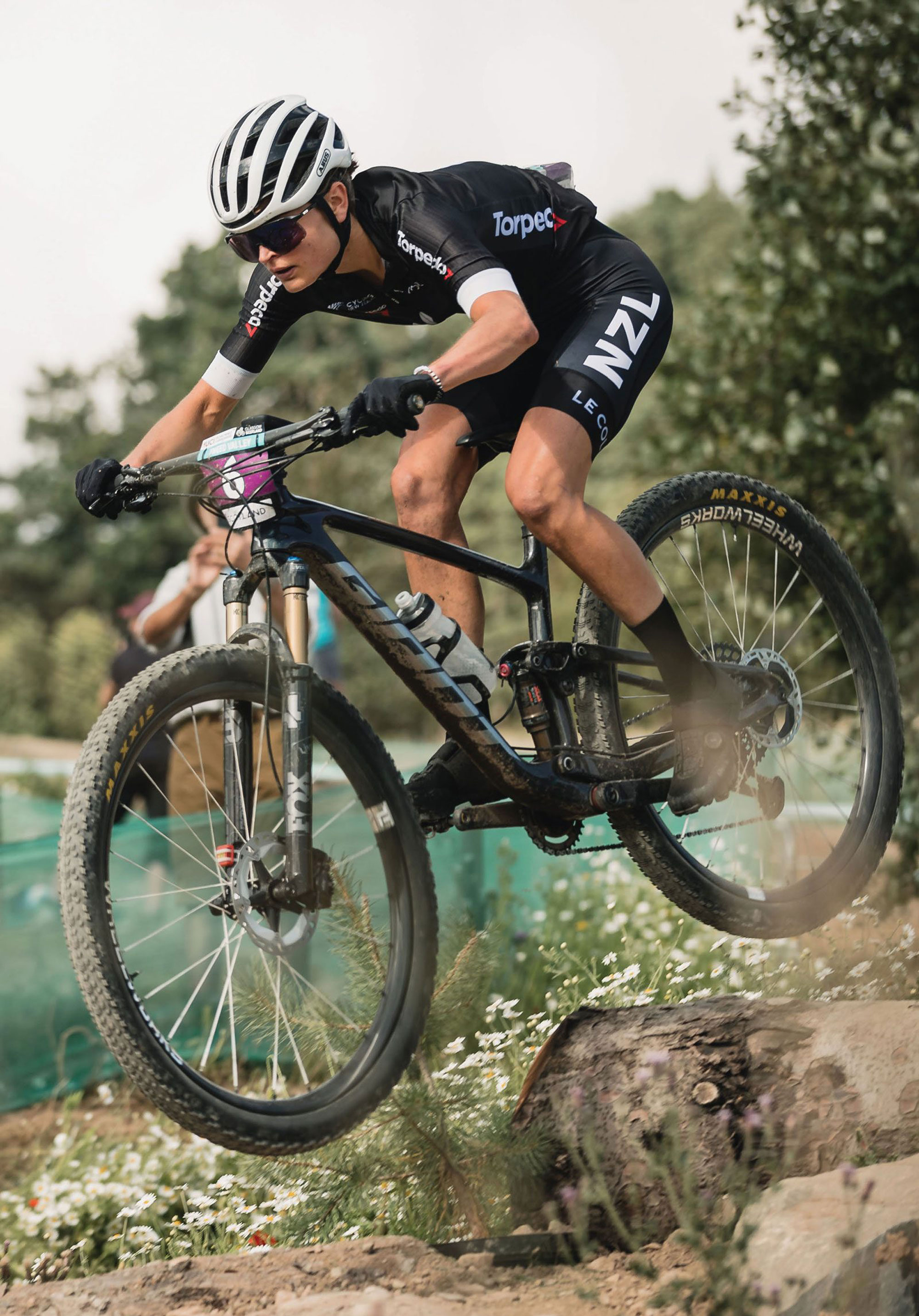
While training her intellect at university, Sammie was finetuning her racing craft on the bike, building the engine that has since lead to her success. Balancing a demanding study schedule with a strict training regime is a tough challenge and many an athlete has cracked under the pressure. Sammy powered through and, after graduating, began working in a research lab specialising in mRNA therapies and neurological disease research. She has a bit of a Clark Kent vs Superman vibe; outside of work life revolves around her training, but a quick change of costume, donning a lab coat, and she’s all business. “I have had my fair share of 5am wake-ups for training, and working until 8pm to fit everything in,” explains Sammie.
“I am lucky to have a great group of supportive people around me who can identify when I’m running low on energy (sometimes running on cortisol alone!) and remind me to take a break -often meaning dialling back the training a bit until the energy catches up. It’s hard work and definitely not something I could do all year around, but in the few months before heading for Europe, it’s nice to do one last push of mahi to remind myself how tough the ‘real world’ can be before jetting off to frolic around Europe for summer with my bike. It makes me very grateful when I am in Europe, and has taught me some intense work ethic which I pride myself on. In Europe when I have a big training day, I always remind myself I still have it easy – I could be in NZ doing that ride in the cold rain, in the pitch black at 6am – giving me an energy boost and making getting out the door a bit easier.”
All the hard work is now reaping rewards, but it’s been a long journey. Sam Thompson has been working with Sammie for five years, since pre-Covid times – first through the CyclingNZ Performance Hub but, after its demise, through the NZ MTB Academy. “We saw riders like Sammie prosper and develop exceptionally well under the MTB Performance Hub programme. When that was shut down there was a real gap in the development support network that needed to be filled. The NZ MTB Academy makes it possible to provide these athletes with professional support (coaching, sport science, strength and conditioning), professional guidance and also some financial support, to help bridge the gap from amateur to professional, and then also support them when they reach that professional space as well.”
In 2019, Sammie attended her first World Champs, in the Junior category, gaining useful experience and finishing in 14th. With racing on pause through the Covid period, Sammie used her time to address some issues which were hampering her success. “I have struggled with under-fuelling for a long time and spent a lot of time during Covid working with an Eating Disorder specialist, and psychologists, to get on top of this. So this year (‘23), when I showed up to Europe, I had a lot more maturity and was ready to start racing and recovering like a pro, to get through the season without fading.”
It wasn’t until 2022 that we saw Sammie start to settle into her groove on the world stage; the hard work of the previous years starting to pay off. It’s obvious from her results at the two world cups she raced in 2022 that her build to the top began back then, and was only exacerbated heading towards the 2023 season thanks to her methodical training and self-belief.
Coach Sam commented; “What stands out from others is her ability and belief to never give up, and her consistency of training. I would have trouble finding a session in the last five years that Sammie simply hasn’t done because she’s put it off. She simply doesn’t miss a session.”
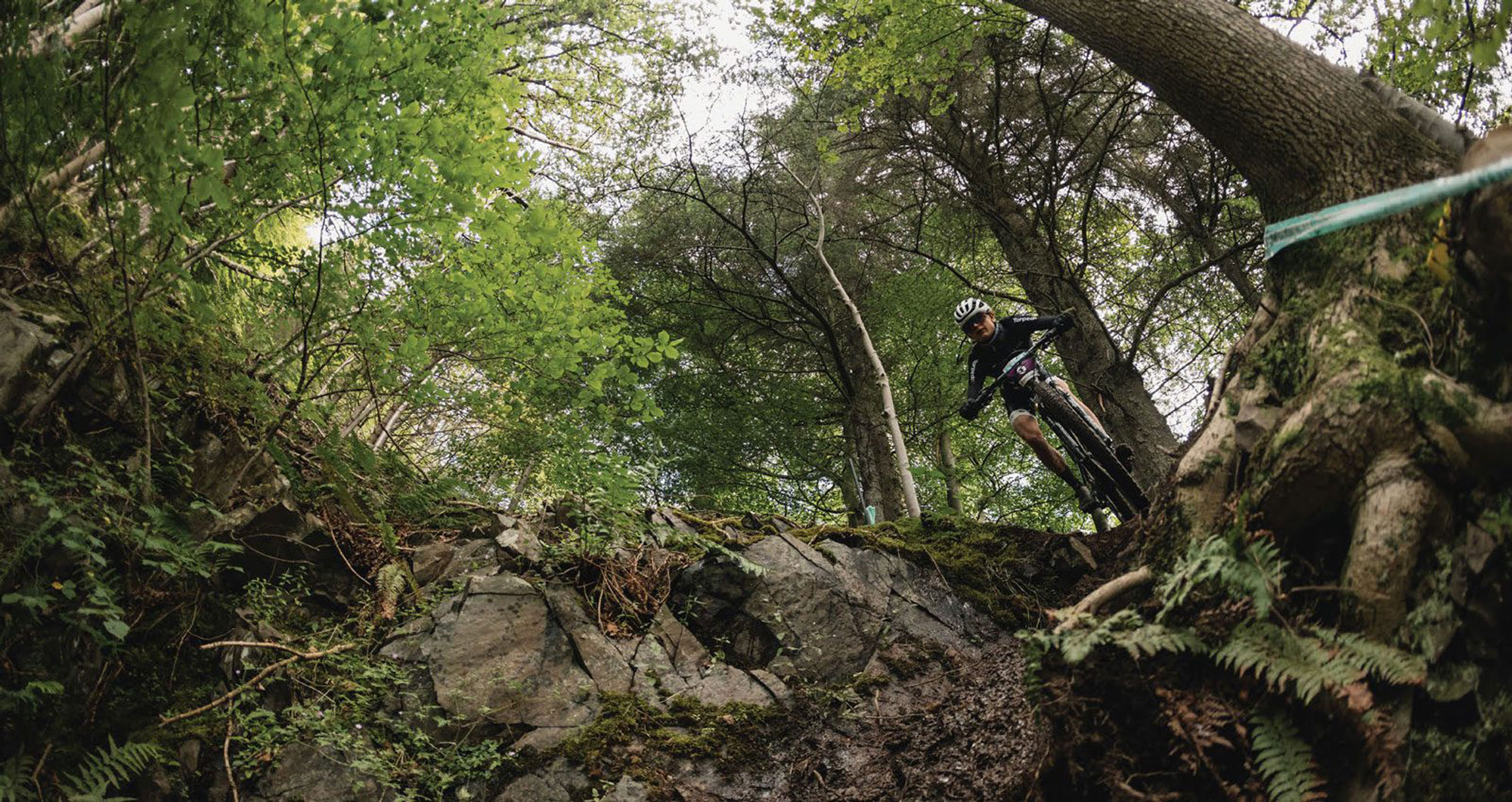
Trusting the process appears to be one of the keys to Sammie’s progress. The 2023 season has shown a consistent build right from back in May at the World Cup opener in Nove Mesto where she finished 8th.
“It was always the plan to not hit the season at peak form – especially since this is my first full season, and we didn’t know how my body would react. So we decided to start a bit slower and use the first few WC races as ‘form builders’ to introduce the intensity needed for racing. It was part of the plan to let the form physically improve through the season – but I think the biggest change was just gaining confidence in my ability and working my way through the starting grid.”
Following Nove Mesto, a month later, the World Cup circus headed to Lenzerheide, Switzerland. A confidence-building 6th place for Sammie and a solid build towards Leogang where we’d see a major breakout performance, with a 2nd place in the XCO after a tough Short Track (XCC) race to open the weekend. Two weeks later things were beginning to click in the XCC and Sammie crossed the line in 4th, the perfect primer for the XCO three days later. Another strong ride and into second at the XCO at Val Di Sole. Confidence, experience and physical form were all coming to a head just in time to peak for her season goal: the World Championships in Glentress, Scotland Then, on the 12th of August, Samara Maxwell became U23 Women XCO World Champion! After a dominant ride, distancing the field on the first climb, she eventually crossed the line draped in a New Zealand flag, having made history; the first Kiwi woman to win a Cross-Country world championship.
“In the days leading up to Worlds we had made a minor suspension change, but everything else was pretty much the same. I think just steady training for a few weeks with some good days over the local ‘cols’ and riding with Ben Oliver helped a lot; I accumulated stress on the bike but Sam (coach) and I were also watching closely because we knew the worst thing we could do would be to accumulate too much fatigue and dig myself into a hole before the event which can easily happen during pinnacle points in the season.
“I was lucky also to have the help of Louis Hamilton in Scotland; he showed me the best lines to take on the course and, as a privateer, this is something I don’t have access to at World Cups, so I owe a lot of my success on the day to him!” Sammie now had the spotlight firmly on her as she steamrolled into the remainder of the season. Heads were turned and everyone wanted some time with the “fresh face” in the pits, who they’d seen grow and develop quickly through the early season. Her secret was out and she thrived on meeting and chatting with so many new people who were discovering this fun- loving, Kiwi world champion for the first time.
“The people are amazing, and the sport is growing so much -it’s awesome! Changes to broadcasting this year allow people back home to watch my races and that’s helped increase the number of people following the sport and created a very exciting atmosphere at events. The girls I race with are amazing and I’ve met some amazing friends this year -I am just so excited to watch this sport develop over the next few years!”
Prime conditions and a strong race in the XCC rewarded her with second place at the opener in Pal Arinsal, Andorra. Sammie’s first outing in the XCO World Champs stripes would come a couple of days later, and in the toughest conditions of the season so far. The venue was hit with storms in the hours leading up to racing, forcing schedule changes (meaning no live feed) and leaving the course sodden and slippery. The form was there but conditions -and the venue being at over 2000m elevation –meant Sammie couldn’t unleash what was required to be back on top, finishing a credible 4th place.
Les Gets was next on the calendar and another dominant display in the XCO where she effectively put her competition to the sword on each climb, putting the group under pressure every time the gradient tipped up. After multiple lead changes throughout the race, Sammie finally made it stick on lap three, taking the lead once and for all, and maintaining a 30-second lead. It wasn’t all said and done, however, and she narrowly avoided catastrophe; crashing on a grassy off-cambered corner in the closing minutes of the race. Fortunately, her gap to second place was enough, and she limited her losses to cross the line with a stellar dance move finish line celebration and take her first World Cup win!
Never one to completely relax, Sammie has taken up learning French this season to keep her mind busy between racing and training. In years to come she’ll be getting plenty of French language practice, after a mid-September signing to high profile, French-based team, Rockrider Ford for the remaining 2023 races, and through until 2026.
“It’s been a dream ever since I can remember to be a professional cyclist. I’m beyond honoured to say, that thanks to Rockrider Ford Racing Team, this dream is finally a reality. I already feel so at home in this team and have had the biggest, warmest welcome. It only makes me more excited to see what we can achieve in the future together.”
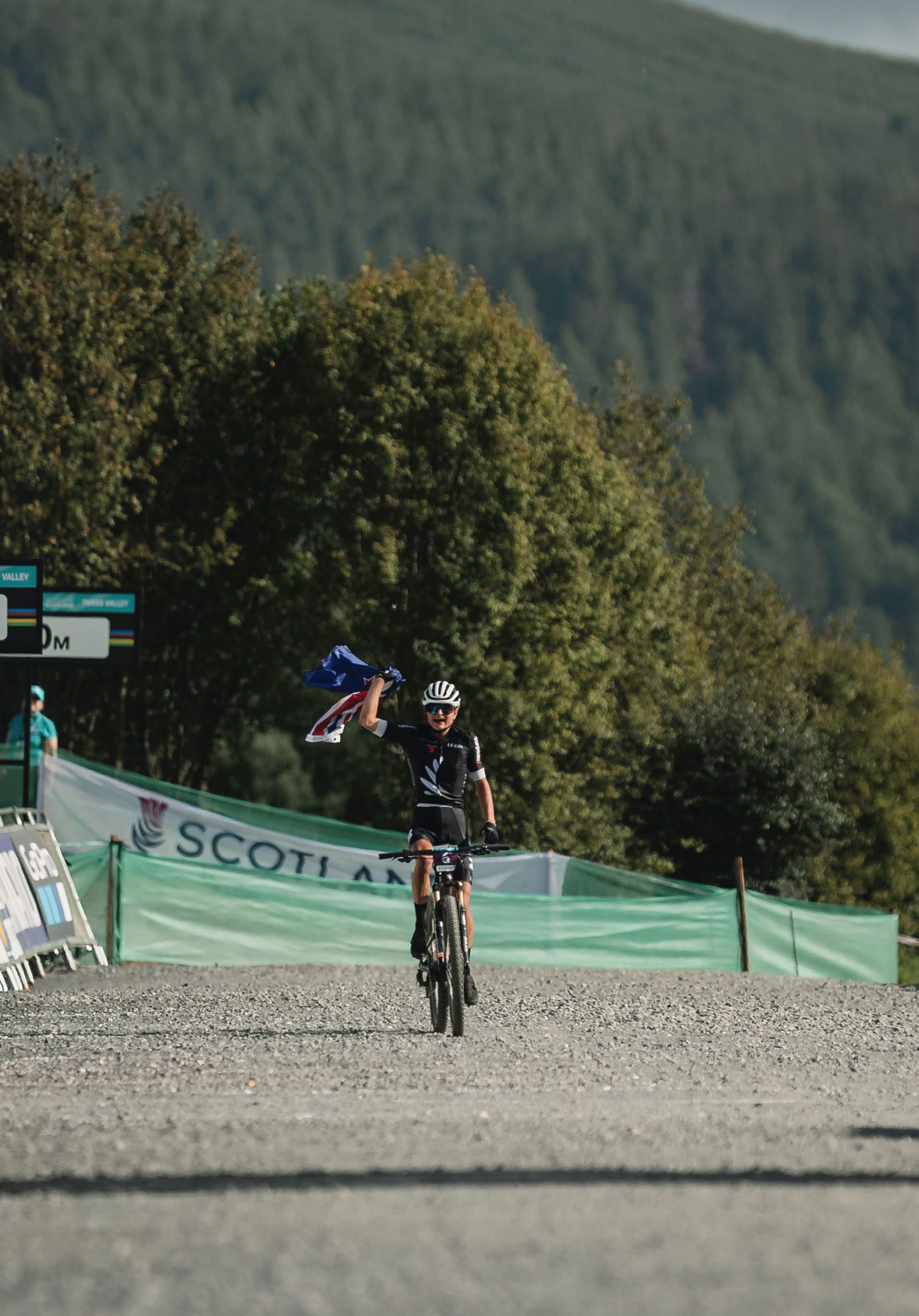
With all of the downsides of being a privateer now being taken care of, Sammie can focus solely on being a professional athlete, no longer stressing about having no income while racing across the world. With the mental load of finances and logistics now removed, preparations for next season are already underway. One of Sammie’s goals is to improve her technical descending, an area where she and her coach identified she’s been losing time to her competitors.
Sammie came out swinging at the debut race for her new team in Snowshoe, West Virginia for the XCC World Cup Round 7. Another solid race battling Ronja Blöchlinger for the win but narrowly missing out, finishing second. Snowshoe’s XCO race shaped up to be another epic battle with Blöchlinger, but this time it was Sammie who came out on top. It almost wasn’t to be though, and she narrowly avoided a huge crash on the opening lap, washing the front wheel out on greasy rocks and colliding with a tree, fortunately she stayed upright. Sammie put in a cracking ride, regaining her composure to go blow for blow with Blöchlinger in the early laps. Sammie continually pulled time on the climbs, and by the mid-point of the race had taken lead for the final time, growing the gap for the remaining laps to take the win by a minute, marking a perfect start with her new team.
Next up was a trip across the border to Mont-Sainte-Anne, Quebec, for the eighth and final race of the 2023 season. Blöchlinger rounded off her perfect XCC season with her eighth win, just pipping Sammie for the win again, and collecting valuable overall series points. The XCO race saw the toughest conditions of the season; rain had set in, making the technical course even more technical for even the most skilled riders, leaving them battling not only each other, but the conditions and course as well. At times, the race looked more like a duathlon than an XCO with most riders taking to running sections at times. Thanks in part to Stephan Tempier’s line coaching, Sammie rode the technical sections confidently.
“I was able to ride everything in the wet, even really tough sections that the elite were crashing on, so that was a huge positive. It meant I felt safe and confident and was able to have sooo much fun slipping and sliding my way past people!” Proving her mental resilience after a start loop flat tyre; she chipped away at the field for the entirety of the race, eventually finishing fifth, securing herself third place in the overall series and cementing herself as one of the world’s top XC riders. When asked about any wisdom she wished she had known earlier in her career, and what tips she’d pass on to other young women looking to break into the World Cup circuit, Sammy offered some clear advice:
“Never feel like you’ve got to make sacrifices or suffer unhealthily to succeed. In our heads, we often think elite athletes are insane people who have super-human abilities to suffer, and when it comes to physical training yes, they do suffer, but when it comes to their mentality, the top-of-the-top athletes protect their mental health above all else, and this is something that’s taken me a while to figure out. If our brain is unhappy or starved of the joy and energy it needs, we will never be able to perform at our true potential. So always make sure you are looking after your body and giving yourself the rest you deserve! Plus, eat the damn dessert! I spent too long turning down yummy foods because I thought it was what a real athlete would do – when in reality, ice cream is your superpower! “What it takes to win should be sustainable and enjoyable. You need to believe in yourself, and you can’t do that if you keep feeling like you are having to change the way you function or change what you want to do to succeed. It should come naturally. I can say I wasn’t acting any different for my lead into Scotland than I was during the middle of winter last year in NZ – once again it’s just a matter of trusting the process, loving what you do and enjoying yourself while you put in the work!”
No one gets to the top alone, and it takes a village to support an athlete as they work their way there. Sammie wanted to pass on a special thanks to all who’ve helped and supported her in this journey so far.
We’re excited to watch her develop and see where Sammie’s career takes her as she steps into Elite for the 2024 season. One thing’s for certain: that grin of hers will be showing up in race coverage for many years to come!

Royale with Cheese Part 2
Words & Images Jake Hood
Our day started early. We packed up all our stuff, and left behind the items We didn’t need to take up royal. then we set off. the morning started With a tiny bit of technical sWitchback trail, then an off-the-bike hike down a cliff to the riverbed below. the dirt Was a lot drier than the day before, Which Was a good thing because it seemed like the day was going to be technical.
We hit the riverbed, crossed a small stream, and reached the start of the Mt Royal walking track. To begin with, it was a bike-on-your-back approach -we were literally climbing up a cliff face with our bikes. The rock we walked on was covered with moss, and we had to think about where we were walking and where our next step would land us. Once we got past that point, it was just a pretty steep, relentless push for about an hour before it mellowed out. It was one of those hills that is steeper towards the bottom and mellows the further you go up. The soil changed as well. It was pretty clay-like at the bottom, very slippery in the wet. The further up we got, the less present the clay was in the soil, giving it a more predictable nature. The foliage and cornflakes (some might say ‘loam’) that covered the trail seemed to get thicker as we gained more altitude. You could tell this trail wasn’t used that often; it wasn’t a worn-in, obvious track like many of the others in the area. There were a few times we lost the track on the way up. The trees were spaced pretty far apart, leaving heaps of space to hold it wide open on the way down. The trail wiggled its way up the mountain, covered in a spiderweb of root gardens. Some of them had huge roots that created large steps to get over, potentially causing a wheel stopper or going over the bars. I later found out this was the case.
Near the top, we stopped for a spot of lunch. I think we’d have been pushing up for about three hours or so by that point. It was pretty hard going. We stopped at a beautiful little opening in the trees that gave us a great view of the Richmond range. Mt Fishtail lay just before us. What a mountain that was. Lunch chat consisted of more talking shit about Bradshaw almost bailing and how good the DB Draught was going to be at the pub that evening. You could see the top of Royal from the spot. We had to descend along a ridge for a little bit before the final push up into the rocky alpine. It was going to be about an hour to the top.
It wasn’t long, though, before the chat ended up beIng about cold frothy beers and food at the pub later on. how good were those beers going to be?
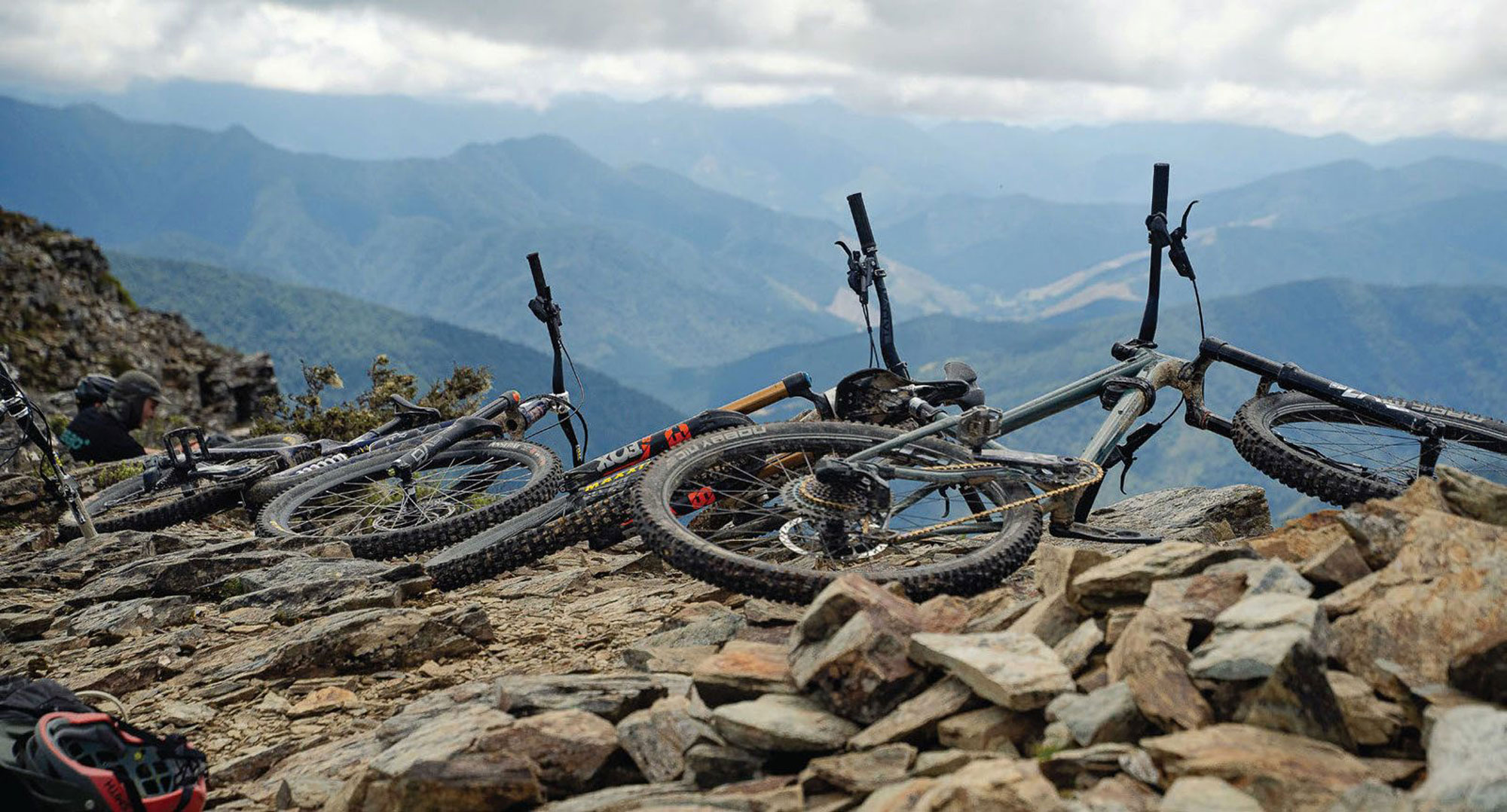
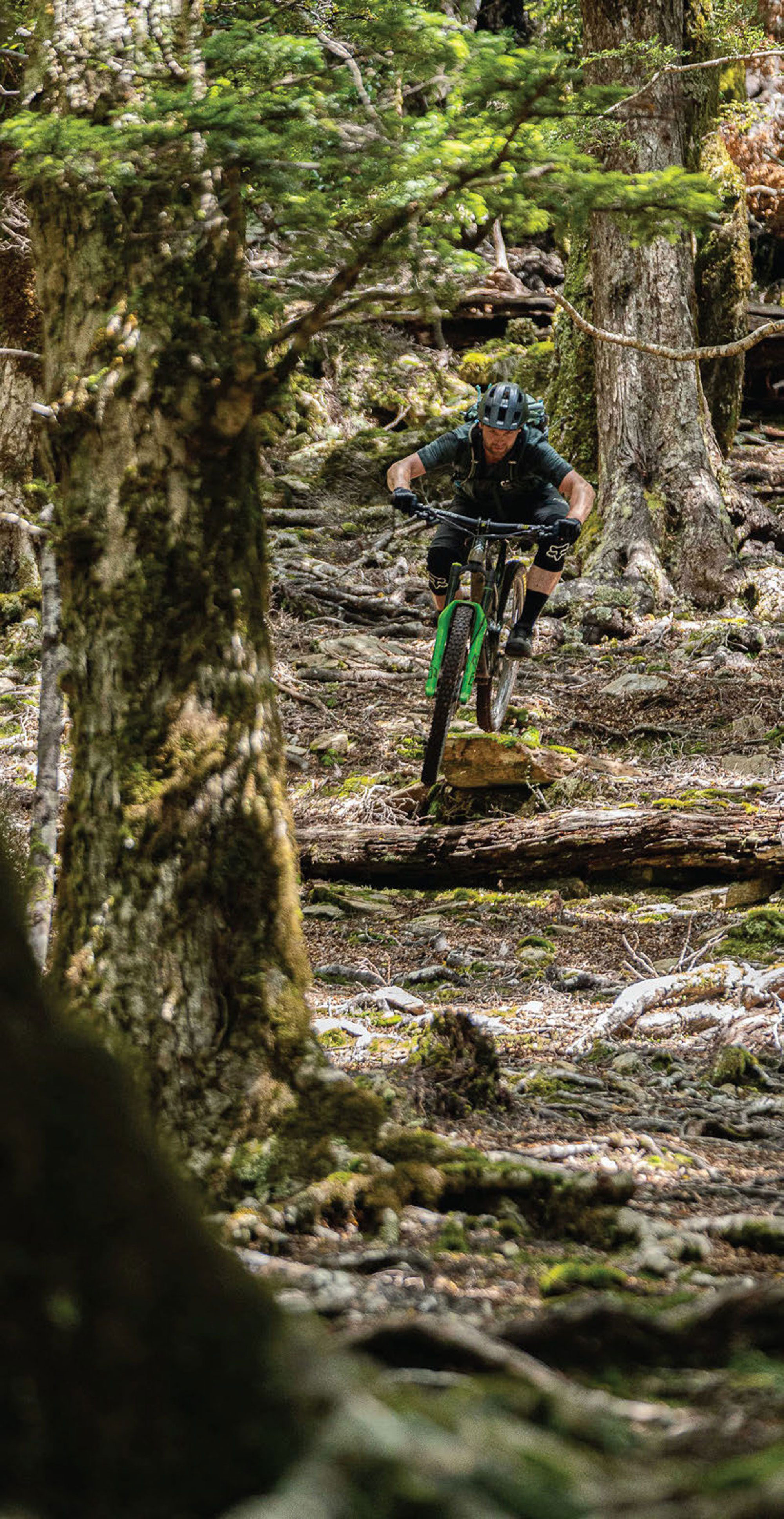
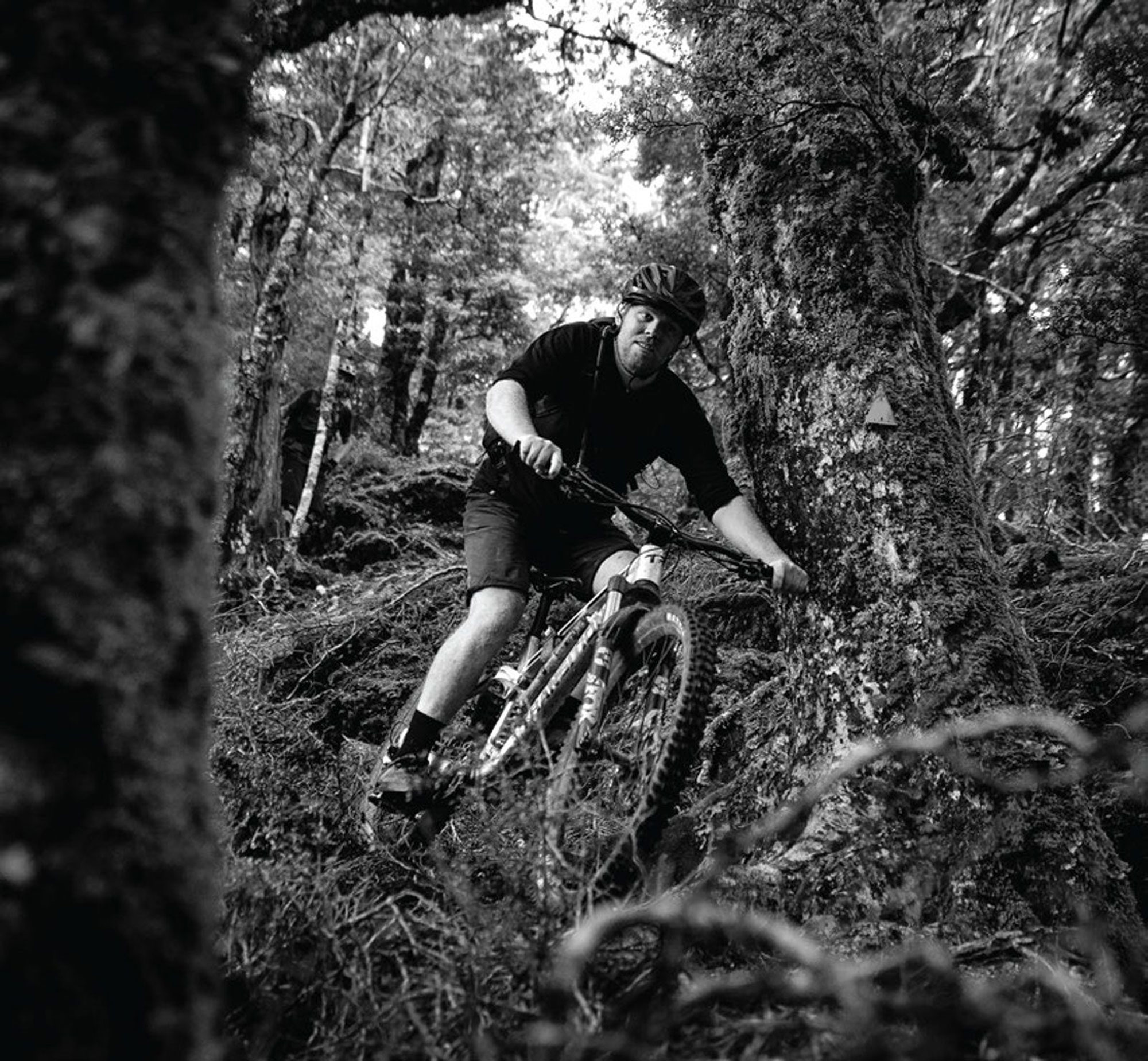
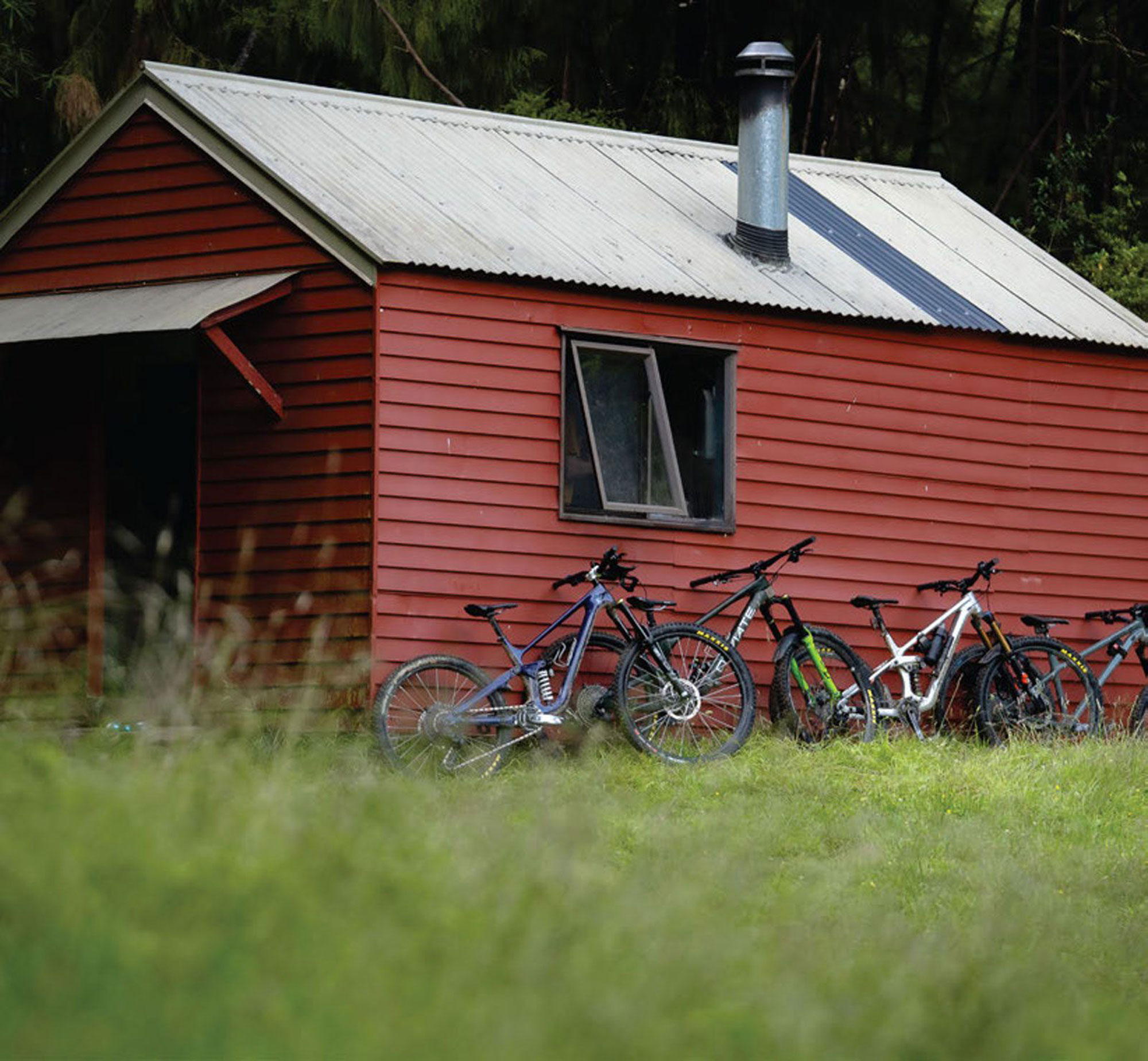
No one wanted to descend the ridge first; it was pretty damn steep -and none of us knew how slippery it was going to be. The track sort of just disappeared, and it was a bit of a pick-your-way-down, trying to find places where you could get some good braking in. Turns out that going first was probably the best option, though. The locked rear wheel scraped off all the good foliage to brake on, and left behind slick black sludge. If you locked the front brake on this, you would know about it – but it was fun to pick our way down.
As we pushed up the last stretch, the trees started to thin out and the trail was more defined from here through the rock and scrub -nature hadn’t taken back the track like lower down. It was a bike-on-the-back hike up through the loose big rocks and some nice big bits of slab which made up the trail. My legs were starting to feel numb and heavy on the very last bit of the push; that pre-bonk feeling. Thank God the top was close. As we rounded the final bit of the mountain to the summit, the wind started to howl. It was strong, and our bikes acted like sails in it. The last stretch was a small walk along the flat to the top. Woohoo! We had made it to the summit of Mt Royal.
It was a clear day, and you could see for miles. There was a blue haze over all the hills. To the west, Mt Fishtail basked in the sun above the rest of the Richmond Range. To the east, you could see Blenheim, the Cook Strait, and the very faint outline of the Wellington coastline. The 360-degree views were stunning and the endorphins were kicking in – that high you get from reaching a summit. High-fives and hugs were thrown about, with smiles all around. These are the moments we do this for. Well, that and the fact we had a flipping awesome descent back down to the hut ahead of us. The howling wind was pretty chilly, so we chucked on some layers and found shelter just off the top, behind some rocks, to enjoy the view for a bit before we headed back down. You have to savor these things.
The trail eventually led to the point where we had to get off and hike back up to the lunch spot. From there, it was all downhill back to the river. What a time to be alive.
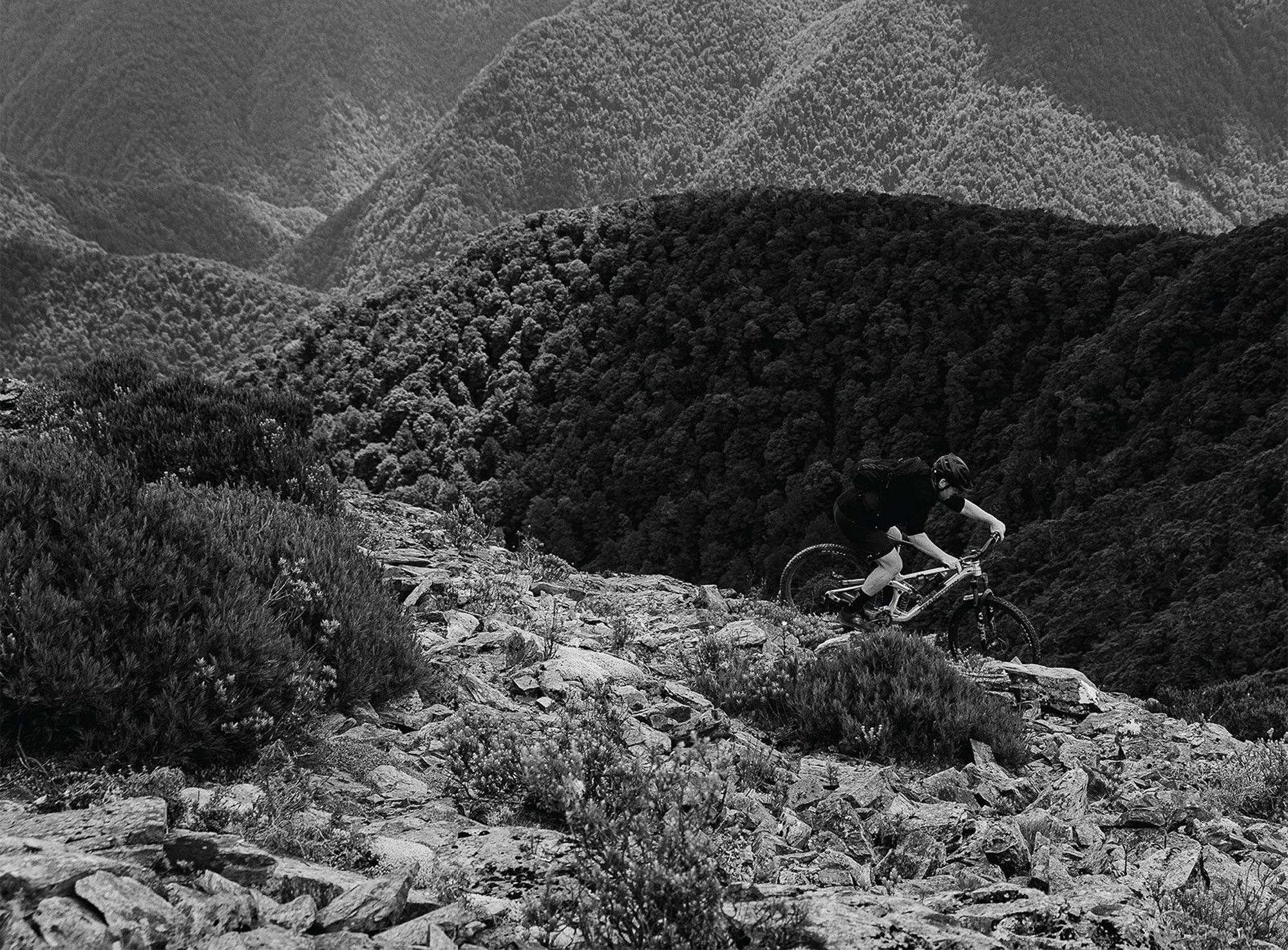
It wasn’t long, though, before the chat ended up being about cold frothy beers and food at the pub later on. How good were those beers going to be? This thought quickly prompted us to get back on our bikes and start heading down. Off the top, you have to ride along the flat, leaning your bike into the side wind until you start tipping into the trail. Paul, Scotty, and Cappleman were keen beans and started attacking the rocky shale alpine. Big long rock slabs covered in wheel-sized cracks, with drops off them into foot-sized loose rocks that moved below your wheels, made up the track. There were a couple of switch-back turns which made it even more fun. The sound of the terrain moving below your wheels while your bike danced through the chunder was delightful. Bradshaw was making light work of it on his hardtail, with a massive smile on his face. As the vegetation started to appear, the surface became more gravel-like, and the trail became more defined. Scotty, Paul, and Cappleman were off on a mission. The trail flowed along the ridgeline, turning left and right through the scrub. It had small undulations that you could use to pump or pop off. The surface was soft and gravel-like with some rocks and cornflakes mixed in. My bike felt amazing -the suspension was just fluttering along through this stuff, tires were hooking up a treat as I weighted the bike into the turns. You could feel the side knobs carving into the loose ground.
As the Beech forest thickened, the trail started to steepen. We stopped at this steep roll feature that we had looked at on the way up. It looked like a goer, and the way around looked pretty ugly. It was just a matter of if we would be able to stop after. How much speed would you pick up off of it? Would you be able to slow down before the turn into the next shoot? Paul tipped in first and greased it, making it look easier than it should have been. From there, we all hit it. It was a fun feature. In the dry, you could have hussed off it.
The trail eventually led to the point where we had to get off and hike back up to the lunch spot. From there, it was all downhill back to the river. What a time to be alive. The trail followed the ridge along for quite a while; not super steep, just enough of a gradient to keep the speed up without pedaling. The faint trail flows through Beech forest and is covered in deep, mossy foliage. The occasional fallen tree covered the track, but some logs had been placed in front of them, turning them into a feature to huck off. We whistled our way along the ridge, freeride flicks happening everywhere, foliage and sticks flying from the tires into the air. The bikes danced over the slippery roots and rocks that lay beneath. The trail would go from flat out to a few slower speed turns and back to flat out. There were whoops and hollers coming from everyone.
One ridge led to another, and things started to steepen up. Just off the ridge was where the trail took us. It was steep, covered in deep leaves. The trees were sparse, and turns in the trail were long and sweeping. This was my favorite bit of the trail. The dirt was super slick under the leaves, and you could drift around the turns with your foot off; opposite locking on the way in and letting the back wheel slide out on the way out. Just left, right, left, right. It was amazing. So much fun. I just could not wipe the smile off my face.
A second wind must have hit us because we started hitting it hard. the pace increase was insane. The pub wAsn’t far awAy; it was in sight, like a glowing beacon of happiness.
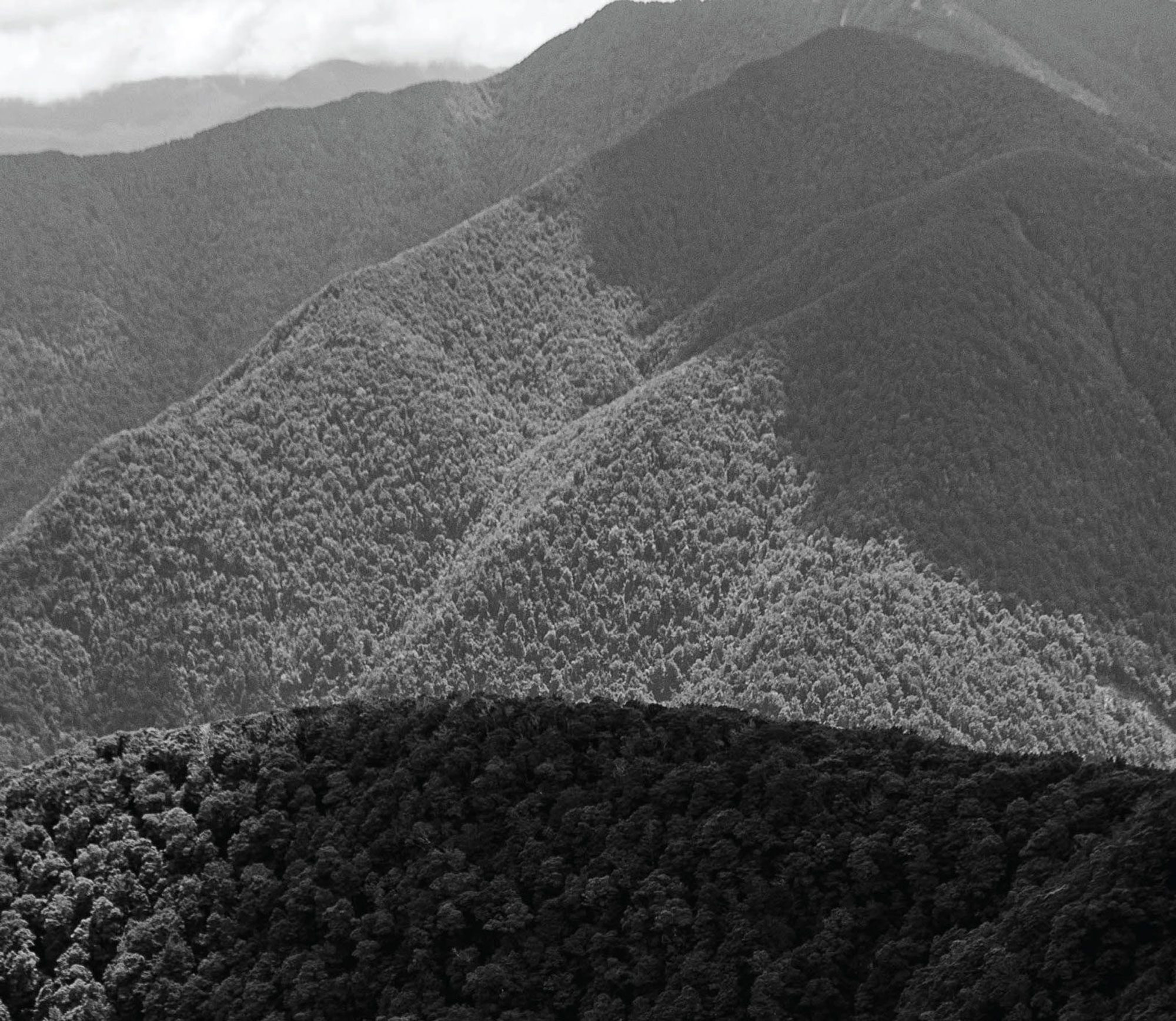
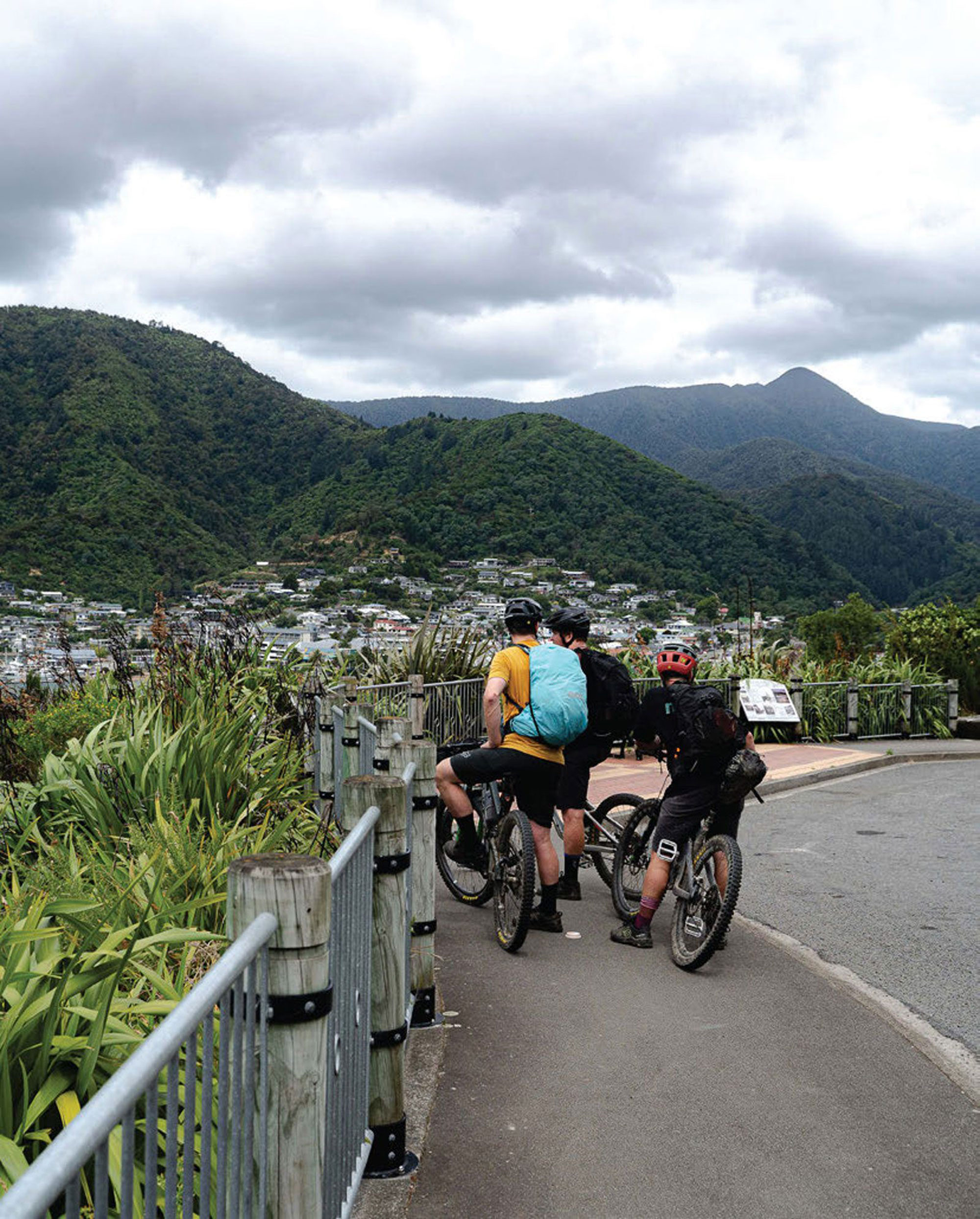
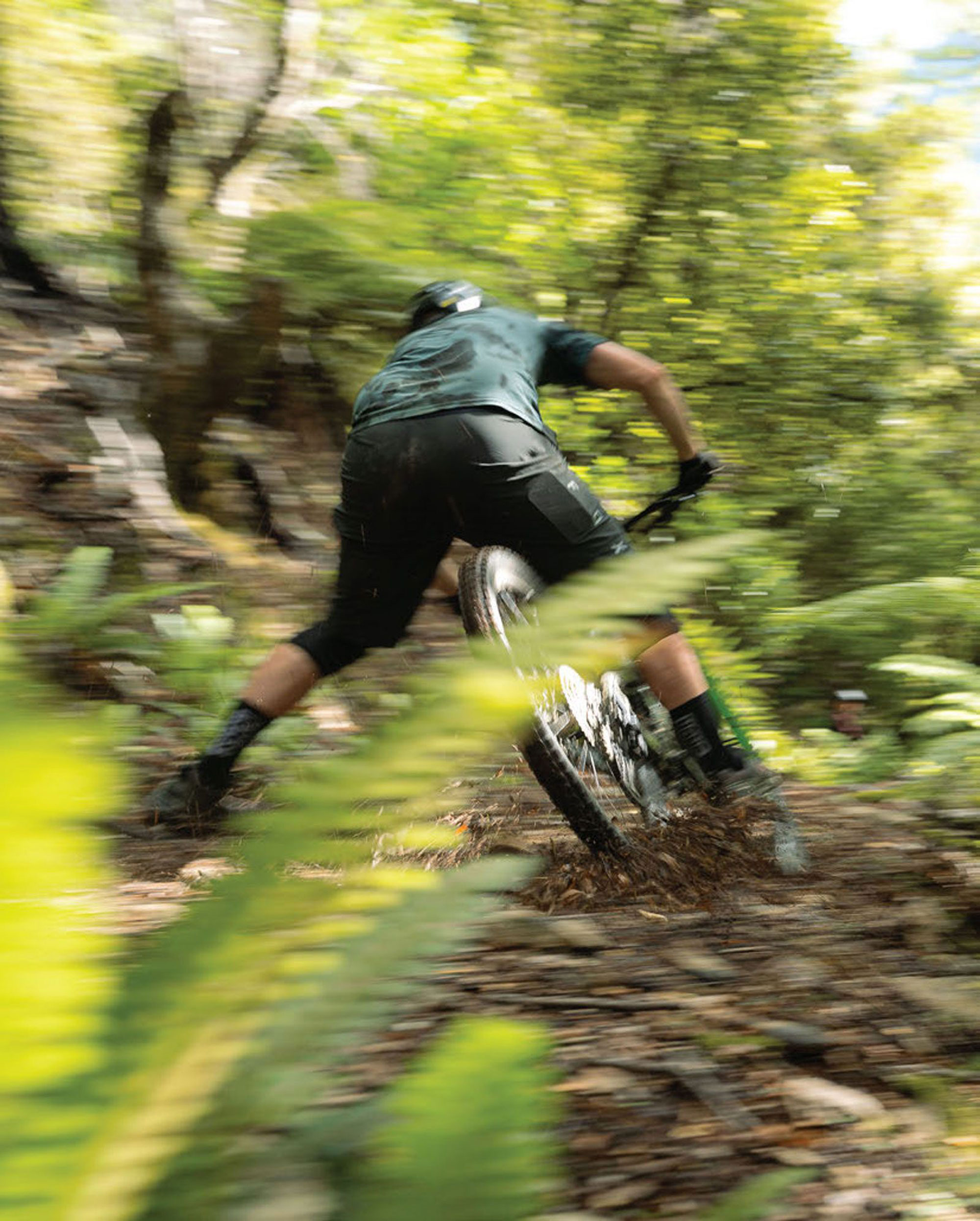
After that bit of speedway fun, the trail popped back out on the ridgeline. You then work your way through a long section of janky rocks, which meant travelling at a slower speed than what we had ridden so far. Thinking about lines was key: be precise. Momentum did help, but going at it full attack wasn’t going to end well. Personally, I love this stuff. It’s a challenge to ride. It takes skills, balance, and confidence to get you through.
After that bit of tech, you come off the ridge and back onto the face of the hill. It was a bit of a choose-your-own adventure at times since the track just disappeared at points. We were just pointing our bikes down the hill and following our noses till we found the trail again. Fallen sticks cracked and snapped under our wheels – it was a lot of fun. The further down the trail we got, the more technical it got, and the speed started to reduce. The huge wheel-trapping roots started to come out. You had to be on your game; think about your line, commit, and hold momentum through these. One of these wheel-trapping root sections caught me and sent me out the front door. Luckily, I was okay and landed in the soft foliage.
The steepest part was the last – and potentially the sketchiest – bit of trail. It got really steep, with huge steps into compressions. The dirt was clay, so grip was at an all-time minimum. We rode some of this, but the compressions were hard on the body, and you really had to find a flat platform to come to a stop to control your speed. The green, mossy clay dirt was doing its best to help the tire slip and slide. The bottom was so close, and you could see the riverbed…. and also the cliff you would ride off if it all went wrong. Sensibly, at this point, we decided to get off and hike down the last part. It just wasn’t worth the risk. I even managed to slip just pushing down, which resulted in my falling on my bike and bending the derailleur hanger. Shit. It wasn’t good. It looked fairly bent, but I would have to assess it back at the hut.
We scrambled down the last bit of cliff/trail to the riverbed. Fuck yeah. Royal was done. What a trail that was. Different from everything else I have ridden so far in the Richmond Range. It just had so much variety. It was wide and fast with some tech features mixed in, and less scary to ride than Fishtail or Riley. God, it’s amazing what you can do on modern mountain bikes these days. Bradshaw was the man of the match on his hardtail. What a guy.
We stopped for a quick look at the vieWpoint overlooking picton before We rode down the road into town, grabbing the bag of clean clothes We had stashed two days earlier out of the bushes. We had done it.
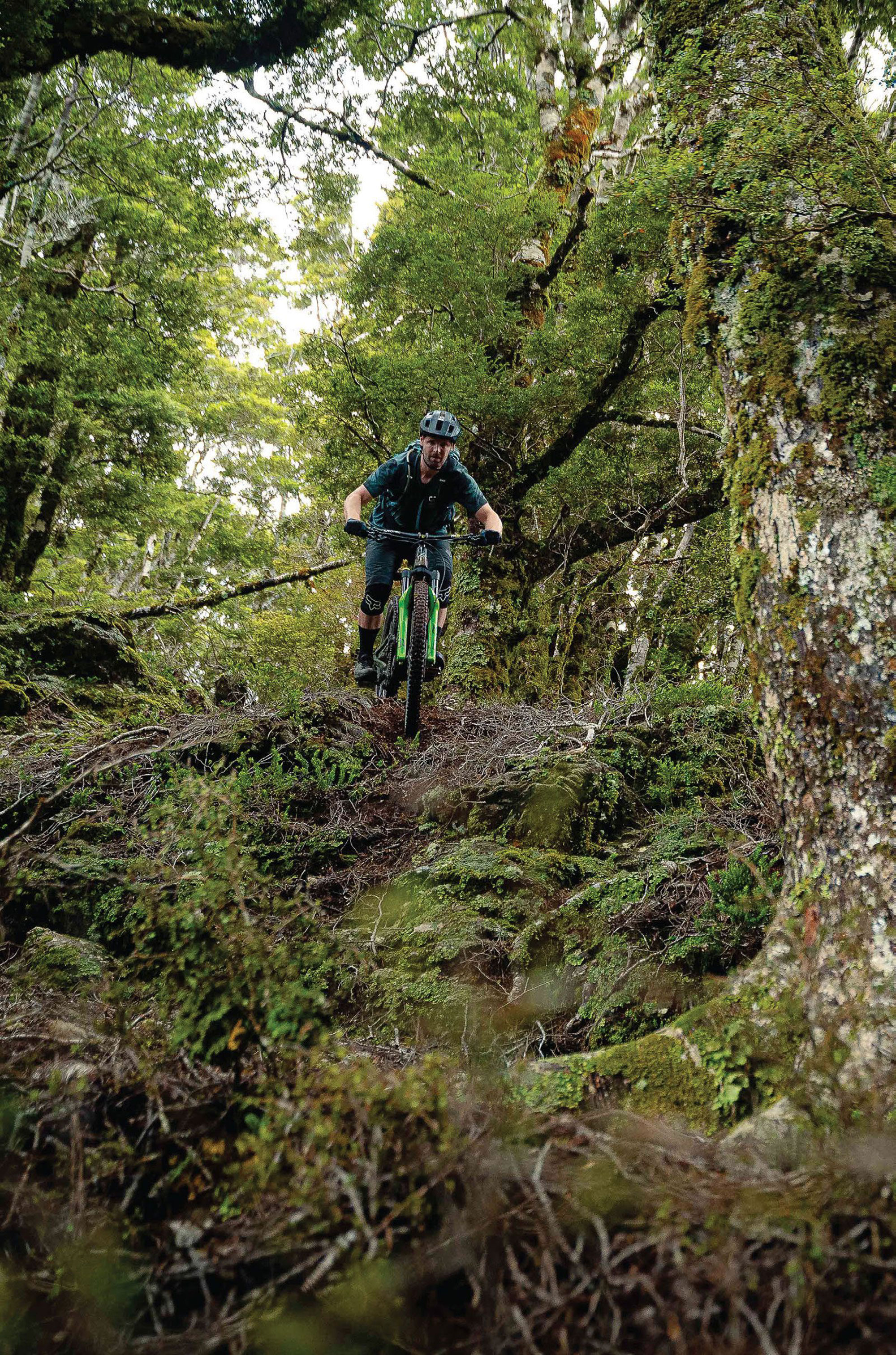
The day wasn’t over, though. We had to get back up to the hut, pack up and load up the bikes, then get out to the Canvastown pub. There were still a few hours of hard work ahead. We crossed back over the small river and scrambled our way back up the basically-a-cliff-face to camp.
“I’m glad you bullied me into coming up. That was fricking epic,” Bradshaw jokingly said. It really was. Back at the hut, we loaded up the bikes. Well, Scotty, Paul, Cappleman, and I did. Bradshaw instead decided that he was going to completely unpack everything and repack it all again, which might not sound funny but, when he’s doing it in his underwear (for some reason), flailing around like a wobbler in the long grass, which was very bee and wasp-populated, it made for some very entertaining watching. Especially every time he got stung. We were in stitches. “What are you doing?!” we yelled at him. After about 15 minutes, we got bored and headed off onto the trail out, as we didn’t want to get stung. It must have been another 15 or 20 minutes before Bradshaw joined us. Wobbler of the Week, right there.
Seven kilometres of trail lay ahead of us, back to Butcher Flat campground, then a 15km ride to the pub at Canvastown. By this point, we were all pretty tired and over it. The inevitable come down from the high was happening, and the next part was going to be a bit of a chore. It’s funny how many emotions you go through on these big days. As we headed back out on the trail, I could feel that my legs were pretty weak. The hiking up had taken it out of them. I had to walk the steep pinches in the trail as the bent hanger had taken away the ability to use the top gear. Amazingly, the rest of the gears were fine. I was going to have enough to get me back to Picton. The SRAM AXS is pretty damn great. I just got my head down and pushed through. It wasn’t a super fun trail to ride out, more of a means of getting somewhere but, after about an hour, we arrived at the road back to Canvastown. The pumps got wiped out. Tires inflated to near maximum PSI for extra rolling speed. Time to grind this road out.
Something must have come over Paul and Cappleman because they decided to set off at a blistering pace, leaving the rest of us behind. I had my headphones in, listening to a podcast, and sort of just hit the road at my own pace, spinning up the climbs and pushing a bigger gear on the flats. Scott and Bradshaw were a little ways behind on the road. I think their legs were dead. I just got my head down, zoned into the podcast, and spun away. I made sure to enjoy the place I was in. This valley reminded me of my home back in Scotland; very green, lots of farmland, and pine tree forests. Having ridden the road the day before, there were certain landmarks I recognised, giving me an idea of how far to go. Boy, I was excited for a beer at the pub after this big day. As I passed Bradshaw’s grandparent’s hut, I knew it wasn’t far – just 2km or so. By this point, Scotty and Bradshaw had caught me up, and we got in a chain gang. A second wind must have hit us because we started hitting it hard. The pace increase was insane. The pub wasn’t far away; it was in sight, like a glowing beacon of happiness.
The bikes got parked up. Paul and Cappleman had found a good seat and were already on the beers. DB Draught was the only real choice. Now, I’m a bit of a beer snob, but there is something great about a cold DB Draught after a big day. I think it’s just made even better by the fact you’re drinking it in this old, rural pub. The pub had recently been taken over by new owners, and the place was pumping with regulars. It had a very homely feeling. Somewhere you could just settle in for a big shift, and that’s exactly what Paul was doing. The man was putting them away like they were water. By the time I’d finished one, he would have done two. It was a bloody great drop though; refreshing, crisp, just perfect. We settled in and reminisced about the day. It had been so great -awesome crew, amazing trail, and just the perfect amount of struggling. How good.

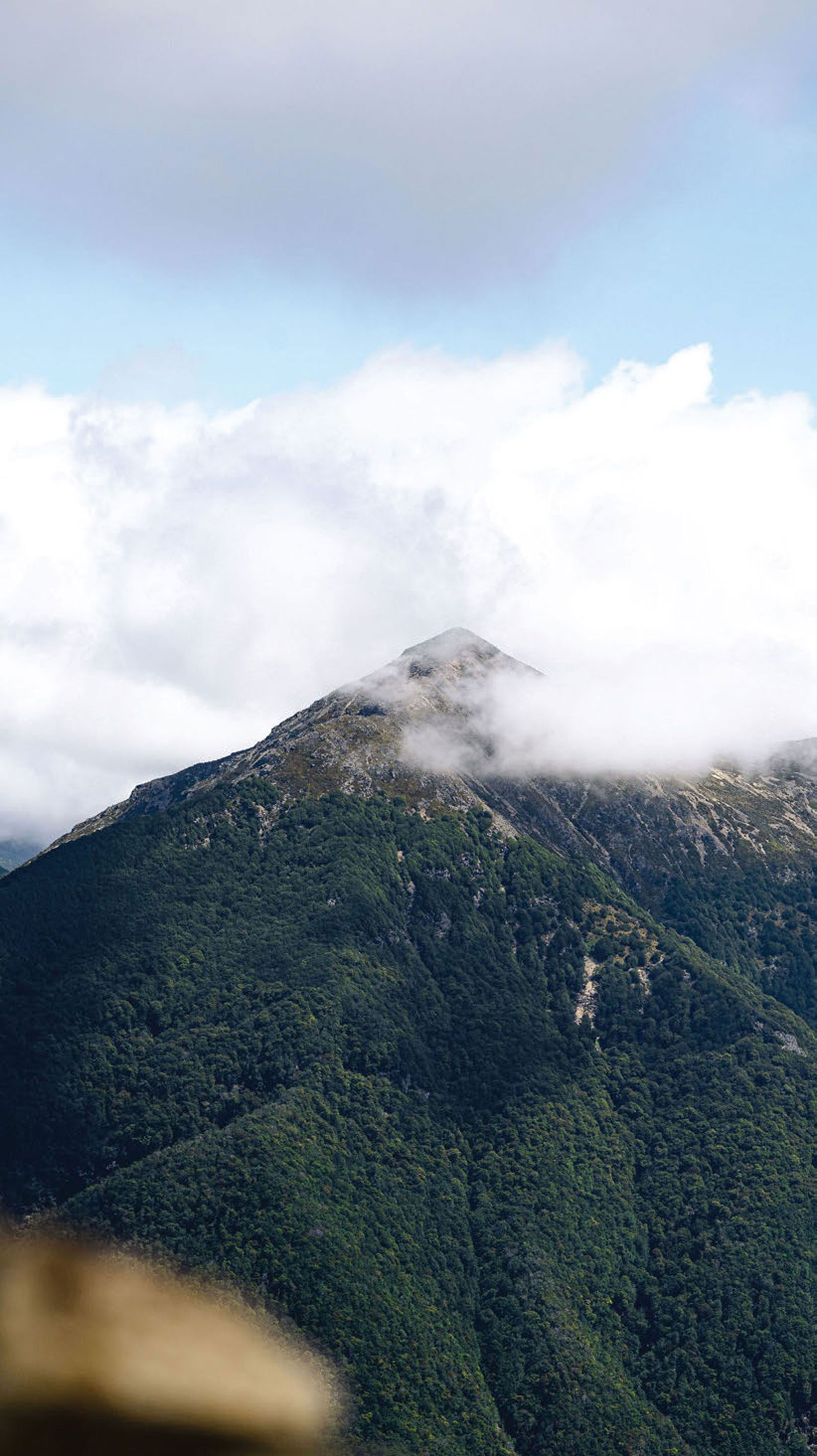

After a few more pints and an amazing dinner at the pub, the beer buzz of bad decisions kicked in, resulting in us getting a box to drink back at the hut that night. As it was starting to get dark, we hit the road back to the digs in good spirits. Back there, the box opened, and we continued into the night, with Bradshaw providing the entertainment again by unpacking and repacking everything as we watched him struggle. “What are you doing?!” we yelled, again.
The next morning, we were woken early to the sound of Bradshaw leaving. He was off early to ride to Nelson before a storm rolled in. The rest of us slept in a bit longer due to slight headaches from the beers. Today was going to be the easiest of the lot – we just had to get back to Picton before 6pm for the ferry back to Wellington. It was another overcast day with breaks of sun; not too hot, not too cold. Great weather to work our way back around Queen Charlotte Drive. My legs were feeling good this day for some reason; strong, powerful. I wished they had been like that over the last two days. It would have made life a lot easier. We stopped off in Havelock for breakfast and picked up some stuff for lunch. The pace was kept steady. We had all day to get to Picton. No big rush. It let us just enjoy the day and the ride. Really soak up the beauty of the place. We stopped at Ngakuta Bay for a swim in the sea, and lunch. The sun was out. The sea was the perfect temperature. Just tremendous.
The final 11km were stunning. One last climb before descending into Picton. I had Hybrid Minds playing in my earphones as we knocked off the last bit. The perfect soundtrack to the last bit of this adventure, speed tucking our way down the wavy road to Picton. The lush green canopy of trees and the views of the bays, mixed with the euphoria of completing this mission, made for a magical moment. What a time.
We stopped for a quick look at the viewpoint overlooking Picton before we rode down the road into town, grabbing the bag of clean clothes we had stashed two days earlier out of the bushes. We had done it. The Royale with Cheese ticked off. Another mission done, and it was yet another great one.
We had a couple of hours to kill before the ferry, so we got some second lunch, went for a swim in the sea again, then downed a few pints in one of the waterfront bars. We chatted about the mission we had just done; it wasn’t as hard as Ferry to Fishy, but it was a further distance. Breaking it into three days definitely made it a more pleasant experience. The ride around Queen Charlotte Drive was far nicer than the main highway to Fishtail. This time it seemed like the perfect amount of Type 2 fun (although you could argue that the more Type 2, the bigger the reward at the end). Royal was an absolute treat to ride, and getting to tick off some of the Wakamarina was a huge bonus. You couldn’t have asked for a better crew as well; just the best. We left the Capital on a Saturday morning, rode kilometres into the backcountry, rode a big mountain, rode back – and we were going to be back in the Capital by Monday evening. How good! Weekend adventures done right.
We boarded the ferry back to Wellington, found some good seats, and settled in. We hadn’t even made it out of the Sounds before we started talking about what was next. What’s going to be the next one we tick off? We have a few ideas in mind…. Watch this space.

Welcome to Scotland
Words & Images Jake Hood
“There’s no such thing as bad weather, just inappropriate clothing,” This is a common saying that’s thrown around in Scotland. Well, whoever said that is a flipping idiot, I thought to myself as the rain hammered down on us at the start of the men’s DH final in Fort William.
The rain drenched everything in sight, showing no mercy; not even my triple Gore-Tex 50,000 waterproof Montbell jacket stood a chance. Welcome to Scotland.
This year would see the inaugural edition of the UCI Cycling World Championship. Yes, there have been World Champs before, but this is slightly different. Instead of just select events being held in different places worldwide, it would all be condensed into one country over 11 days. There were 115 events and 101 para- events over 13 different disciplines. There would also be a medals table for the countries competing, like the Olympics and (also like the Olympics) it’s to be held every four years. The inaugural one was to be hosted by Scotland.
With a big break in the Enduro World Series between rounds, it seemed like no better time to head back to the motherland to watch some events. It had been four years since I was last there – four years too long. I’d almost forgotten that it rains a lot in Scotland, though I was quickly reminded during my eight week stay. I managed to only get three days without it raining, to some degree, throughout the day.
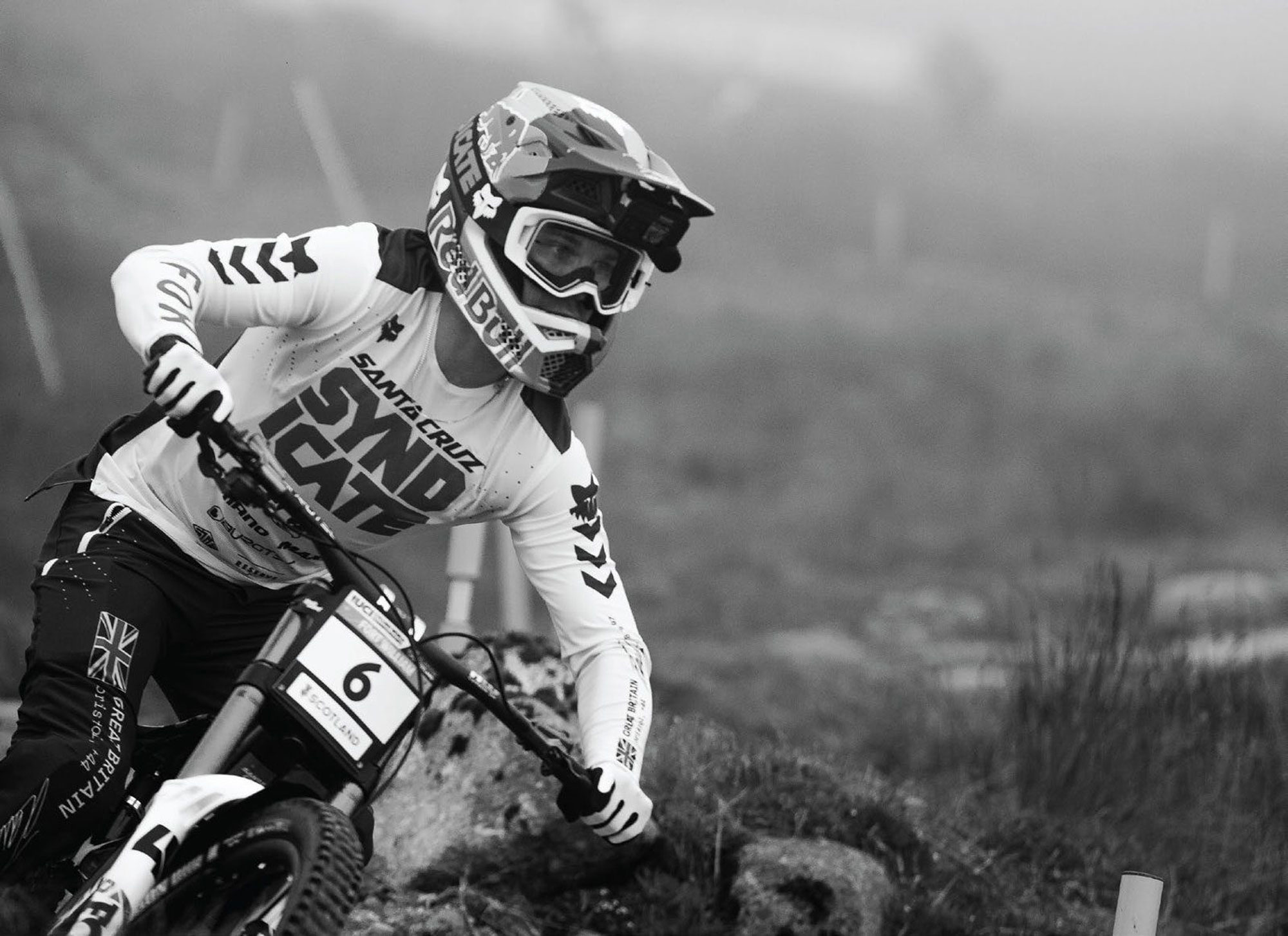
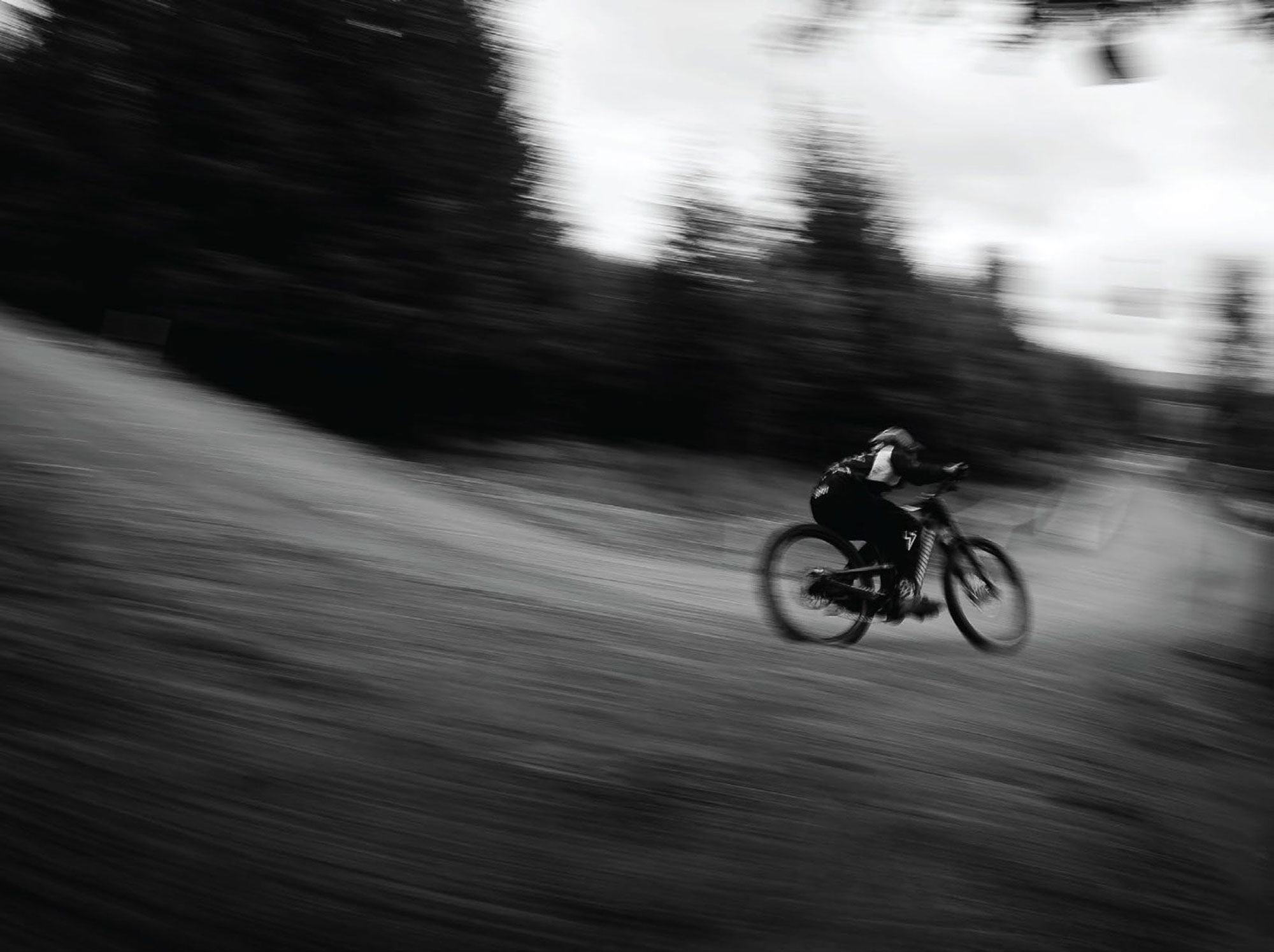
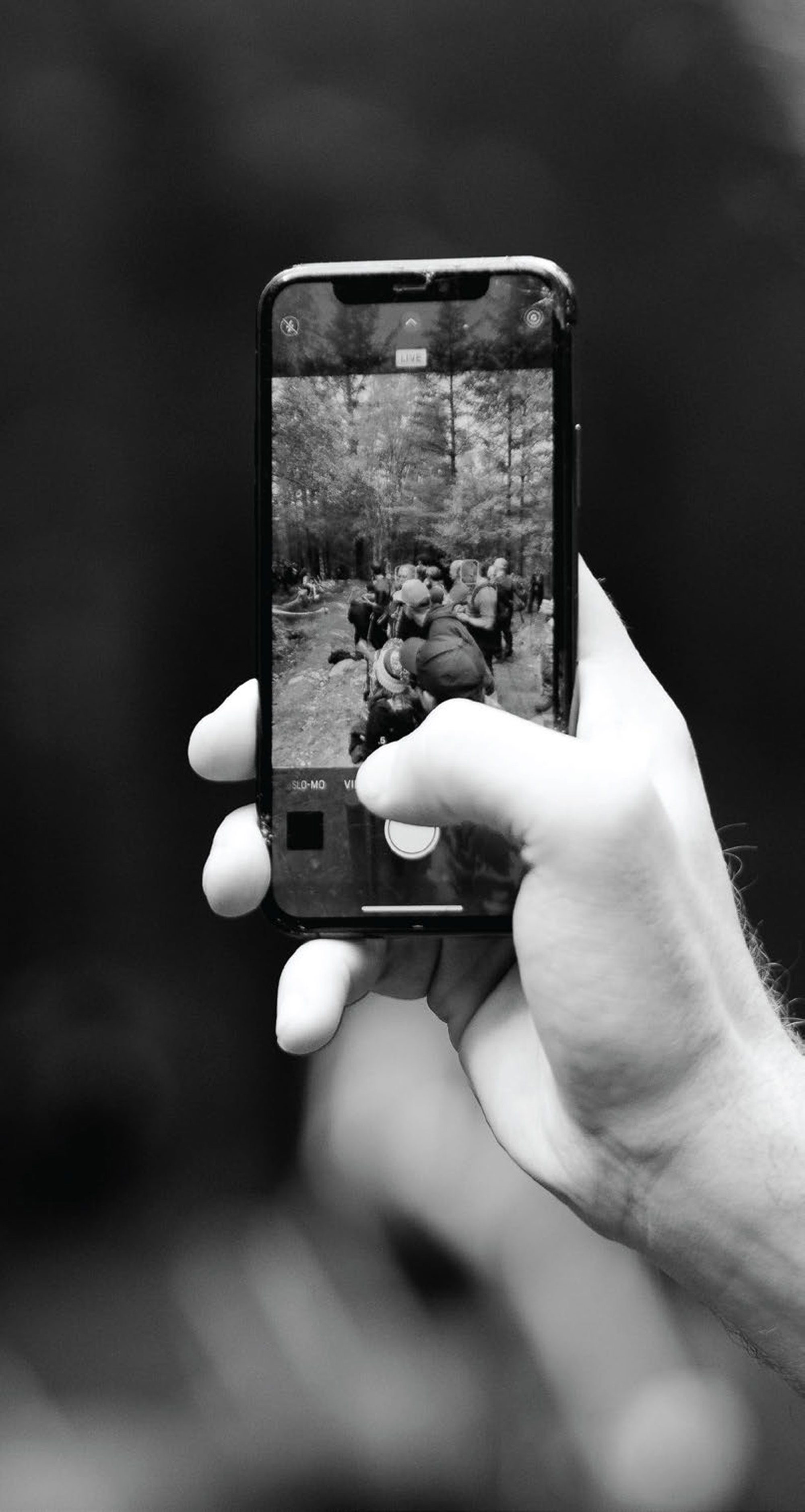
The downhill was going to be held at the world-famous Fort William track. It has been a staple on the circuit for years. My first experience of being at this place was the World Cup in 2005 as a young lad. It was a magical place. I was in awe of the pits, the riders, the bikes, and the track. The place was packed with people and, walking around the pits, I would stare at the bikes for hours, fascinated by them as well as the riders fly down the track at stupid speeds. It was incredible as a young lad. That year, Steve Peat won and I’ve never heard a sound like it when he flew across the Visit Scotland jump into the finish area. The crowd erupted in noise that built in a crescendo until he crossed the line and won. At that point, it was like an explosion of sound and emotions. It was defining. People cheering, banging things, blowing horns. I get goosebumps even just thinking about that moment. When people talk about being at Fort William WC, they often talk about that energy.
Fort William last held the Downhill and XC World Champs back in 2007. I was at that race as well and it was a wet, wild week. Sam Hill dominated the men’s field to take the win, and Sabrina Jonnier won the women’s, but it was Ruaridh Cunningham (the Scotsman) who stole the show by winning the junior males DH and giving Great Britain its first rainbow in downhill.
I forgot just how beautiful the drive up to Fort William is if you head via Glencoe. The rolling green hills and farmland of central Scotland gradually turn into dense woodland, sparse heather-covered mountain areas, and sparkling lochs. It’s a beautiful drive that is very popular with tourists. As you enter Glencoe, you are greeted by towering, almost vertical, mountainsides that enclose the road. The valley floor is lush and green, crisscrossed by streams and rivers. Waterfall’s cascade down the mountainsides, and the atmosphere is one of wild, untamed grandeur. It’s a landscape that exudes both awe and a sense of isolation, but it’s also a reminder that it’s rugged up here. You have to respect the landscape, or it will bite back. Admire it, but treat it well. A short time after you finish driving through the glen, you arrive in Fort William. Above the town towers Ben Nevis, the highest mountain in the UK. It’s sparse and covered in rock. From a distance, it doesn’t look like there are any signs of life on there and it serves as a reminder that you’re in the Highlands now.
KIWI JNR. WOMEN
SACHA EARNEST, ERICE VAN LEUVEN, POPPY LANE
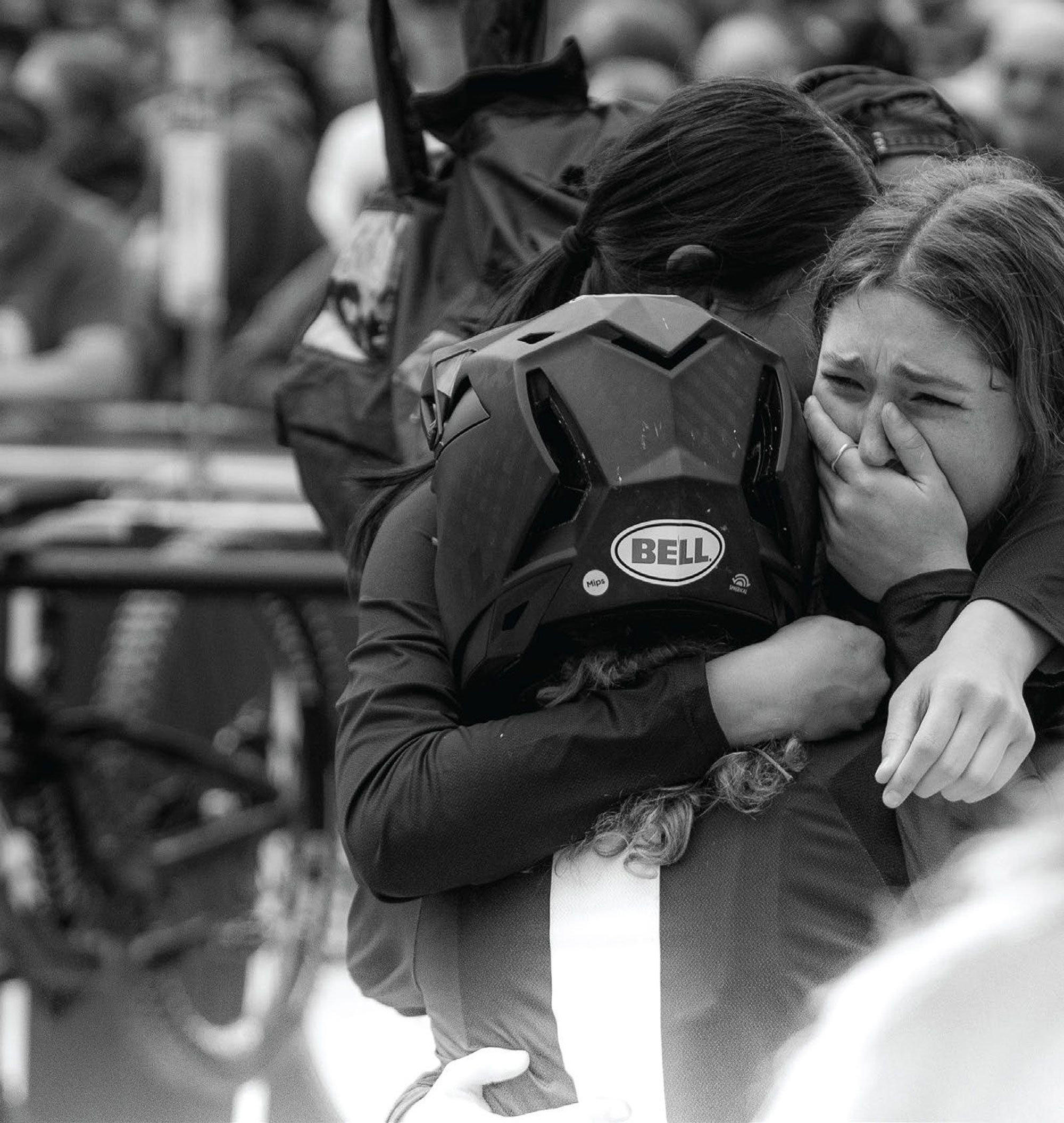
The respect you have to treat the outdoors with transfers to the downhill track on Aonach Mor. It sits three mountains over from Ben Nevis. It’s a historic track; rugged, hard and fast. A course of three parts, it’s 2.9km of bike-smashing, arm- pump-causing, leg-burning hell of a track that descends 547m. The top half weaves its way through the open moorland and its surface is made up of gravel, granite slabs, and rock. Rock graders litter the way down the track. It’s unbelievably rough. Spectating trackside, you often hear the sounds of rims being smashed into the super hard granite. You do not want to crash up here. During race day, spectators will walk down the track through the moor, trying to avoid the bogs and slipping in the peaty soil beneath their feet. I, for one, didn’t manage this and took a few tumbles. After the open section, you make it to the most technical part of the track, the woods. By this point, your arms and legs are burning. You’re struggling just to hold on, but you have to navigate your way through the twisty, wet, muddy, root-infested bit of track before holding as much speed as you can onto the motorway. You might not win the race in the wood, but you can certainly lose it. One mistake could cost you a lot of time. Finally, you make it to the motorway. A long run into a hip jump catapults you into the row of jumps that guide you to the finish area. It may seem like the simplest bit of track, but it’s proven to be a very crucial part of the race. Races have been won and lost here before. To finish off the track, you jump into the finish area before descending down the “wall” into the last jumps and drops of the track before you cross the finish line. It’s a savage track, unique to everything else that gets raced, one that always provides thrilling finals.
Though it is remote, people from all over the UK flock to this race. It’s incredible just how many of them make the trip. On race day, there’s a sea of people throughout the pits and up the hill on the track. Sometimes it’s hard to stroll through the pits because of the number of people. The UK fans really get into it; some dress up in crazy outfits, and some dress down. Occasionally, you get the odd streaker. The true spirit of the event, though, is the wild camp. Located not far from the event, a 20-minute walk maybe, a large farm field gets turned into a campground for the weekend, with a mix of tents, vans, and campervans. It has real festival vibes, and huge parties happen there that go on until the wee hours. People wake up hungover only to continue drinking to help get them ready to watch the racing of the day before continuing to get back on it for the rave that evening. It’s a non-stop party all weekend.
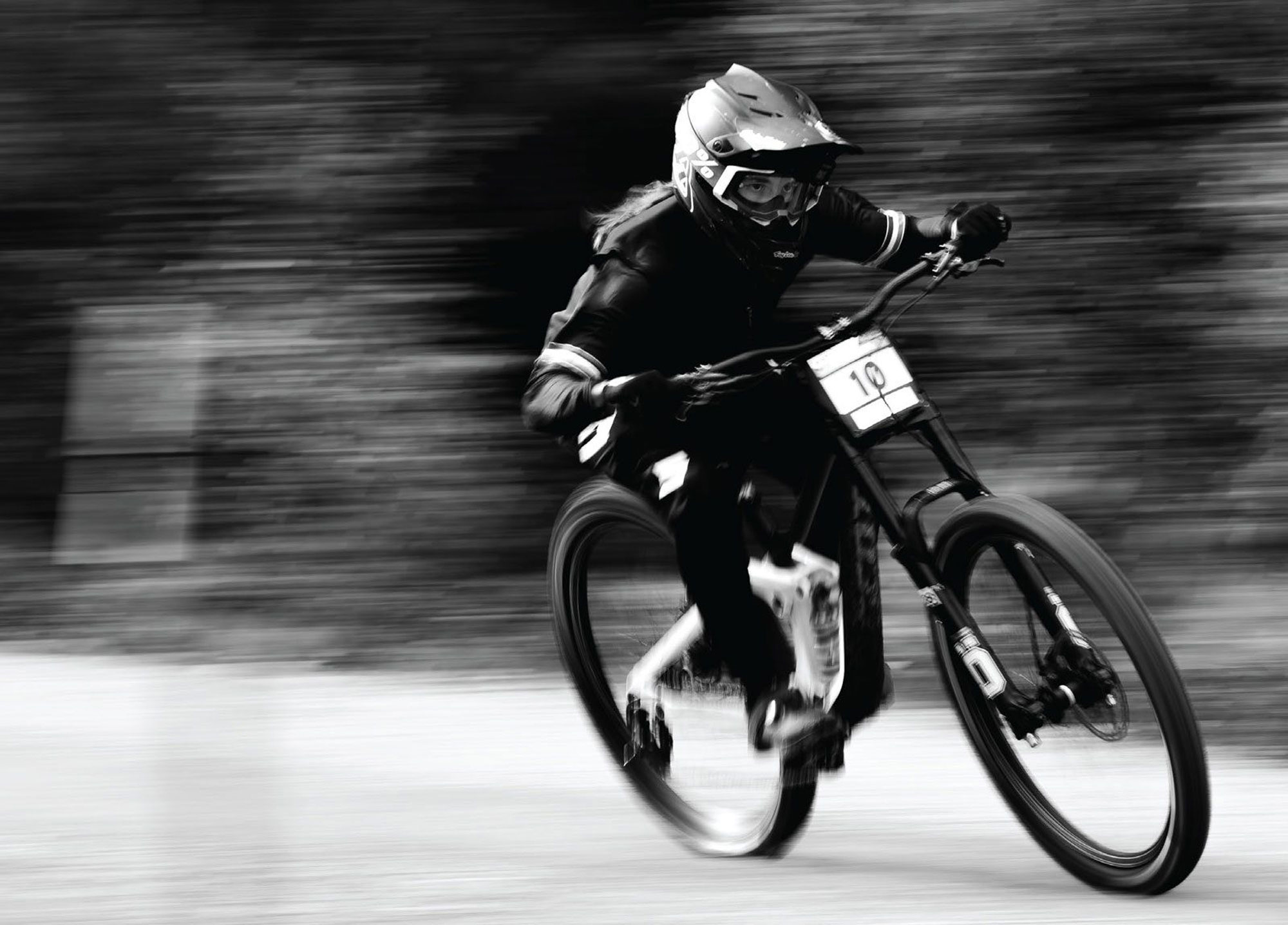
THE RAIN continued to lash down, SATURATING EVERYTHING IN SIGHT.
There are a couple of essentials you really need to pack if you decide to come and watch this race. First of all, bring your waterproofs. At the end of the day, we are in Scotland, a country synonymous with bad weather. It might be forecasted for sunny skies throughout the week, but this is the Highlands. The weather can turn on a dime. So be prepared and pack those waterproofs. The other essential, and I mean essential, is getting yourself some Smidge. What is Smidge, you might ask? Well, in Scotland, we have these little pests called midges, which are basically tiny flies that love to bite you. They truly are pests. They will swarm around you, biting you all over. No part of you is safe. If you’ve been to Scotland, chances are you will know how bad they can be. They suck, but Smidge is a spray-on repellent that keeps these little insects at bay. I’ve warned you. Don’t get caught out because you will know about it.
The weather was on and off throughout the week and played a pretty big factor in the race. It stayed good for the day of the juniors and qualifying races; what a day that was for NZ. Poppy Lane was one of the first to drop in the junior women’s category. She put down a blistering run that saw her comfortably in the lead and onto the hot seat. Junior woman after junior woman tried to beat that time but couldn’t. Poppy was in the hot seat for a long time, looking surprised every time a rider came down and didn’t better her time. Sasha Earnest laid down a great run and got close to Poppy’s time but ended up 0.417 seconds behind. Was anyone going to be able to deny the win for Poppy? There were two riders left at the top of the hill: the fastest qualifier, Erice Van Leuven, and fan favourite, Aimi Kenyon, from Scotland. Erice had been dominating this year in DH and Enduro and, at Fort William, it was no different. She blitzed the course and came down into the lead by 5.208 seconds. It was a huge lead. Both Poppy and Sasha ran over and hugged her with a NZ flag. Were we going to witness history being made? Aimi Kenyon came down. The crowd was roaring and cheering her on, but she was back at the top in the first two splits. Poppy and Sasha were hugging Erice tightly in the hot seat. They were all tearing up. As Aimi hit the jump into the finish area, Erice knew she had done it. Aimi crossed the line in fourth place. It was a New Zealand 1, 2, 3. The girls got up and celebrated. I think they were shocked at what had just happened. I was tearing up watching them hug each other in joy; it was an emotional moment. The crowd was going wild. What an incredible thing to witness. It’s fair to say that the future is bright for New Zealand in women’s downhill racing.
In the junior men’s race, Germany got their first DH world champion. Henri Kiefer took the win with Canadian, Bodhi Kuhn, taking second place, and Léo Abella of France rounding out the podium.
The following day was the main event: the DH finals. As I rode to the event with my brother, his partner and my niece, the weather was looking pretty great. A few clouds around but mostly sunny skies. It looked like it was set to be an epic day of racing. There were thousands of people flooding into the event. Fans were everywhere: in the pits, up the track, in the grandstand. The food court was packed with people drinking and eating. The slight breeze and warm weather kept the dreaded midges at bay. The pits and expo village were bustling with people trying to see and get up close to their favorite riders while they got prepared in the pits. There was an energy about the place. It was going to be a special day.
U23 UCI WORLD CHAMPION
SAMARA MAXWELL rode a truly dominating race
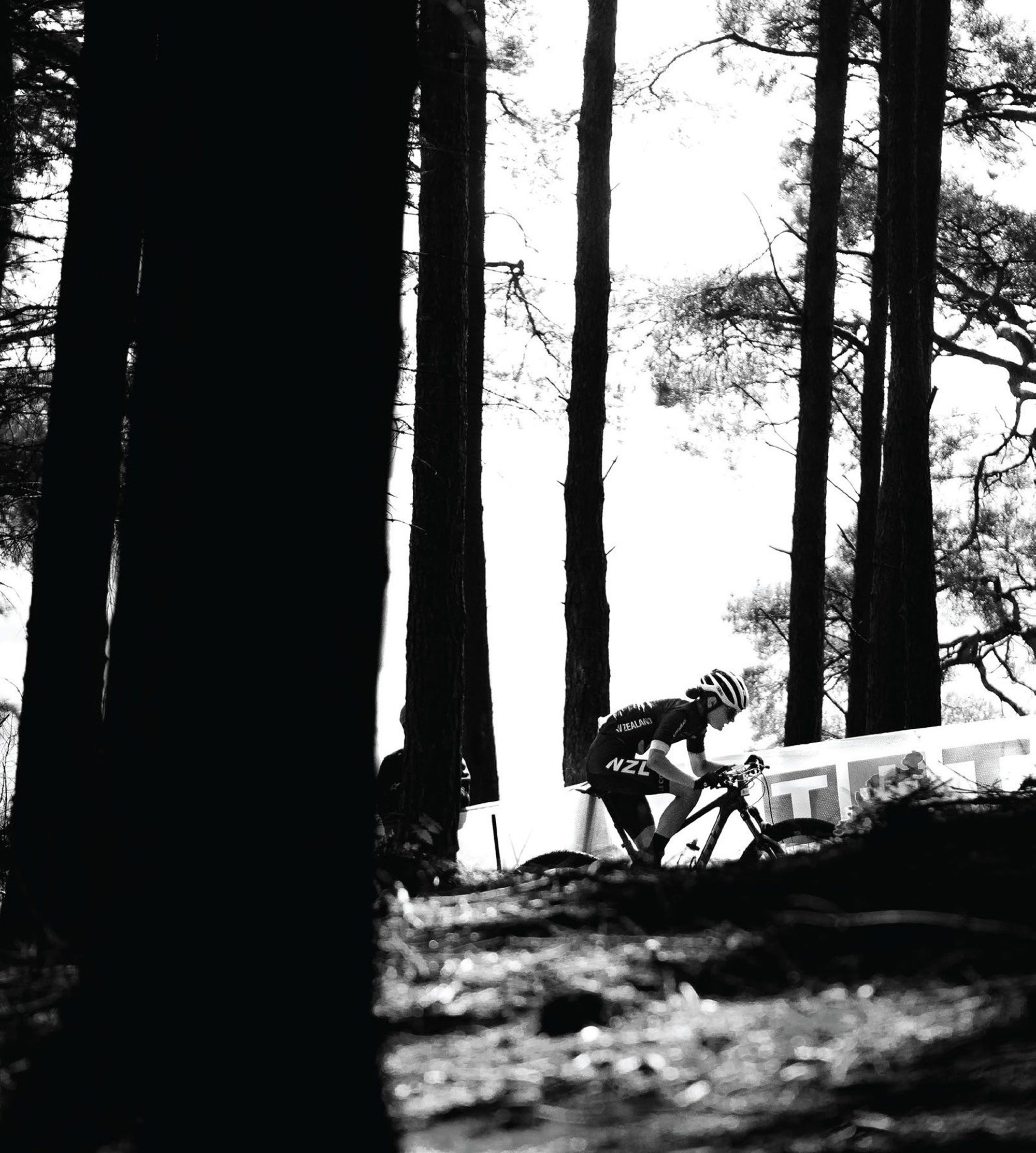
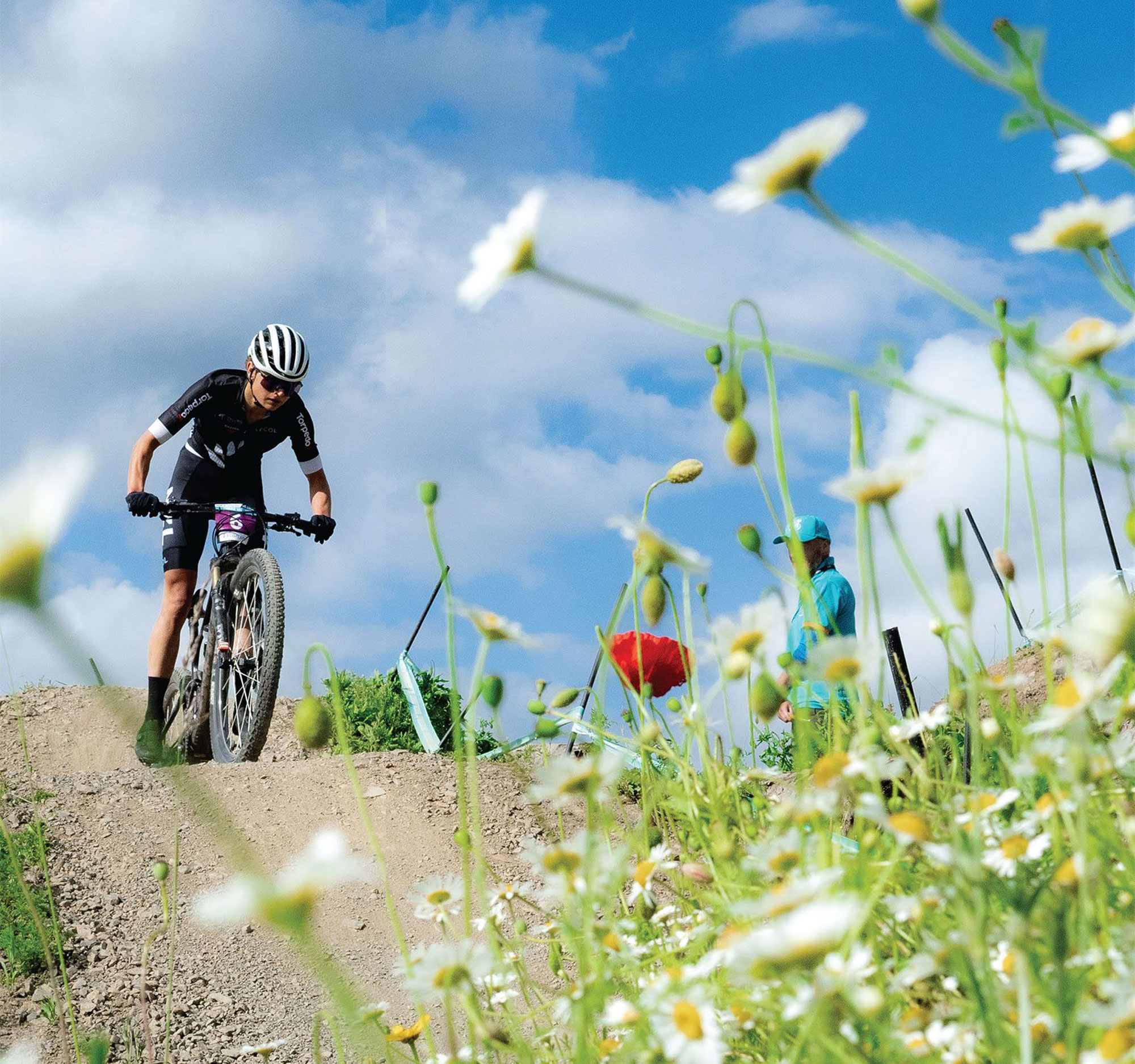
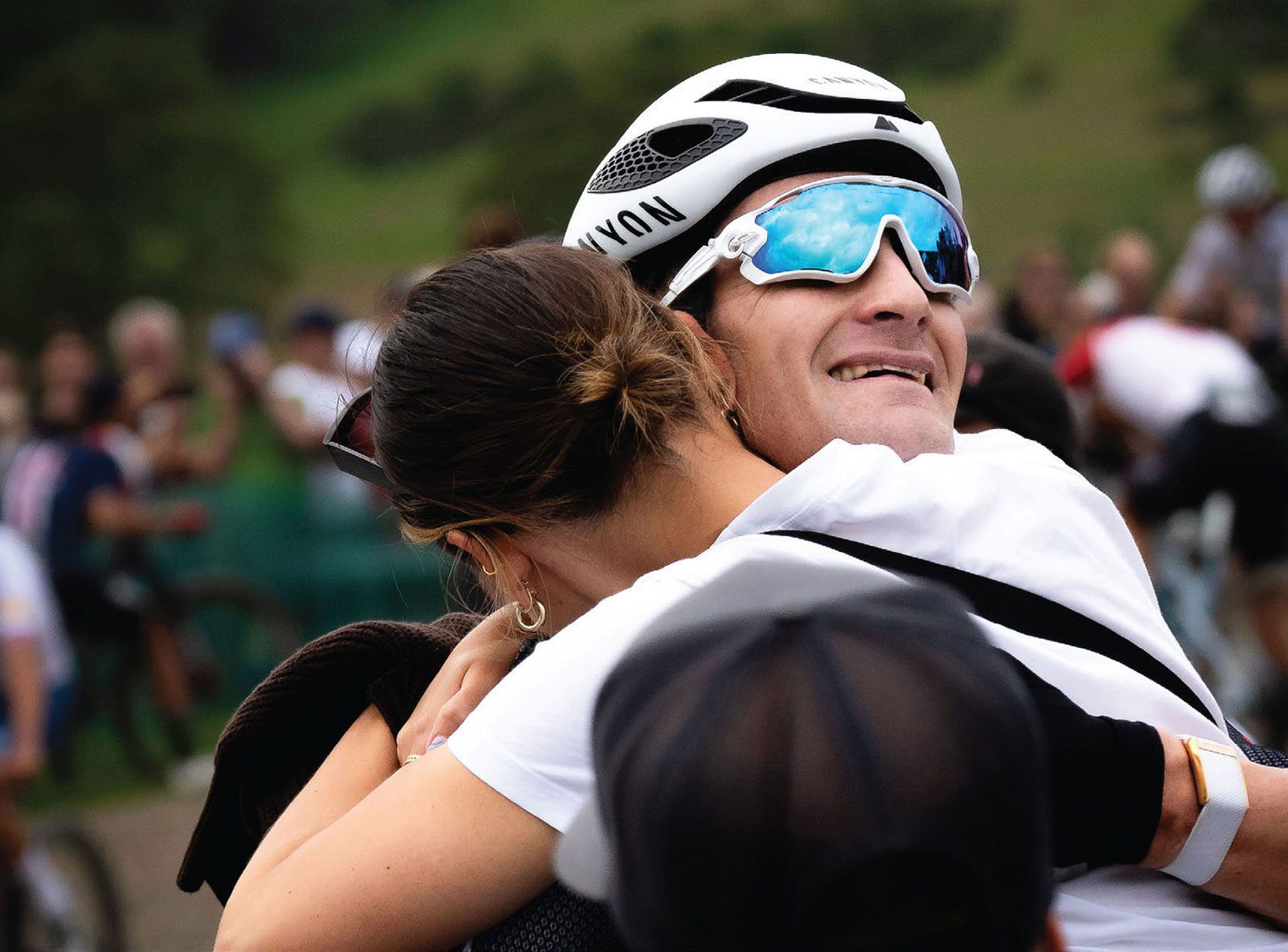
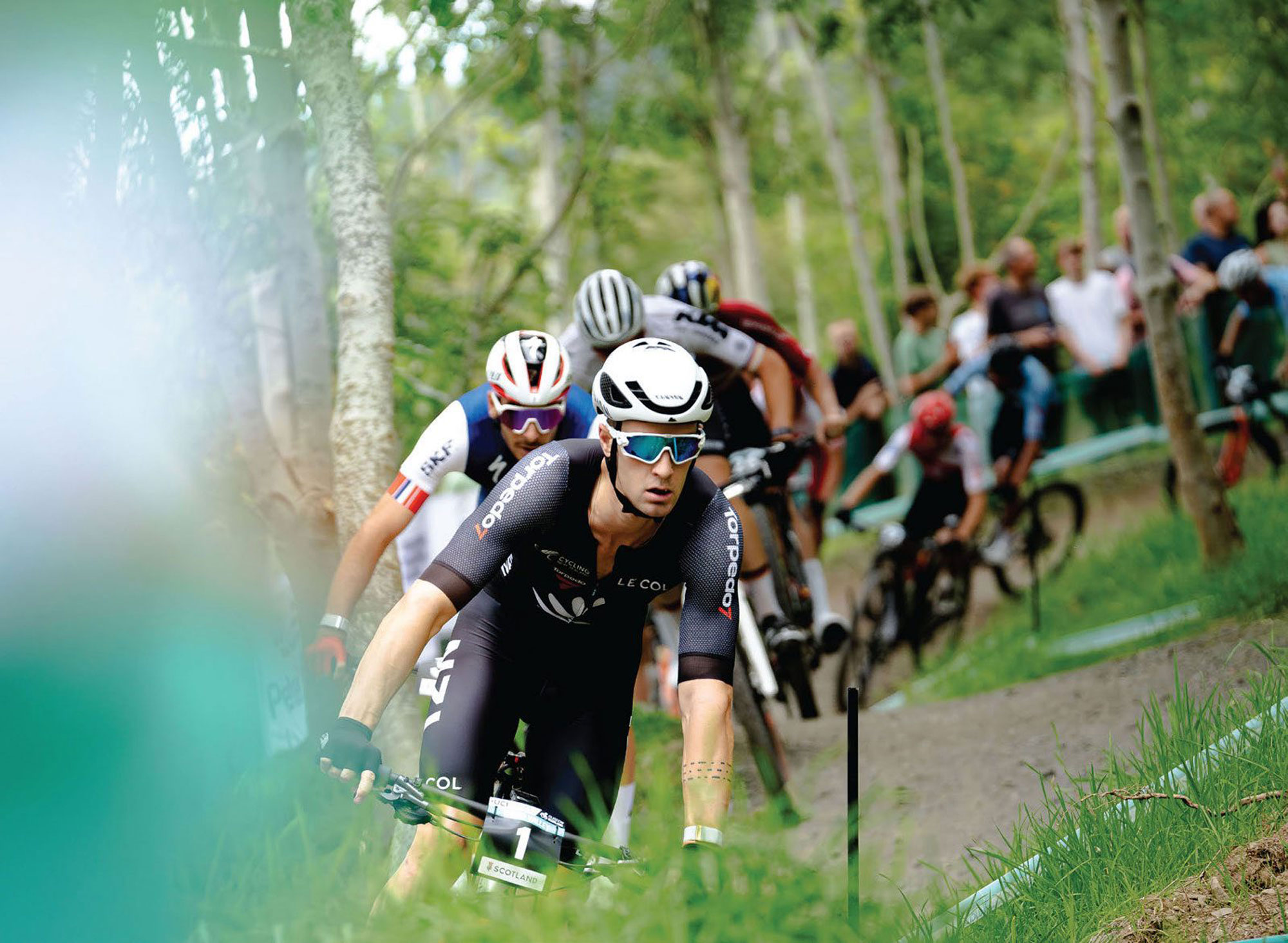
I managed to get there in time to catch a little bit of practice before the women’s event started. Emmy Lan was the first to drop, setting a time of 5m26.653s. From there, the times tumbled and tumbled. It seemed like every rider that came down was just going faster and faster. After the first 20 riders, Tahnee Seagrave was sitting on the hot seat. A pretty incredible feat after her huge crash into the barriers a couple of days before. Phoebe Gale came down to knock Tahnee off, only to then be knocked off by the local – and crowd favorite – Louise Ferguson. The cheer was huge when she crossed the line. People were stomping their feet in the grandstand, cowbells were shaking, and old bike parts were getting smashed together noisily. The MC was getting the crowd hyped up. The noise was biblical. It was a British 1-2-3 with 10 riders to go. A couple more riders came down, but it was still a British 1-2-3 until France’s Marine Cabirou came down and smashed the current leading time by 7.36s. That put a stop to the possibility of a British winner. Camille Balanche came down 0.341s faster. She was in the lead with two riders to go. Only Nina Hoffmann and Vali Höll could deny her a second rainbow jersey. Nina was up at the first split but behind at the second, but a crash in the berm just after the road gap would dash her chances of taking the win. Vali Höll was last to drop. She had been on form this year. She had seemed to have found her groove this year in elites after making some big mistakes in her first year. She was dominating the WC series for 2023 and did the same in Fort William, laying down a championship run. Making short work of the track and winning by 2.020 seconds. She was the only female to set a time under five minutes. Back-to-back World Champ wins for Vali; and I’m sure it won’t be the last for her. At the end of the women’s final, the weather was still holding out. It was hot; the sun was shining, and it looked like it was going to stay okay for the men’s race. As the first 30 men came down, it was holding, but the dark rain clouds were starting to show their ugly faces around the tops of the mountains. As the Scotsman, Greg Willison, was on his run, the heavens opened. Light at first before getting really heavy – I’m talking big- ass droplets of rain that soak everything. Greg came down to take the lead by 7.753 seconds. A few riders later, Angel Suarez came down just to pip Greg by 0.47s. It looked like Angel was going to be the last guy with a dryish track. I thought to myself: “This might be it; there’s no way someone is going to beat that time on a wet track. Is Angel going to win? Is it going to be one of those races that’s decided by the weather?”
The rain continued to lash down, saturating everything in sight. I got my waterproof jacket and pants on but it was so wet that, after five minutes, I was soaked through. From the grandstand, all you could see in the crowd was a sea of umbrellas. The track had completely changed. Riders were still putting down fast sections in the top, due to the fact it actually gets grippier in the wet but, from the woods down, it was a different story. Rider after rider came down, absolutely soaking wet and still pushing by the bottom, but no one was even remotely close. It looked like they were at war with the track, rather than racing it. I really thought the race was done… until Matt Walker came down. He was up at splits one and two and had made light work of the woods. It looked like he was going to be up coming into the motorway, until he had a huge crash. His front wheel slid off a metal bridge, and he drove himself into the ground. It was horrible to watch but, somehow, he got up and was okay. Maybe the dry times were beatable in the wet, but it would have to be a helluva run. Danny Hart came down and was looking good, but he lost around two seconds in the final split. Charlie Hatton was up next. I was hanging out with Innes Graham at the time, chatting with him about whether he thought Charlie might win the race. Innes had been working as a line coach for the GB team all week. “I reckon Charlie could be a good shout; he’s been looking so fast all week. Very consistent with his riding. It could be him,” he explained. Charlie set off out of the start gate. He was up at the first split. He was up at the second. He was riding amazingly. So smooth, fast, and controlled. There were no wobbles or bobbles. The third split was green as well. It was a master class in how to ride in the wet. He hit the motorway, and the split was green again. The crowd was going crazy. He was going to better the dry time. He jumped into the first arena and crossed the finish line. We had a new race leader! Charlie Hatton had mastered the wet conditions to take the hot seat by 2.464 seconds. The crowd went mental! There was so much noise. It was crazy! “I think that’s the winning run,” said Innes. Rider after rider came down, but no one could beat the time. Laurie Greenland came down and got closer than anyone so far, making it a British 1-2. The Austrian danger man, Andreas Kolb, set off out of the start hut. He was faster at the first split and faster at the second. He was up; on the run of his life. Was he going to topple Charlie? He came into the woods at a ridiculous speed but had a bit of a ‘moment’ and lost some time. At the third split, he was 1.5 seconds back. Not an unachievable amount to make up on the motorway, but it would be hard. At the fourth, he had made up a bit of time. He crossed the finish line; it was going to be close. There was a split second of silence, 0.599s back. Charlie had kept the lead. Andreas in second. There were three left at the top of the hill, any of them capable of winning. Troy was the first to drop of the three, but he was unable to better the time. Loic Bruni was next. His run was amazing, but it wasn’t enough and so it was fourth place for the Frenchman. Loris Vergier was the last man to leave the hut. He was behind on all the splits. As he hit the finish area, it was clear that he wouldn’t be able to better the time of Charlie. As Loris crossed the finish line, there was an almighty cheer. Charlie had done it. He’d ridden the run of his life – a true master class of a ride – like a true champion. He bettered everyone – in terrible conditions. It was a magical moment to witness. His family and friends jumped the barriers so they could hug him. What a way to finish off the DH weekend of World Champs! A British rider taking the top 1st and 3rd spots. A British-made bike in first and second. What a way to round out what might be the last ‘world’ level event at this epic race venue of Fort William (there are rumours going around that that was the last race at the venue).
THE NOISE WAS CRAZY
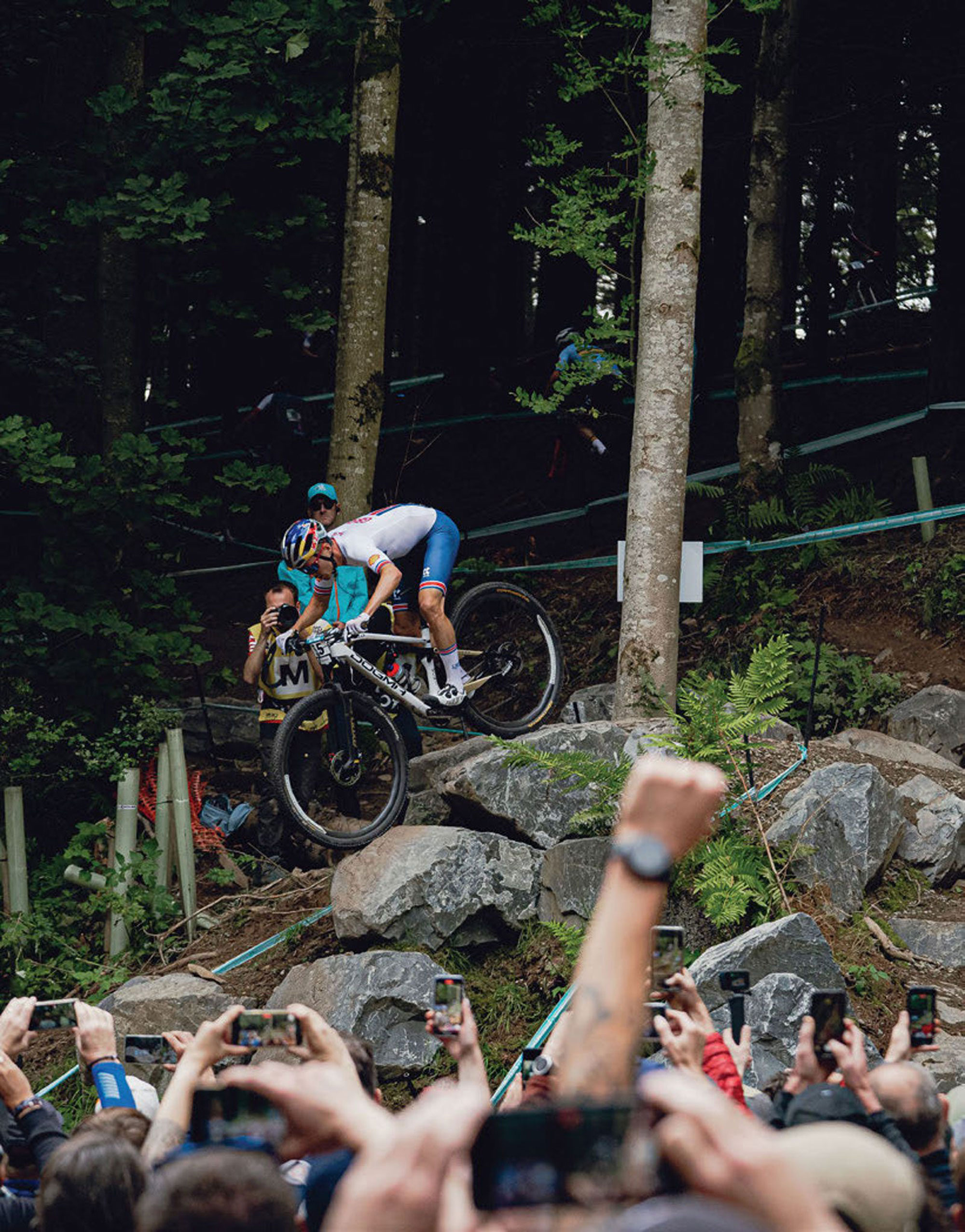
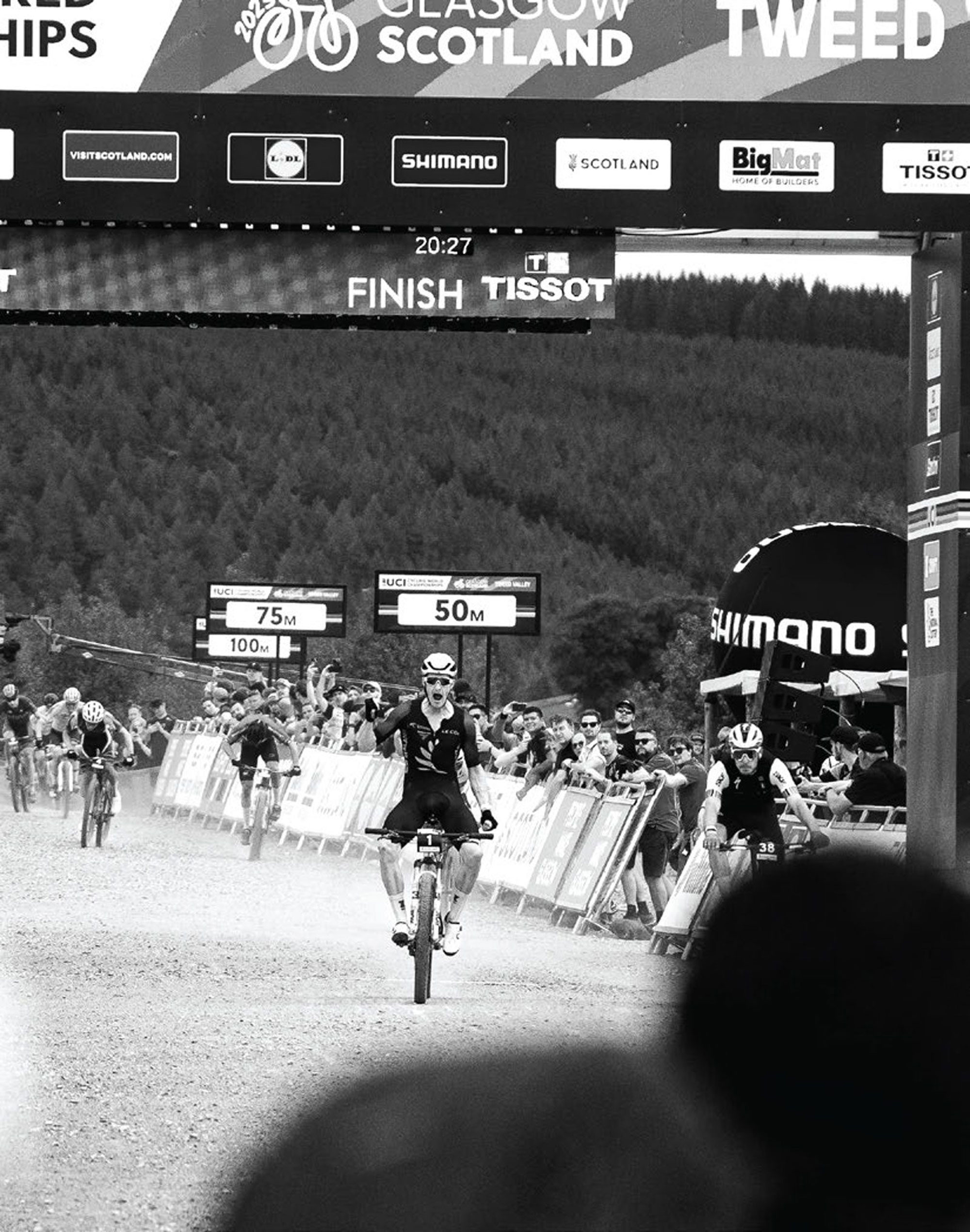
The following weekend, the XC World Champs were held in my hometown of Peebles. Well, specifically, Glentress Forest, about 3km from Peebles. I pretty much grew up in this forest. I rode there every weekend as a kid. I worked in the bike shop at the bottom of the hill for years. Many, many years of my life had been spent there, and now the World Champs were going to be raced here. Crazy. There had been some Enduro World Series events raced here in the past, but I never thought in my lifetime I would see World Champs being raced here. It made me proud to be from there and to have grown up in this small part of the world.
Peebles had really gotten behind the event as well. Bunting was hung up all along the high street. The local businesses had lots of bikes and World Championship-themed displays in their windows. The local butcher had made a special pie for the event. There was a buzz and energy around this normally sleepy, unassuming town. Throughout the week, you would see XC race bikes parked outside the cafes and coffee shops.
The event organisers had built a special one-off course just for this race. It was a really well- thought-out course that would make for some exciting racing. It used a mix of old walking tracks and fire roads for steep, pinchy climbs. Existing bike trails were used, mixed in with some freshly cut technical descents and climbs. There were a couple of gap jumps, with the man-made rock roll, The Salmon Ladder, a crowd favorite. It was quite technical and impressive to see being ridden with the seat up. The rest of the course used the new development of bike trails that had been built at the bottom of the hill. It mixed and linked different trails together. A great way to showcase this yet-to-be-open part of the hill. It was a course that had a bit of everything, keeping the riders on their toes and producing some exciting racing.
The first big event of the week was the short track. It’s basically a 20-ish minute all-out sprint on a shortened version of the XC course. I’d been to a few of these over the summer, at the World Cup events, and I have to say it makes for one of the most exciting events to watch.
The men were up first. Straight off the line, it was an all-out war as the riders battled each other to try take the lead and gain control going into the descent. Luca Schwarzbauer powered his way through and was in the lead into the descent. The fans were out in force, hanging over the barriers and cheering at the riders. There were a lot of lead changes over the laps. The crowd favorite, Tom Pidcock, had been working his way through the field after starting a few rows back. Sam Gaze had been hovering around the front, just waiting to make his move. Lap after lap went by. No one was really making any attacks. Watching them go by, I could not believe how fast they were going. The speed they rode the descent at was so impressive and, when they hit the start-finish straight, they got even faster; warp speed. I didn’t know you could go that fast on the flat. On the last lap, Gaze made his attack. He went on the climb, and no one could match his pace. He just kept pulling and pulling, almost like he had an extra gear. Tom Pidcock made a move as well, up to 4th before making a huge dive up the side of Luca Schwarzbauer on the last turn. Gaze held the lead across the line and took the win. Victor Koretzky in second. Tom Pidcock in third. It was a huge moment for Gaze and another Rainbow Jersey for NZ. Tears of joy, and a huge smile, were present on the normally emotionless face of Gaze as he hugged his partner. What a race that was.
Up next was the women’s short track. To say that Evie Richards was the people’s favorite would be an understatement. Throughout the practice laps, everyone was shouting “GO EVIE!” as she rode past. She was definitely getting the biggest cheers of the event, and it was understandable. The UK fans adored her. If you can say one thing about the UK fan, it’s that they are super patriotic.
The race had an explosive start. Just like the men’s, it was a race to be first into the descent to try to control the race. Italy’s Marina Berta led up the first climb. The big names were in close pursuit: Pauline Ferrand Prevot, Evie Richards, Puck Pieterse, Rebecca Henderson. There was a breakaway group of six riders, and that was where the race was really happening. Lap after lap, the lead rider of the group would change. By the halfway mark, it was anyone’s to play for, but one rider was playing it smarter than the rest. Prevot didn’t seem to want to take the lead, just sit in the pack, save energy, and wait for her moment. By lap seven, a few of the chasing pack had caught the leading group. Lap nine saw the first real attack of the race. Evie set off on her bid for the win. You could see in her eyes how much she wanted this. She went off. Prevot and Puck Pieterse chased. They broke away. Into the final lap, Evie was leading. The crowd was going mental. Was she going to do it? As they hit the climb, the patient Prevot made her move. She went, Puck tried, but she couldn’t match the pace – Prevot was in a league of her own. She went on to take the win. Puck would take second, and Richards would take third. Another super exciting race.
The following day would be another great day for New Zealand. Samara Maxwell rode a truly dominating race to take the win in the U23. She led from start to finish. No one was even close to her. She was truly in a league of her own in this race. It was an incredible performance to witness. Another gold for NZ.
Saturday was the big day: the Elite XCO; the final mountain bike event of the World Championships. Thousands and thousands of people descended upon Glentress to watch the show. The cycleway from Peebles to the event was so unbelievably busy with spectators riding to the event, and it was so cool to see. Fans lined the track with flags flying, vuvuzelas blowing, cowbells ringing. Places like the Salmon Ladder were completely packed, with maybe two or three hundred people in a tiny area, all watching their favourite riders tackle the technical section. The sun was out at the event but there were dark clouds lurking around, making for a moody atmosphere. It was shaping up to be one heck of an event.
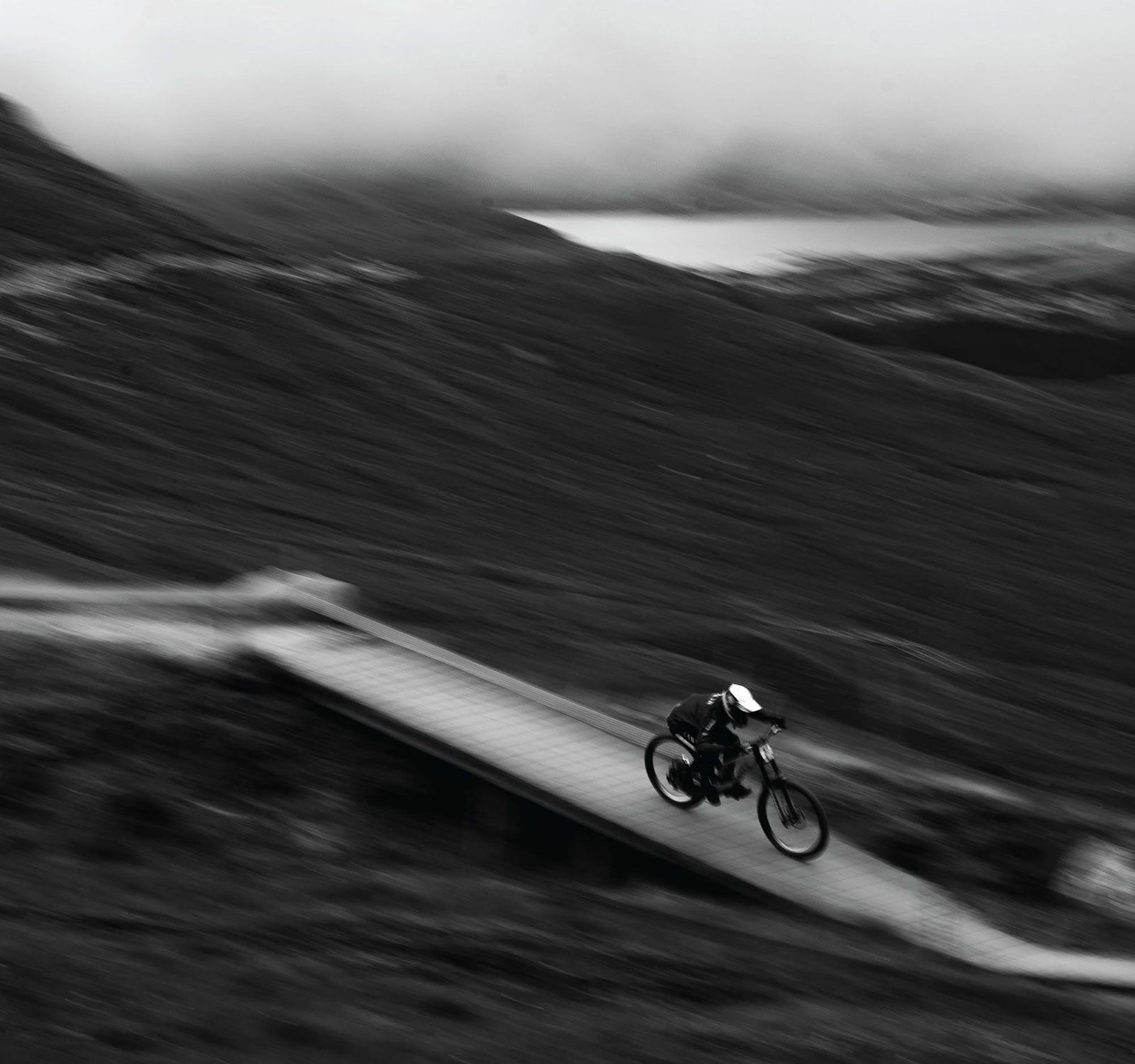
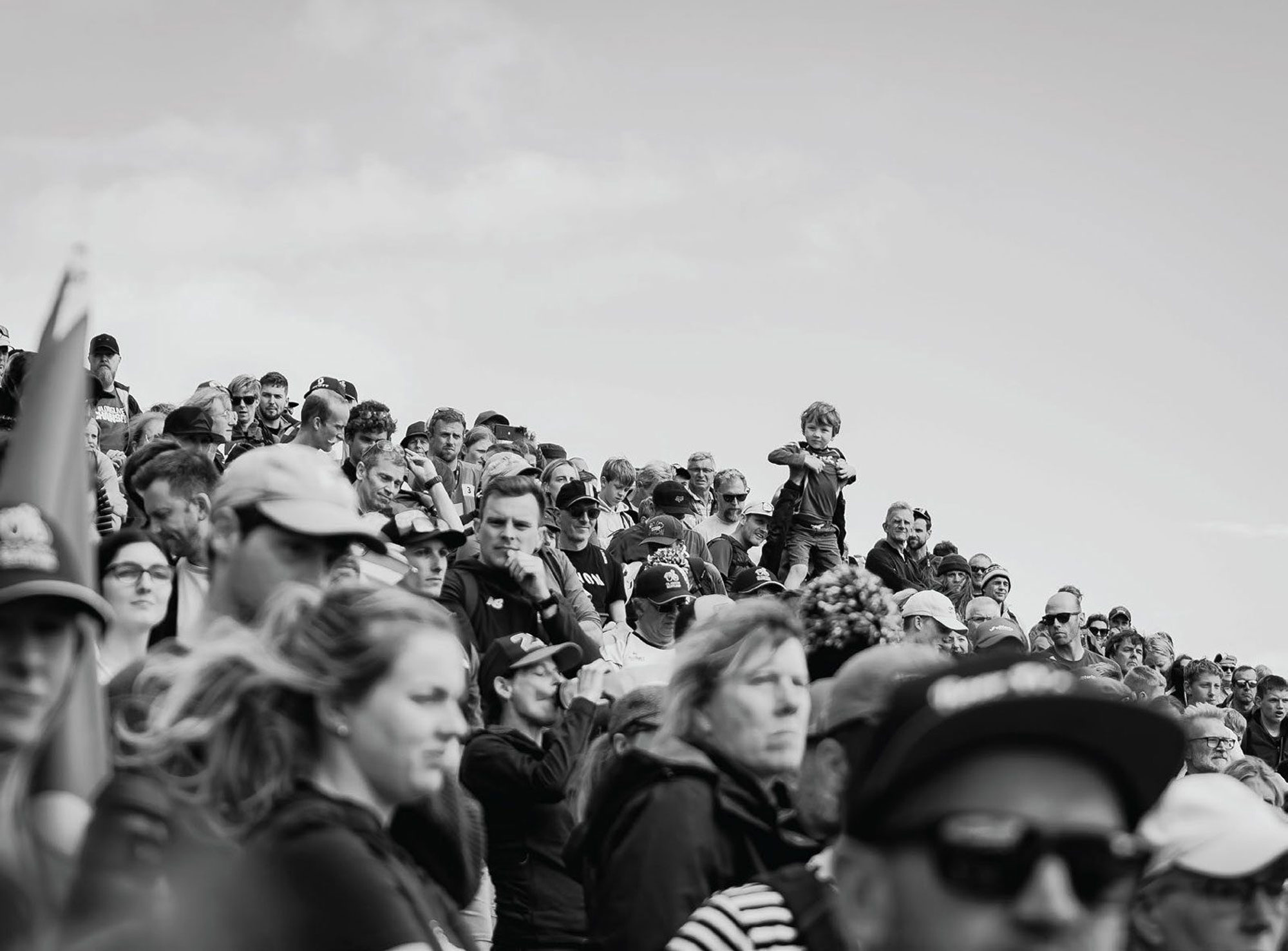
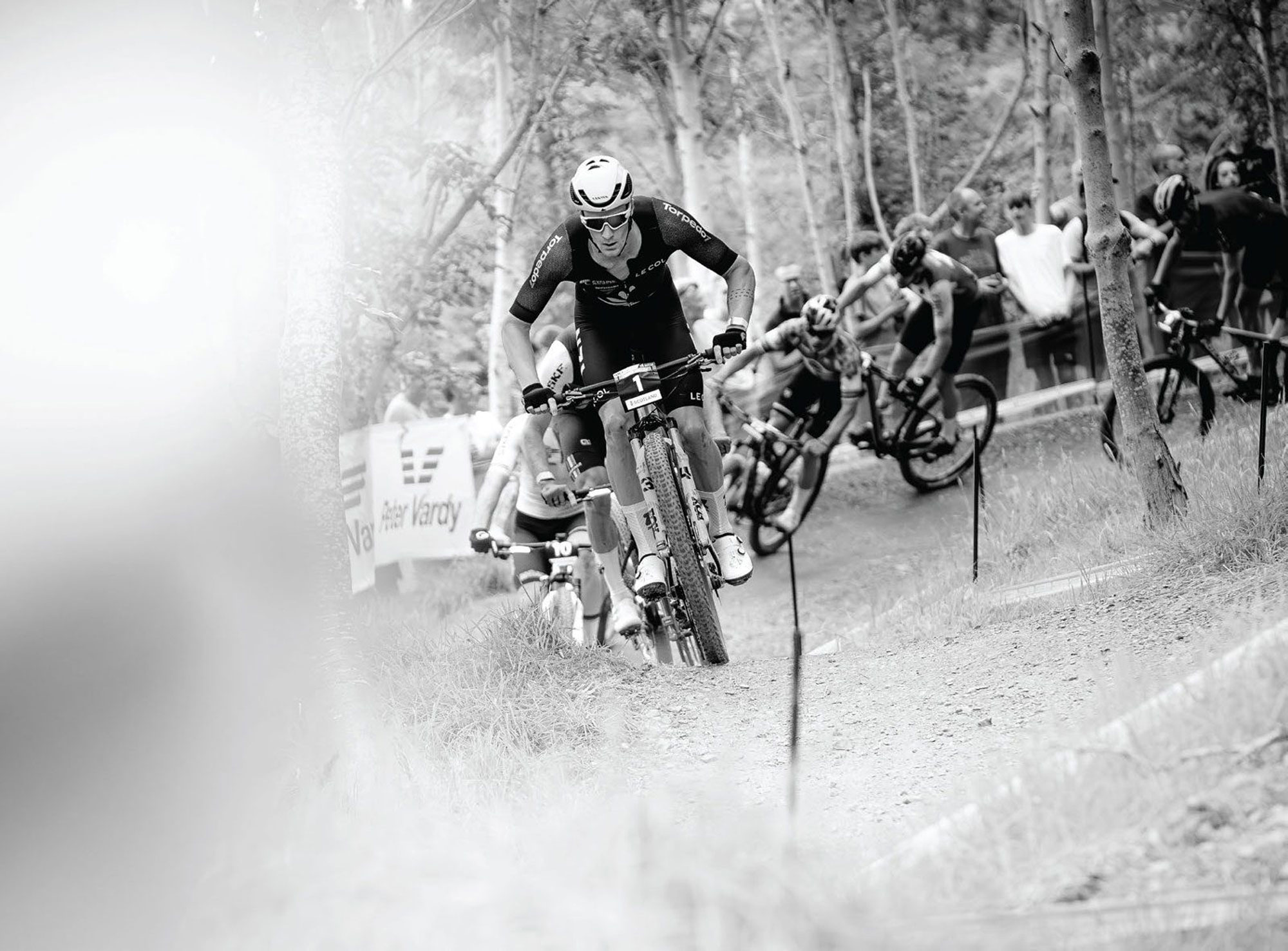
2023 UCI MTB WORLD CHAMPS
Scotland, you did well.
The women were up first. Seven laps plus one start lap, making up 26km in total. How was it going to play out? Off the start, Puck Pieterse and Loana Lecomte made an early attack to get out front and take the lead into the first main climb of the lap. The short track champion, Pauline Ferrand Prevot, had a bit of a tough start, resulting in her trailing 16 seconds off the pace going into the first descent. The fan favourite, Eve Richards, was in the mix, a couple of seconds back. You could tell how much this race meant to her, just by watching her facial expressions. She was giving it her all but, alas, it wasn’t her day. Loana Lecomte put the hammer down on the descent to put a good gap between her and Puck. Prevot wasn’t going to let them get away, though; she set off in pursuit of Lecomte. After the first lap, Prevot had narrowed the gap from 16 to five seconds. She was on a mission. By the end of the first big climb on the second lap, she had passed Lecomte and was riding off in formidable fashion. She didn’t even look like she was trying; in a class of her own. It was her race. She went on to put on an absolute master class, taking her second set of rainbow stripes of the week. Lecomte would go on to take second, while Puck came in third. The final event was the men’s XCO. The riders lined up on the start line. Big names were getting announced by the MC. It wasn’t just big names from XC lining up, though. Peter Sagan was racing. Mathieu Van Der Poel was looking to do the triple after having won the rainbow stripes in road the week before, and cyclocross earlier in the year. Tom Pidcock and Sam Gaze were placed a few rows back. Eight laps plus one start lap – a total of 29km of racing lay ahead. It was an explosive start; straight off, people were sprinting to fight for position. Disaster struck for Van der Poel, though, as he washed the front on the turn into the start-finish line on the first lap. He was out. As the riders hit the first main climb, it was Jordan Sarrou out in front leading, with Nino Schurter close behind. Nino laid down the law on the descent and took the lead after the first lap, with Sarrou, Pierre de Froidmont and Alan Hatherly all within a second of him. Alan Hatherly made an attack and took the lead, putting himself in front, but where was Pidcock? He was making up places after his mid-pack start. He’d made it up to 11th and was on the move. Hatherly, Sarrou, and Schurter were starting to pull away from the main pack. At the end of the second lap, Pidcock had moved up to 5th, only four seconds off the leading pack. The crowd was going crazy watching what Pidcock was doing. It was a superhuman performance. Schurter and Hatherly put down the hammer, trying to put some time between them and Pidcock. Sarrou was dropped -he couldn’t handle the pace. Pidcock moved up to third, but it wasn’t long until he caught Schurter and Hatherly. The noise as he joined the leading crew was crazy; a massive cheer could be heard throughout the forest. Pidcock was pushing them, but only Nino could match the pace as Hatherly started to fall back. It was a two-way battle for the win, with three laps to go. Something was happening behind. The quiet Kiwi, Sam Gaze, had turned on the afterburners and was working his way through the pack like a man possessed – passing riders like they were standing still. It was crazy, the amount of time he was making up. With just two laps to go, he was up to fourth. Pidcock had taken the lead and was riding his own race. He was just in a different league on this day; no-one was even close. He would go on to win the race in dominating fashion. But the really exciting person to watch in the last two laps was Gaze. He passed Hatherly to put him in third, and was catching Nino. Could he do it? Come from mid-pack and get the silver? Near the end of the seventh lap, he passed Schurter. As they entered the final lap, Schurter tried to hold back Gaze but, alas, it was too late. Gaze powered off, leaving Schurter hurting. Gaze was riding so fast that he managed to claw back 12 seconds off the lead that Pidcock had in that final lap. He had put in a heroic effort to take the silver. Schurter would go on to take bronze. A huge crowd had gathered at the finish line to see Pidcock cross the line and take the rainbow stripes. Boards were getting banged, cowbells were ringing, and cheers were shouted. What a way to finish. He rode an incredible race, coming from mid- pack to take first by a big margin. Amazing! After the medals and jerseys had been presented, Tom travelled through the crowd, up onto the grandstand. He stood there with the rainbow stripes, gold medal, and a British flag around his back. It was a magical moment to witness. The crowd was going crazy. A true champion.
In the end, Britain took the top spot on the medal table at the Inaugural World Championships, with 56 medals. New Zealand took eighth spot, just behind Switzerland. Not bad for a country of 5.1 million people. Best of all, NZ beat Australia by a long way.
World Champs have always delivered a whirlwind of emotions, crazy stories and great racing – and this year was no different. Scotland put on a heck of a show. The crowds were crazy. The racing was fantastic. These had been races to remember and I’m glad I was back to witness them in person. Scotland, you did well.

Legend of the Mammoth est. 2013
Words Lester Perry
Images Cameron Mackenzie
In recent years, Nelson has boasted the highest number of sunshine hours in a calendar year. It duked it out for the title with the Taranaki region in 2022, but lost out to not only them but to the Bay of Plenty, too. If second place is the first loser, what’s third place?
Sure, it’s still a podium finish but not necessarily something to write headlines about. Nelson’s ‘sunshine-hours’ crown is gone for now, but residents can rest easy that they have plenty of other accolades to sing about. It’s not just the big yellow orb in the sky bringing visitors to the area and, while the overall vibe and culture could be compared to that of Taranaki, there’s one major feather in Nelson’s cap that the ‘Naki can’t come close to: mountain bike trails. We’re not talking about the “mountain biking” your uncle and aunty do on the weekends aboard their folding e-bikes (although they have that too), it’s Nelson’s intermediate and advanced trails that bring those in the know to the hills behind the sunny town.
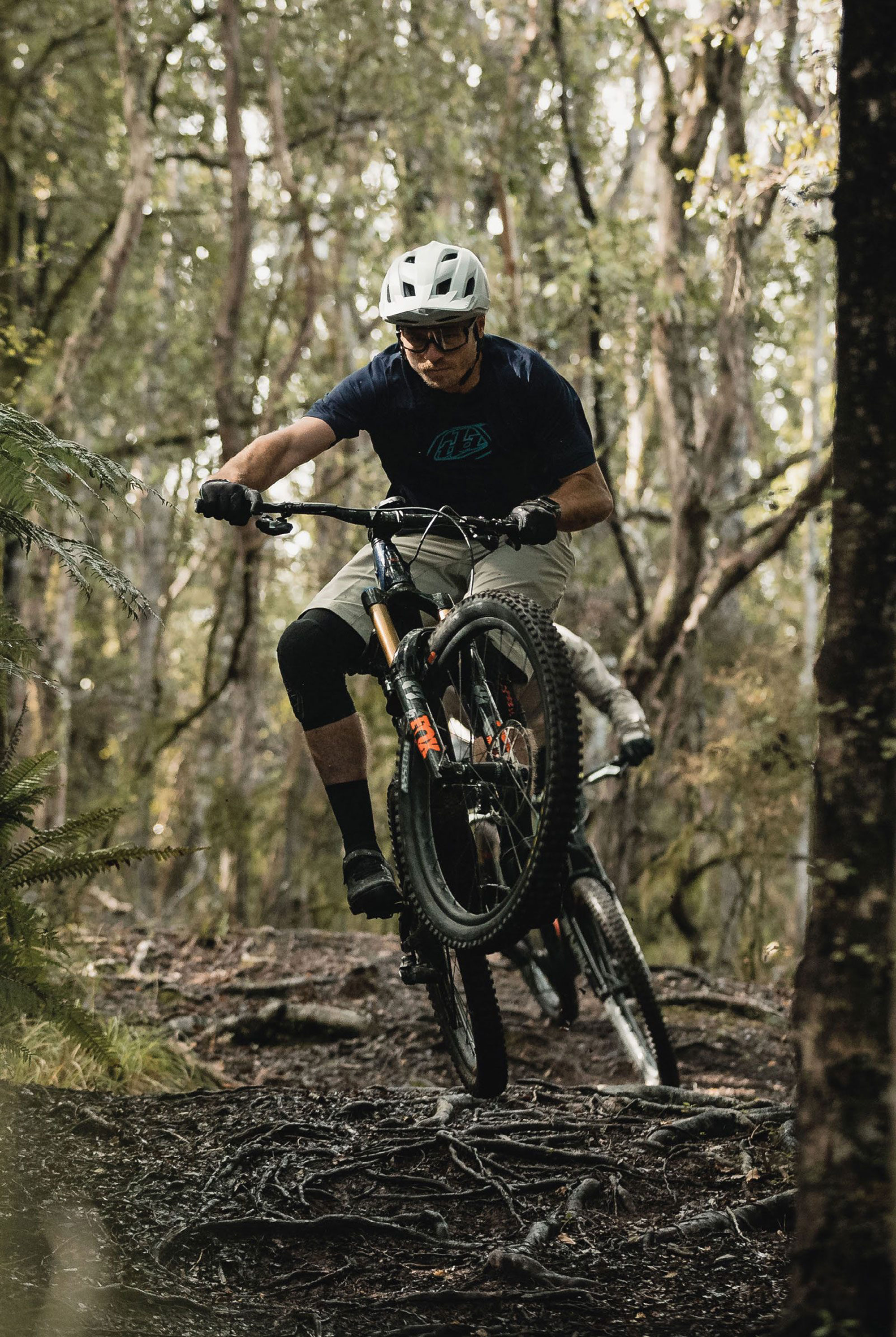

TOTAL DISTANCE: 58KM 2017
“THE MAMMOTH EVENT HAS BEEN A FIXTURE IN ONE FORM OR ANOTHER ON THE NMTBC CALENDAR SINCE THE EARLY 1990’S WHEN THE EVENT WAS A LARGE 40 - 50KM CROSS-COUNTRY LOOP; THE COURSE KEPT SECRET UNTIL REGISTRATION ON THE RACE MORNING.”
Arriving in Nelson, the relief of seeing our bikes being unloaded from the tin bird was short-lived, and shattered by the wide-eyed, confused look on our shuttle driver’s face, giving us a glimpse into what was about to unfold. Unfortunately, after some miscommunication and a major mix-up we were sent a small taxi to transport our three bikes (there were two of us) and an additional seven large bags (don’t ask) to our accommodation in town. With no taxi vans available in the area, we were left with two options -either load all the gear into multiple small taxis or rent an over-the-top expensive van for the short trip to town. Ordinarily, we wouldn’t need a vehicle in Nelson as, if you’re staying in town, the trails are just a pedal away and within a 15 minute walk you can get to anywhere worth going. So, renting was off the cards. Fortunately for us, a keen airport employee saw our plight and let us in on a hot tip: a public bus would roll in at any minute, it would likely be empty, and for the gargantuan fare of just $3 each we could be dropped to a stop just beside our destination. Sure enough, right on cue, the city bus service came to our rescue in one of their fancy new electric buses and left us with enough money in the coffers to sample some of Nelson’s finest hops later in the day. With a date for the Mammoth Enduro penned in the calendar for 23 -24 March 2024, and a few days free in early spring, it was the perfect excuse to head south on a quick trip to experience some of Nelson’s finest. We weren’t strictly hunting for time on the trails, but for a bit of chilled downtime while not on the bikes too. Chasing some local knowledge, we hooked up to ride with Nelson local and winner of the 2016 Mammoth, Kieran Bennett, and local fast-lady and Santa Cruz NZ representative, Amanda Pearce, as well as total frother, Tayla Carson, Nelson MTB Club’s (NMTBC) event portfolio head.
The Mammoth event has been a fixture in one form or another on the NMTBC calendar since the early 1990’s when the event was a large 40 -50km cross-country loop; the course kept secret until registration on the race morning. Club stalwarts, Bryce Buckland, Mike Gane, Andrew Scott and co. headed the event. Unfortunately, thanks to the rapid evolution of the event space, and the sheer number of events on offer by 2010, numbers had dwindled, and an injection of new energy was needed to keep the event alive. Chris Mildon ran it in 2011 as a big loop XC event with a smaller loop option in Sharlands, the last time it ran in that format. Andrew Scott tried a Rogaine format in 2012 but that didn’t really get any traction with entry numbers either.
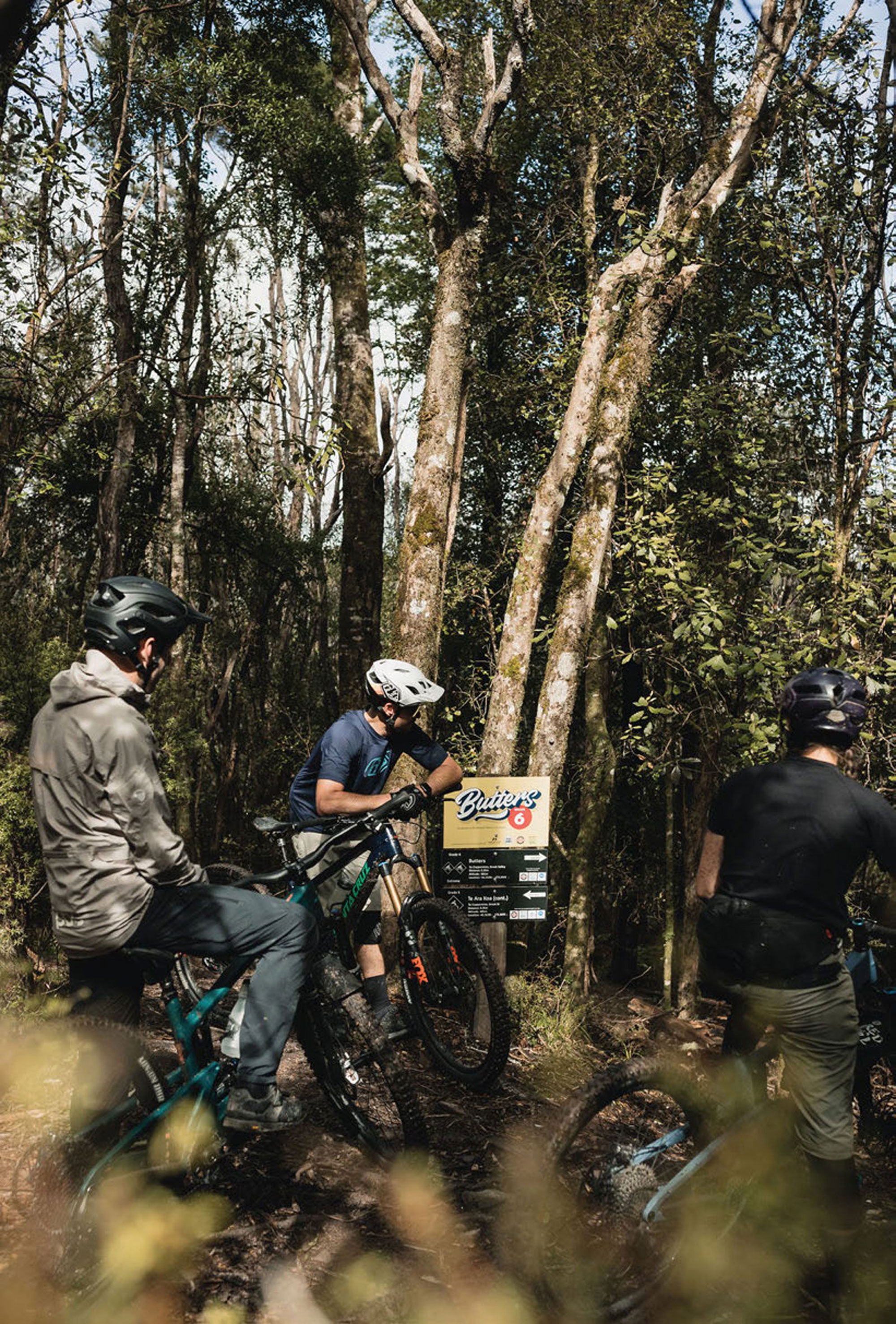

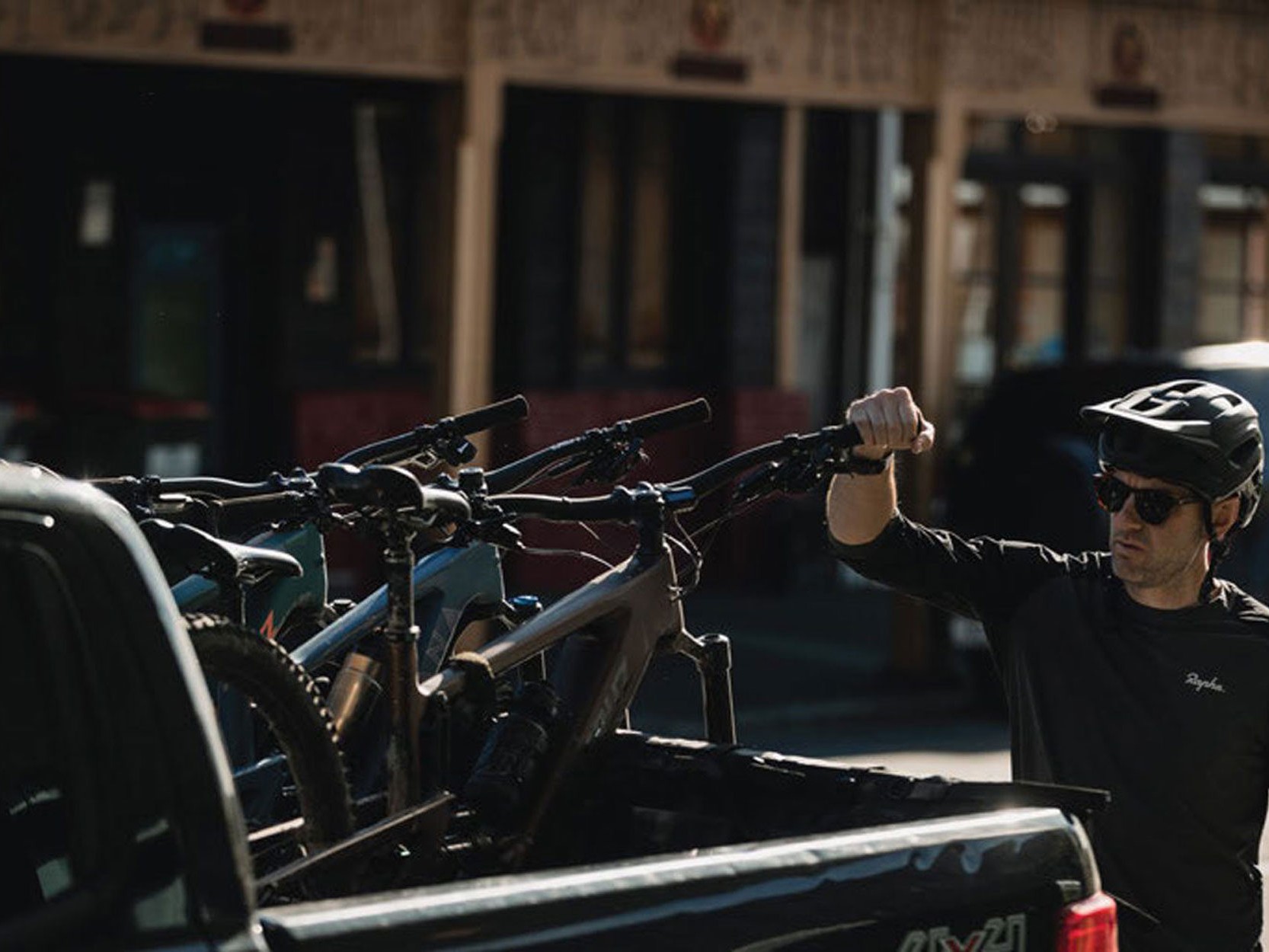
Come 2013, riding in the area was becoming increasingly Enduro-focused and, with an eye on what was happening in the discipline globally, the Nelson MTB Club grafted the Mammoth name onto a fresh -and epic -Enduro event. The Mammoth Enduro was born. With four hard stages – Codgers, Waahi, Takaaro, and Sharlands -no shuttles, and big liaisons, this is proper Enduro. The event has remained in this format since, with the addition of more stages and, on occasion, some shuttle assistance. The 2013 race attracted a host of local talent and set the tone for Mammoth’s to come. The longest of the four race stages ended up being just shy of 18 minutes for the eventual winner –local legend and trail builder, Kurt Lancaster who by race end stood atop the men’s podium. Meg Bichard showed her pace by being the fastest woman and showed the class which took her to compete in some of the world’s toughest Enduros.
By 2016, Mammoth had earned its title as the most demanding Enduro race in the country, with then three-to-six-minute long stages across two days. Taking the start line were a host of the country’s top riders, many of whom had spent seasons racing internationally. Justin Leov (former EWS and DH Pro) battled local downhiller, Kieran Bennett (ex-international DH rider) for the win. Bennett eventually took the victory by just five seconds. Loui Harvey was just 30-odd seconds back in third place. The women’s field traded blows over the weekend and, eventually, 90 seconds separated the top four: Meggie Bichard, Anja McDonald, Sasha Smith and Amanda Pearce – testament that Nelson had attracted a strong and competitive field.
By 2021, the EWS was in full swing around the globe, and NZ boasted a handful of leading Enduro talent, some of whom call Nelson home. NMTBC had put in a successful bid to host an EWS round in 2021, and 2020’s Mammoth was pegged as a qualifier round and warm-up of sorts for the following year’s big event. The race attracted the who’s-who of New Zealand Enduro. Names such as Eddie Masters, Charlie Murray, Rae Morrison and Cole Lucas lined up against a host of local talent and keen riders from all over NZ. One savvy racer had stashed a six-pack under the bridge at the base of 629 during practice, providing a welcome pit stop for a few riders mid-way through the sweltering race day.
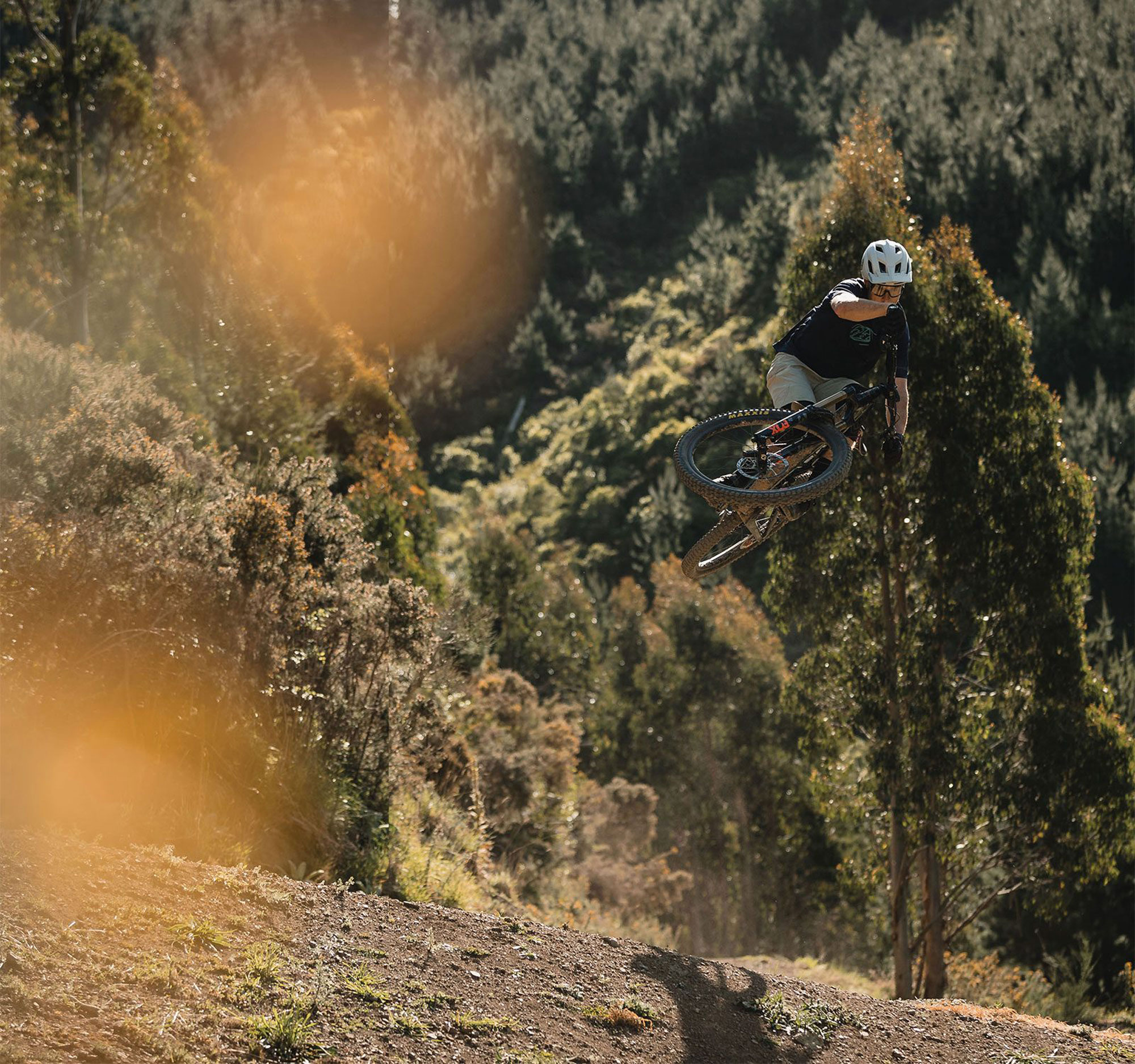
“COME 2013, RIDING IN THE AREA WAS BECOMING INCREASINGLY ENDURO-FOCUSED AND, WITH AN EYE ON WHAT WAS HAPPENING IN THE DISCIPLINE GLOBALLY, THE NELSON MTB CLUB GRAFTED THE MAMMOTH NAME ONTO A FRESH - AND EPIC - ENDURO EVENT. THE MAMMOTH ENDURO WAS BORN.”
Old mate Covid-19 ruined the party, putting an end to the club’s 2021 EWS dream, leaving months of planning scrapped. Even after a reschedule, multiple factors have meant Nelson’s EWS hopes have faded for the time being. Fortunately, NMTBC resurrected the Mammoth for 2022. Run under the Covid-19 framework, the event was restricted to just 100 riders. A scroll through the results confirms the event again attracted most of NZ’s heavy-hitting Enduro racers to its legendary course. Covid restrictions couldn’t kill rider’s enthusiasm for an epic couple of days racing. After coming through a turbulent, and somewhat disjointed, few years with their events and Covid now well and truly in the rearview, the NMTBC is working on a plan to alternate Enduro events yearly between the Mammoth and its little sibling, the Aorere Enduro. The Aorere will have fewer stages and friendlier liaisons, making it the ideal stepping stone to the Mammoth.
Reminiscing on the event’s history got us hyped to sample some of the trails previously raced, so we hopped on a shuttle with Gravity Nelson to the top of Te Ara Koa, Fringed Hill, to ride the now famous “Butters” – a trail 2.2km long that drops some 500+ vertical metres. Named in memory of Nelson MTB Club Member, Bernard “Butters” Simmonds, the trail opened in 2021 and quickly became a favourite of locals, and now sits in lore alongside legendary trails like 629, Peaking Ridge, and Whaimana. Butters was built with assistance from the Santa Cruz Bicycles ‘Pay Dirt’ fund’, which gave an injection of funds to help get the build done. Off the back of this, Hyperformance Hardware, Santa Cruz NZ’s distributor, have committed to help keep the good times rolling by assisting in funding maintenance of the trail for the coming years. Morning mist clung to the trees as we dropped into Butters, with the overnight rain making the roots slippery to begin with. A few mellow turns to adapt to the greasy conditions and we picked our way through the off-cambered corners up top, avoiding the Black Snakes (roots) which were trying to take our wheels out from under us. As the gradient tipped, the fun just increased as a few rocky drops and chutes were interspersed with amazing flowing turns and floaty jumps. Lower on the hill, we broke loose of the fog and popped out into a blue sky day; the trail was dry and we made the most of the benched-in traverses between the lower steep dropping turns. These are what give Butters its Grade 6 rating; most of the trail is realistically Grade 5, aside from a few crux points or steep sections, so keep your wits about you – speed under control and the trail is more than manageable.
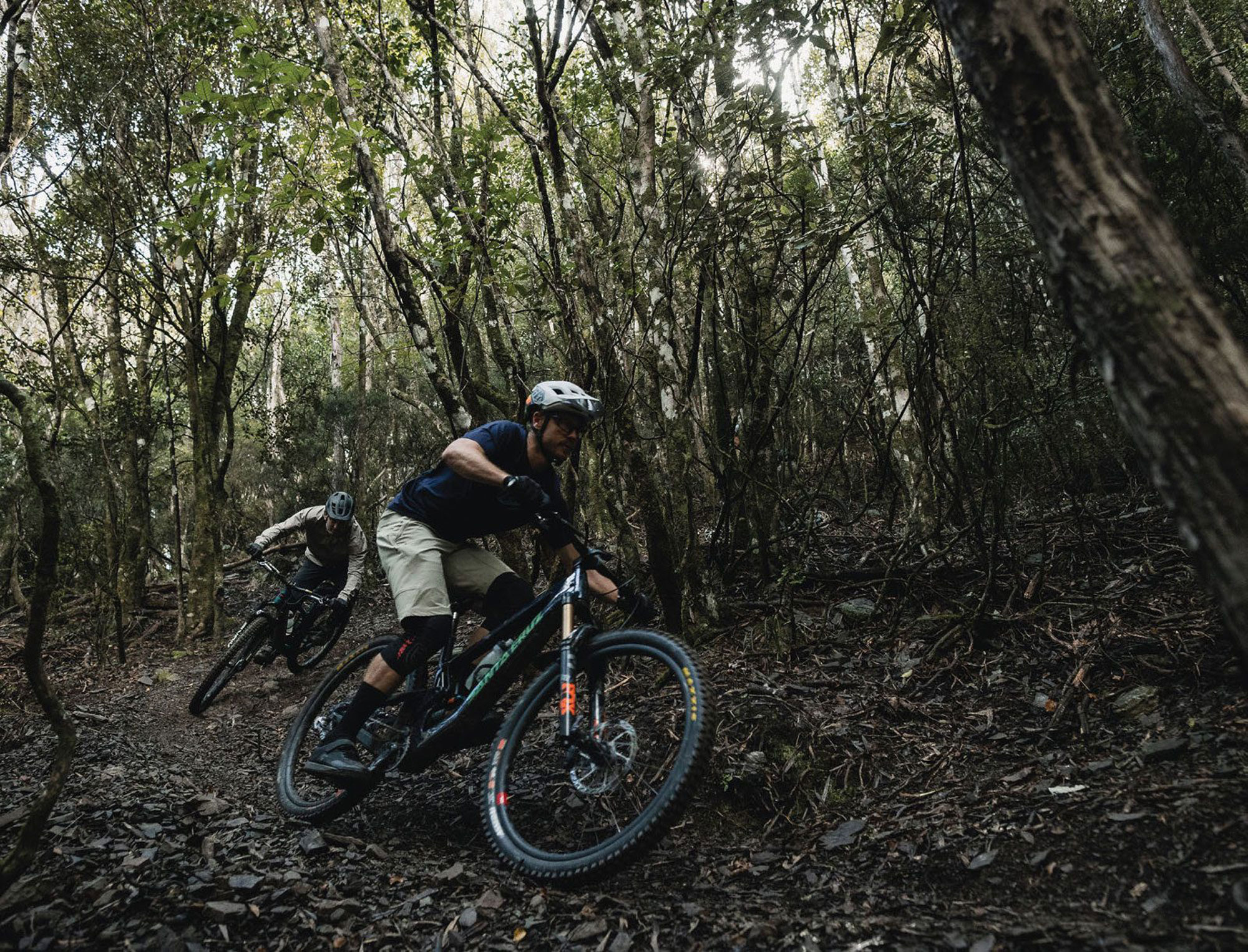
A quick pedal back to town and we headed for Tozetti, a local bakery-turned-cafe. All manner of ‘cabinet’ style treats were available, as well as an extensive menu. After re-caffeinating and a hearty lunch, we turned out sights for Te Ara Rere o Koata (Koata Rere) – “The flight path of Koata” -Nelson’s latest jump trail. Constructed by Queenstown’s jump-building experts, Elevate Trail Building, the 1.4km long trail features expertly sculpted jumps and berms of varying size and shape the entire way down. Most hits on the main line are rollable and multiple larger non-rollable side hits make this jump line perfect for anyone looking for air time. The trail likely won’t appear in a race any time soon, but it’s certainly worth cutting some laps if you’re in town for a few days.
After we realised our whips were weak and we’d exhausted our air miles, we headed for Two Thumb Brewing, hoping to spend the evening dining in the sun while sipping some fine brews. Unfortunately, it wasn’t to be, as they weren’t open on Mondays. On to Plan B. A short walk later we arrived at The Freehouse, a destination with a massive array of craft beer and simple food. If you know your Nelson Sauvin from your Citra, or your Weizenbier from your Gose, or you’re just keen to try something different, head for this converted chapel – it’s certainly one to put on your must-do list when in the area.
The next morning, after a solid feed and perfect coffee at Victus, we walked across the road to Gravity Nelson, loaded the shuttle and headed up for a lap of ‘629’. As we drove through the Maitai Valley, I checked the Trailforks app to see where we were headed and was astounded by how many trails were nearby. Within a 15-minute drive of the city centre there are a huge number of trails, many of them Grade 4, 5 and 6, yet when you’re riding them you feel like you could be deep in the backcountry somewhere. I’m positive there’s no other city in NZ with this volume of lengthy technical descents so close to town – so close in fact that from some you can roll with barely a pedal stroke from the bottom of the trail straight to the pub for après.
NUMBER OF STAGES: EIGHT 2020
“BY 2016, MAMMOTH HAD EARNED ITS TITLE AS THE MOST DEMANDING ENDURO RACE IN THE COUNTRY, WITH THEN THREE-TO-SIX-MINUTE LONG STAGES ACROSS TWO DAYS.
TAKING THE START LINE WERE A HOST OF THE COUNTRY’S TOP RIDERS, MANY OF WHOM HAD SPENT SEASONS RACING INTERNATIONALLY.”
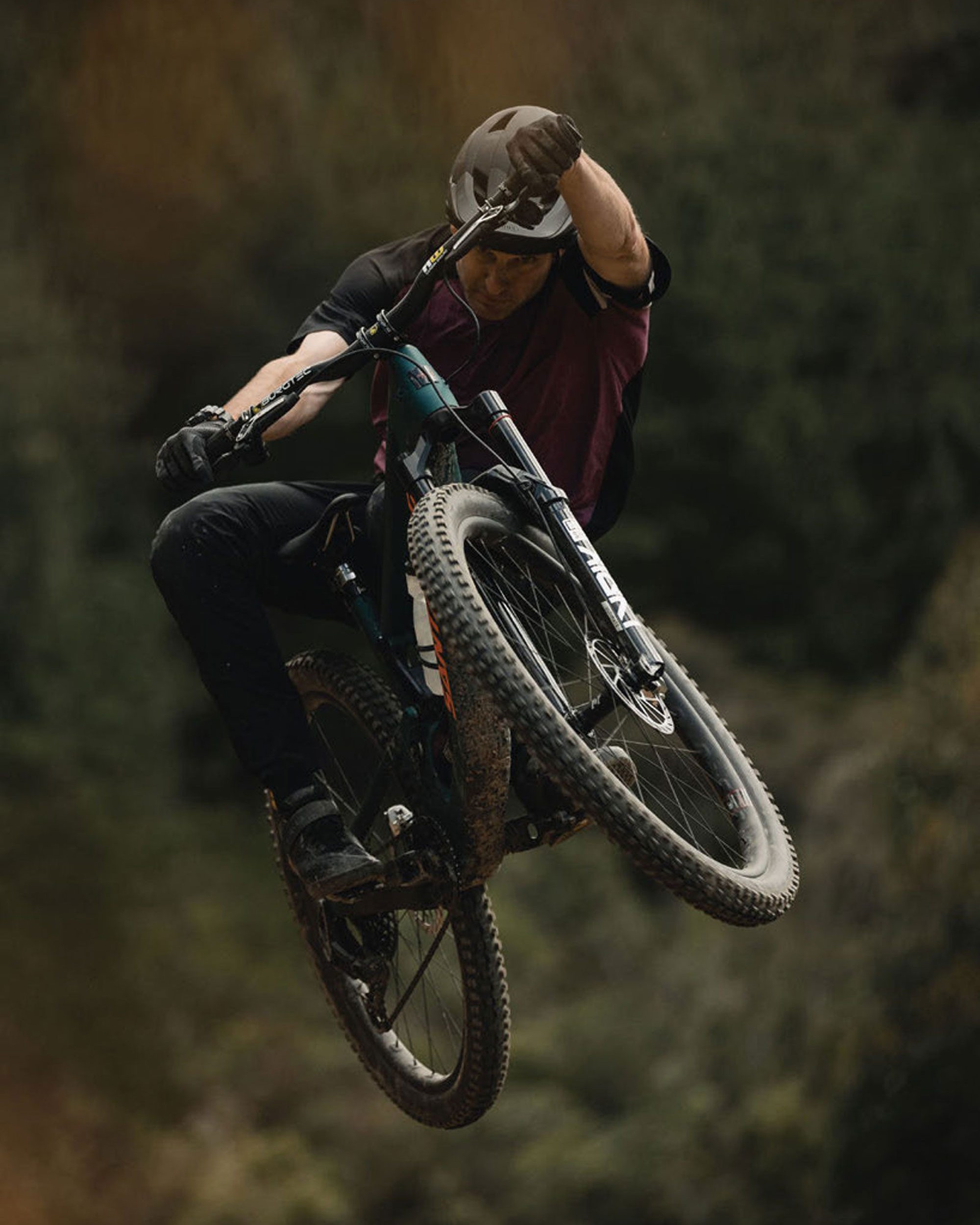
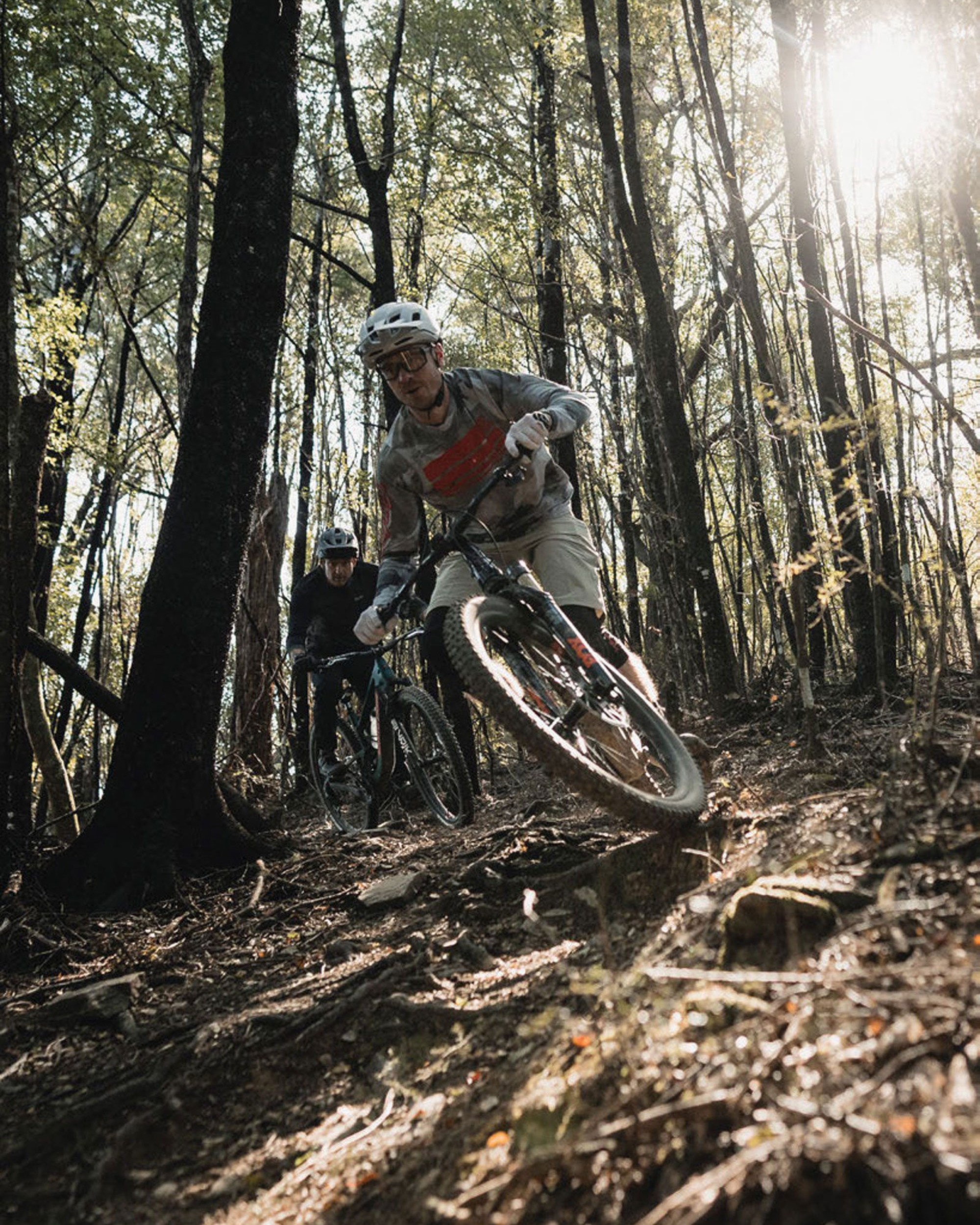
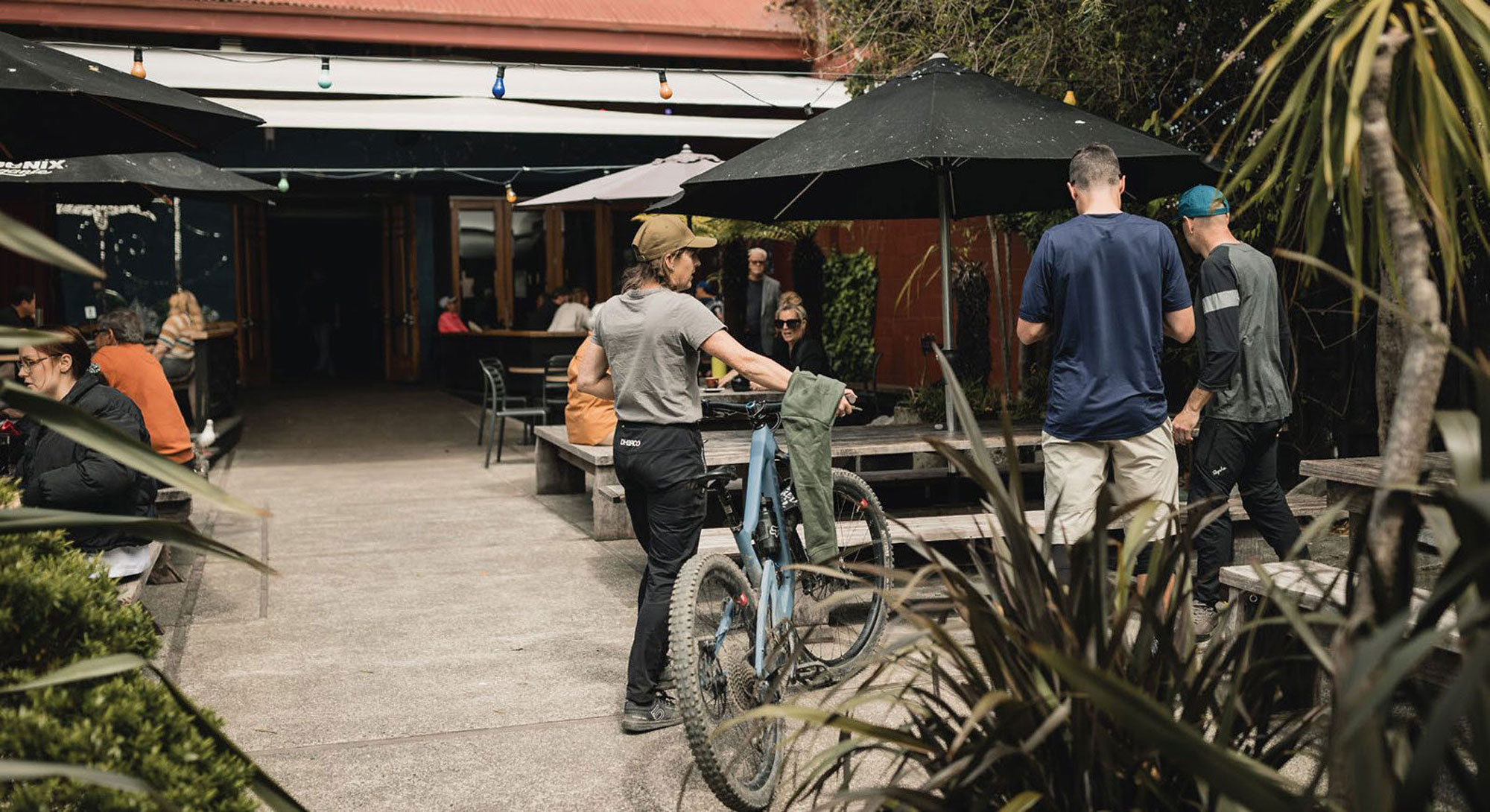
From the peak of the access road, ‘629’ drops into the bush and it’s “game on”. After just a couple of turns, you’re over some roots and straight into steep, loose sections – it’s spicy no doubt. Fortunately, just like Butters, the few crux moves are broken up by some mellow sections, allowing you to recompose, let your arm pump subside, and prepare for the next stretch of tech. Again, several steep, dropping turns are key sections, although with catch berms where required – it’s all pretty achievable if you keep a lid on your speed; release the brakes and things can quickly get buck-wild! Lower down, under pines, the trail mellows out for a period, and some fun flow takes over before dropping through native once again, eventually spitting you out on the banks of the Maitai River, a perfect spot to get your cramping arms working again with a mid-ride dip – ideal after the 524 vertical meters you just dropped.
Riding from 629 back out the valley, we came to Amanda’s car. She cracked the boot and produced a chilly bin full of ice with some of Two Thumb Brewing’s finest nestled inside – a hoppy IPA brewed with ingredients grown not far from Nelson’s famed trails. For something a bit less intense, Two Thumb has brewed a beer specially for the NMTBC; ‘Single Track’ is a session IPA available at Two Thumb Nelson, perfect by the glass for a post-ride chill – or you can take some home in a rigger for later… maybe both?! For every pint poured, Two Thumb donates to the Nelson MTB Club, how good! We park up beside the river to enjoy our beer and reminisce on just how damn good the trails we’ve ridden are – we’ve not even scratched the surface of the area but the stoke is high!
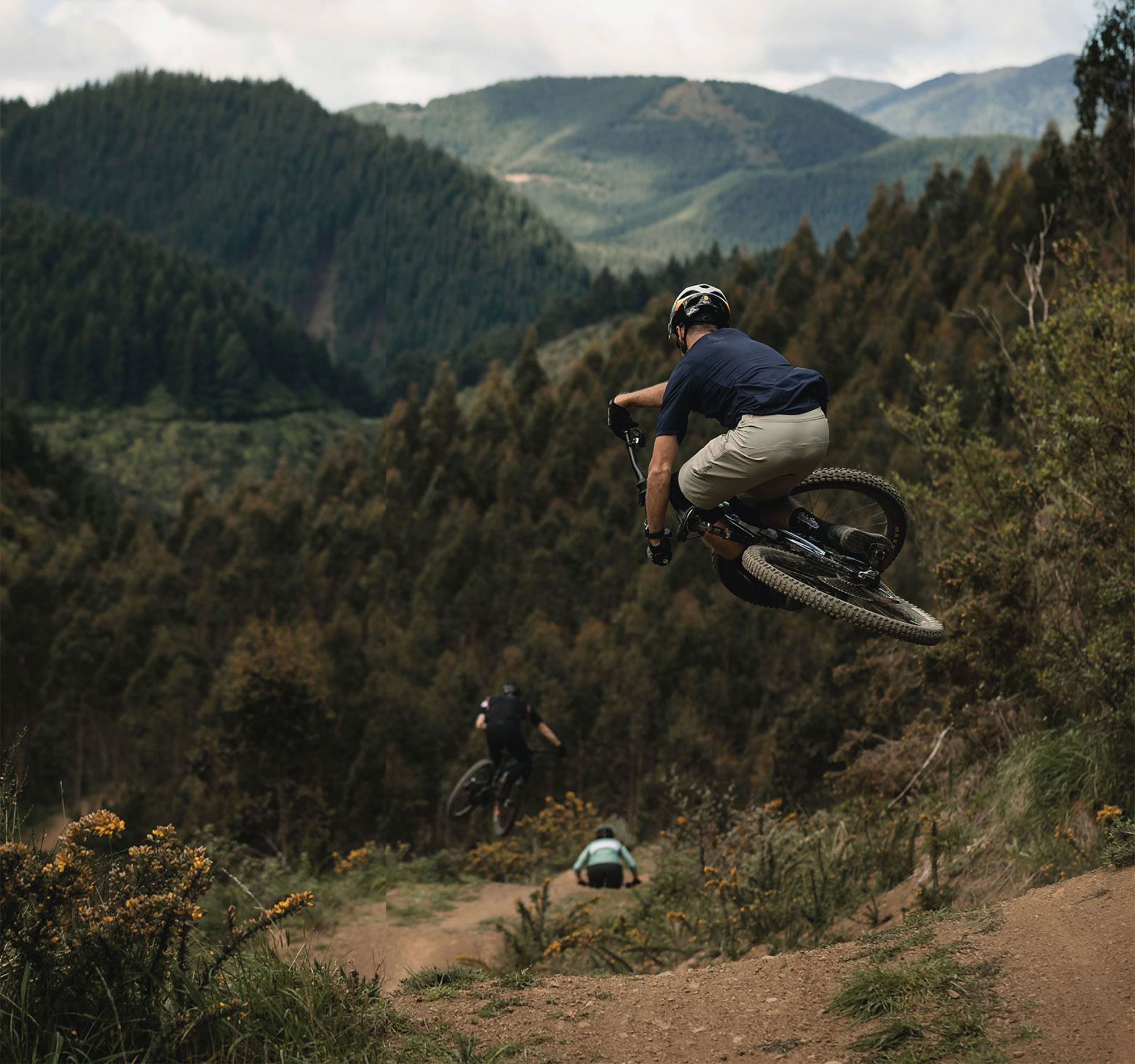
Nelson’s technical trails are a great way to stretch your ability and force you out of your comfort zone, ultimately making you a better rider. Thanks to smart trail building, the reality is that provided you’re in control and on course, most of the technical sections are doable given some caution and knowing your limits. There are two things to leave at home before riding some of these trails for the first time, though: ego and pride. Both could see you take a spill you could have otherwise avoided. Ride within your limits and don’t be too proud to walk a section if need be.
NMTBC is full of passionate people who run a slick operation, and their events always attract a tonne of locals but also a whole host of riders from around NZ who come to sample some epic racing and enjoy the town. Many come days early, or stay on after the event to ride what are truly some of NZ’s best trails in one of the most chilled towns in the country. Whether you’re gunning for the podium, or happy to just make it around the course, NMTBC events are always a great time both on and off the bike. Their event villages are hard to beat, and with quality food and coffee on offer the post-race vibes are always high, really adding to the community feel of the event.
For now, the Mammoth ‘24 course is filed away in the minds of a select few Nelson Mountain Bike Club committee members but, one thing’s for sure, they plan to uphold the legend of the Mammoth Enduro.
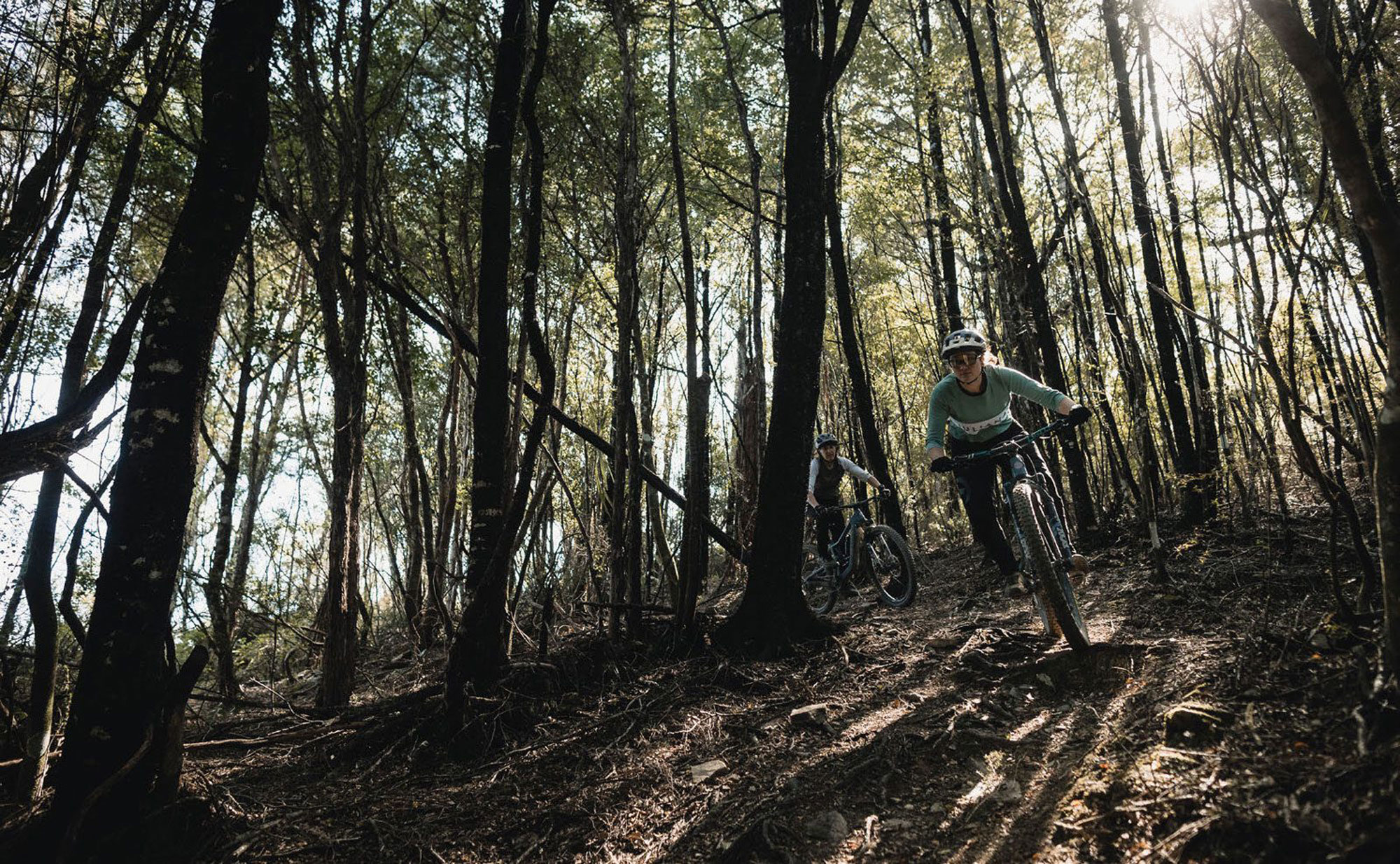
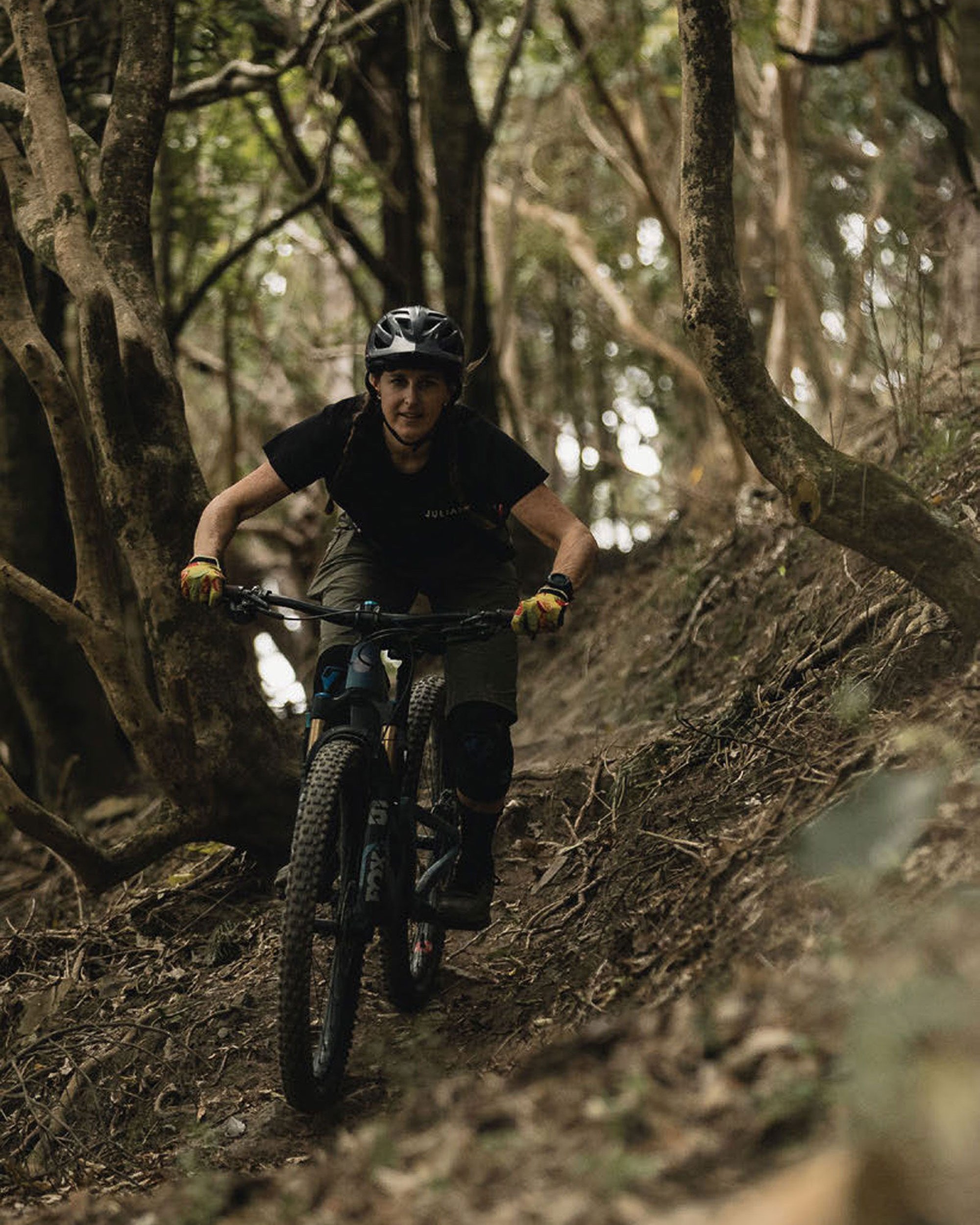
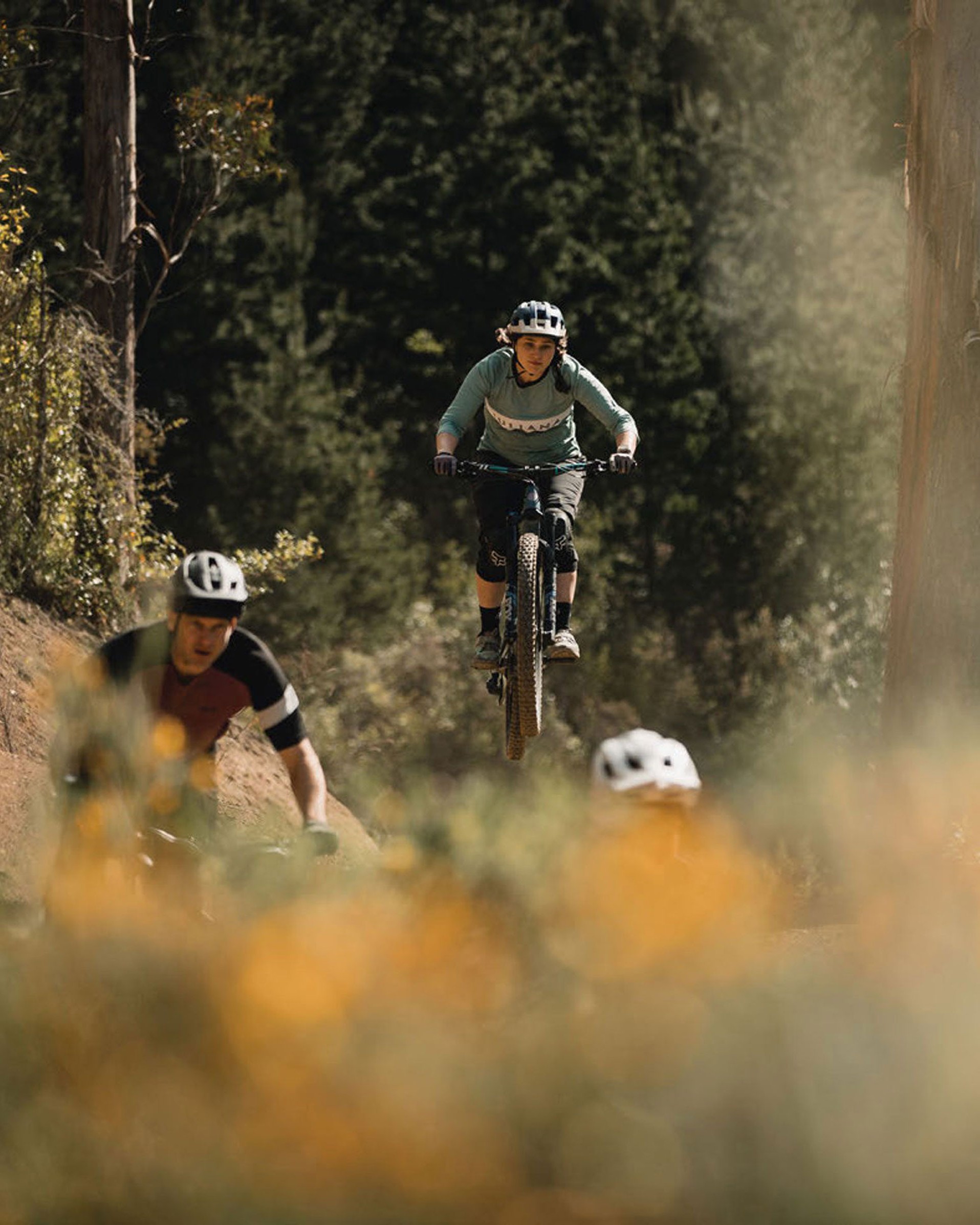
METERS OF DESCENDING: 1500+ 2022
